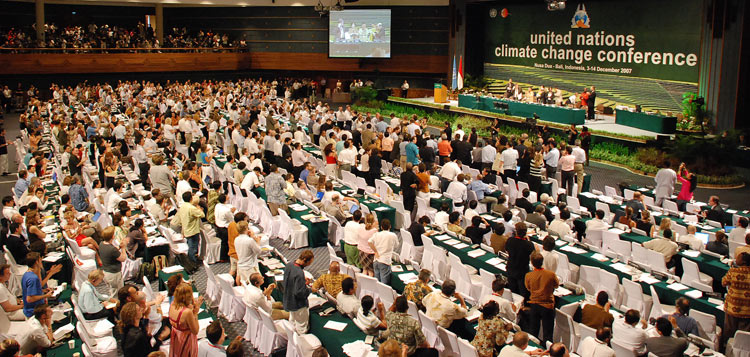Please email your comments & questions to geovisual @ comcast.net. Thank you.
Click here to join Friends of Peace Monuments.
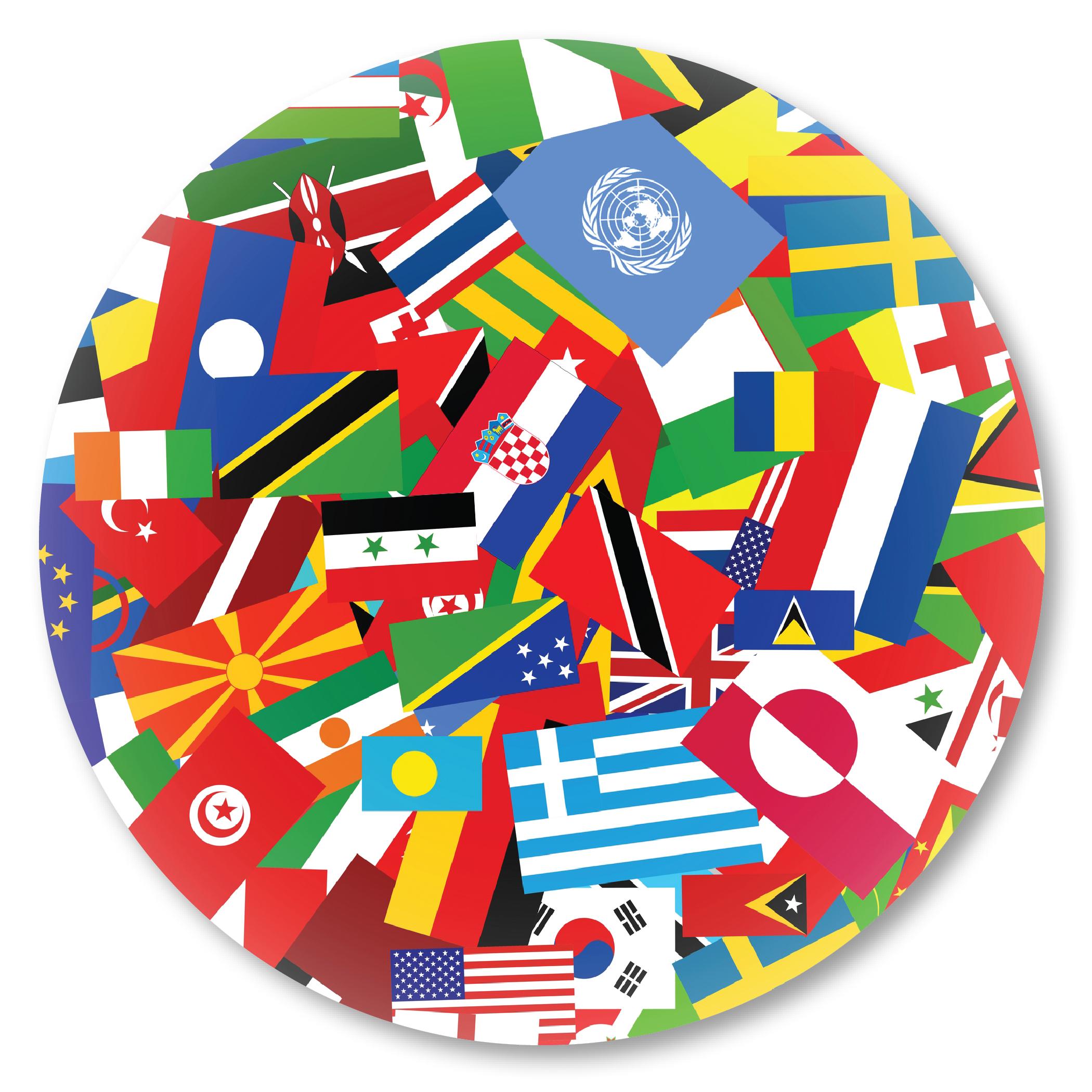

| More than 150 International Peace Conferences
over the years |


| 1931 - An excellent book (one of the first) on the international peace movement 1815-1914 is A.C.F. Beales, "The history of peace: A short account of the organised movement for international peace," The Dial Press, New York, pp. 355.
| 

| 1991 - Equally excellent and covering much the same ground, but using more archival materials, and with new perspectives, is Sandi E. Cooper, "Patriotic pacifism: Waging war on war in Europe, 1815-1914."
|
This web page was compiled (beginning in September 2010) to learn about the international peace conferences of the late 19th and early 20th centuries. Most of the information presented below was obtained from the World Wide Web and is therefore incomplete, and many conferences have undoubtedly been omitted altogether. Since this is a website devoted to peace monuments, an extra effort was made to identify the halls in which the conferences took place and any plaques, museums, and other monuments which have been constructed to preserve the memory of these historic peace conferences.
Here are some conclusions which emerge from the information presented below:
-- International peace conferences were a common feature of the "peace movement" for almost exactly one century, from 1843 until World War II. During this period, there were more than 75 international conferences. 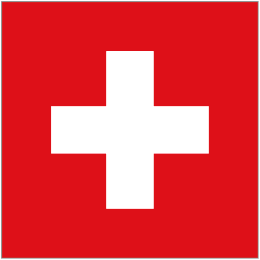 Switzerland emerged as the primary conference venue (at least 14 conferences), followed by the
Switzerland emerged as the primary conference venue (at least 14 conferences), followed by the  United Kingdom (13), the
United Kingdom (13), the  United States (12),
United States (12),  France (10),
France (10),  Netherlands (9),
Netherlands (9),  Belgium (5), and
Belgium (5), and 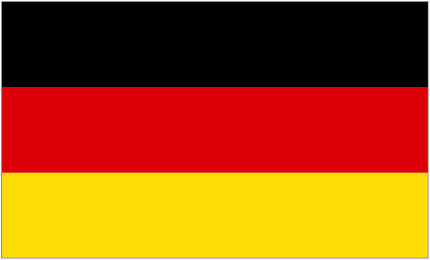 Germany (5).
Germany (5).
--- The history of the conferences reflects the ups and downs of various peace organizations, e.g. New York Peace Society, American Peace Society, the Peace Society (of UK), International Workers Association, International Arbitration & Peace Association, Universal Peace Union, Inter-Parliamentary Union, International Peace Bureau, Fellowship of Reconciliation, Women's Peace Party, Women's International League for Friendship & Peace. etc.
-- Peace conferences brought together many peacemakers on whom the Nobel Committee bestowed the Nobel Peace Prize --
 Henri Durant (1901) |
Henri Durant (1901) |
 Frédéric Passy (1901) |
Frédéric Passy (1901) |  Charles Albert Gobat (1902) |
Charles Albert Gobat (1902) |
 Élie Ducommun (1902) |
Élie Ducommun (1902) |
 William Randal Cremer (1903) |
William Randal Cremer (1903) |
 Bertha von Suttner (1905) |
Bertha von Suttner (1905) |
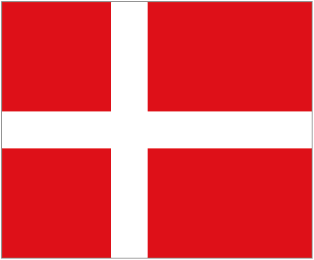 Fredrik Bajer (1908) |
Fredrik Bajer (1908) |
 Auguste Beernaert (1909)|
Auguste Beernaert (1909)|
 Paul-Henri-Benjamin d'Estournelles de Constant (1909) |
Paul-Henri-Benjamin d'Estournelles de Constant (1909) |
 Tobias Asser (1911) |
Tobias Asser (1911) |
 Alfred Hermann Fried (1911) |
Alfred Hermann Fried (1911) |
 Elihu Root (1912) |
Elihu Root (1912) |
 Henri La Fontaine (1913) |
Henri La Fontaine (1913) |
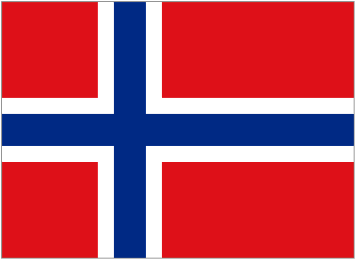 Christian Lange (1921) |
Christian Lange (1921) |
 Austen Chamberlain (1925) |
Austen Chamberlain (1925) |
 Aristide Briand (1926) |
Aristide Briand (1926) |
 Gustav Stresemann (1926) |
Gustav Stresemann (1926) |
 Ferdinand Buisson (1927) |
Ferdinand Buisson (1927) |
 Frank Kellogg (1929) |
Frank Kellogg (1929) |
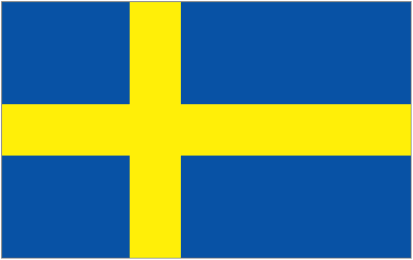 Nathan Söderblom (1930) |
Nathan Söderblom (1930) |
 Jane Addams (1931) |
Jane Addams (1931) |  Nicholas Murray Butler (1931) |
Nicholas Murray Butler (1931) |
 Cordell Hull (1945) |
Cordell Hull (1945) |  Emily Greene Balch (1946) |
Emily Greene Balch (1946) |
 John R. Mott (1946).
John R. Mott (1946).
(Click here for a longer list of peacemakers who attended peace conferences in the 19th century & early 20th century.)
-- Peace conferences tried to end war -- and to stop impending wars. Wealthy men (e.g. Henry Ford & Andrew Carnegie) invested in peace conferences to stop
World War I. But all attempts failed, and each World War brought an end to most pre-war conferences and peace organizations.
-- Peace conferences nevertheless created a general appreciation of international cooperation, the principle of international arbitration was established, and some specific organizations were created, e.g. the Red Cross in 1864 and the International Olympic Committee in 1894.
-- Gradually peace conferences organized by private citizens and voluntary organizations gave way to official peace conferencess organized by governments and attended by accredited diplomats. The First Geneva Convention was signed in 1864, the first international organization (the Permanent Court of Arbitration) was created in 1899, the League of Nations resulted from the Treaty of Versailles in 1920, and the United Nations replaced the League in 1945.
-- Since World War II, there has been a plethora of so-called peace conferences, congresses, and festivals (and of official government conferences), but very few privately organized peace conferences have been able to sustain themselves for more than a few years. One exception is the Pugwash Conference on Science & World Affairs which began in 1957 and still meets annually.
-- Today's peace movement has no international structure under which anything like the "universal" peace conferences of the 19th and early 20th centuries could be organized.
-- Aside from some of the halls in which peace conference took place (and three museums in Switzerland), very few monuments were created to perputuate the memory of peace conferences. This is perhaps due to the fact that peace conferences, as a whole, did not live up to their own aspirations.
See the following on-line sources of information:
"Peace Congress," Wikipedia article. | "Peace Congresses," by Walter George Smith in the Catholic Encyclopedia (1913).
"Gustave Moynier and the peace societies" by André Durand,
Intl. Review of the Red Cross, 31-10-1996, no 314, pp. 532-550.
"An Exhibit of Photographs of Leaders & Supporters of the American Peace Society" from the Swarthmore College Peace Collection.
"A Century of Nobel Peace Laureates, 1901-2005: From Peace Movement to the United Nations" from League of Nations Archives & Indiana University.
"Conference Tables in History" from Stoneline Designs Conference Table Blog.
"Monuments Related to World Federalism and/or World Goverment" on this web site.
"100 Years of Peace making: A history of the International Peace Bureau and other international peace movement organisations and networks" by Rainer Santi, Pax förlag, International Peace Bureau (IPB), Geneva (Switzerland), January 1991.
Beales, A.F.C. (1931), "The History of Peace: A Short Account of the Organized Movements for International Peace," G. Bell, London (1931).
Click here for monuments related to peace treaties. | Click here for UN monuments. | Click here for world federalism. | Click here for individual peacemakers, including all Nobel Peace Prize laureates.
Right click image to enlarge.
 May 22, 1787 - Society for Effecting the Abolition of the Slave Trade, London (England). Also called Society for the Abolition of the Slave Trade. Founded by abolitionist Thomas Clarkson [1760-1846] & others.
"These wars left 2,100,000 dead. Local peace societies (part of a liberal movement for human rights, social improvements, free trade, abolition of slavery & an end to war) start to appear when the Napoleonic wars finally end in 1815. The US & UK societies were initially inspired by religious and moral considerations, under the influence of the Quakers' principles of non-violence. Differences of opinion soon emerged, however, between those who believed in all-out pacifism and those who did not reject defensive warfare.
The ethical pacifism of these first societies was later strengthened by ideas emanating from France which saw international law as an alternative to wars and as a way to solve international conflicts."
-- From Santi (1991) & André Durand (1996). May 22, 1787 - Society for Effecting the Abolition of the Slave Trade, London (England). Also called Society for the Abolition of the Slave Trade. Founded by abolitionist Thomas Clarkson [1760-1846] & others.
"These wars left 2,100,000 dead. Local peace societies (part of a liberal movement for human rights, social improvements, free trade, abolition of slavery & an end to war) start to appear when the Napoleonic wars finally end in 1815. The US & UK societies were initially inspired by religious and moral considerations, under the influence of the Quakers' principles of non-violence. Differences of opinion soon emerged, however, between those who believed in all-out pacifism and those who did not reject defensive warfare.
The ethical pacifism of these first societies was later strengthened by ideas emanating from France which saw international law as an alternative to wars and as a way to solve international conflicts."
-- From Santi (1991) & André Durand (1996).
 |  April 11, 1814 -
"The Treaty of Fontainebleau was established in Fontainebleau (France) between Napoleon I [1769-1821] & representatives from the Austrian Empire, Russia & Prussia. It was signed in Paris on 11 April, by the plenipotentiaries of both sides & ratified by Napoleon on 13 April. With this treaty, the allies ended Napoleon's rule as emperor of France and sent him into exile on Elba." /// "Napoleon's initial defeat [was] the short-lived peace proclaimed on 27 June 1814 when Napoleon was imprisoned on Elba. The peace was celebrated in Paris, but [King George IV] the Prince Regent [1762-1830] invited the allied sovereigns to continue their celebrations in England. The offer was enthusiastically taken up. June 1814 must have been the only time in Oxford's history when it hosted an emperor, a king, four future kings, a chancellor of the Austrian empire, two future and two past British prime ministers, many world-famous generals, and enough peers to burst the House of Lords... And one of the things they wanted to do was to visit the famous university town of Oxford, one of the very few places in the country, incidentally, where the Prince Regent could rely on a warm welcome. At the prospect, 'every heart fluttered with expectation and delight.'" --
From "Big Junket" by Christopher Danziger (2015). April 11, 1814 -
"The Treaty of Fontainebleau was established in Fontainebleau (France) between Napoleon I [1769-1821] & representatives from the Austrian Empire, Russia & Prussia. It was signed in Paris on 11 April, by the plenipotentiaries of both sides & ratified by Napoleon on 13 April. With this treaty, the allies ended Napoleon's rule as emperor of France and sent him into exile on Elba." /// "Napoleon's initial defeat [was] the short-lived peace proclaimed on 27 June 1814 when Napoleon was imprisoned on Elba. The peace was celebrated in Paris, but [King George IV] the Prince Regent [1762-1830] invited the allied sovereigns to continue their celebrations in England. The offer was enthusiastically taken up. June 1814 must have been the only time in Oxford's history when it hosted an emperor, a king, four future kings, a chancellor of the Austrian empire, two future and two past British prime ministers, many world-famous generals, and enough peers to burst the House of Lords... And one of the things they wanted to do was to visit the famous university town of Oxford, one of the very few places in the country, incidentally, where the Prince Regent could rely on a warm welcome. At the prospect, 'every heart fluttered with expectation and delight.'" --
From "Big Junket" by Christopher Danziger (2015).
| Thus Oxford played a unique role in the Peace of 1814, and its two modest 1814 peace monuments -- see below -- have quietly marked this momentous event for over 200 years.
This puts the two Oxford monuments among the earliest examples of "peace monuments" anywhere & makes them contemporaries of the Stoodley Pike Monument in West Yorkshire (qv).
|

 |  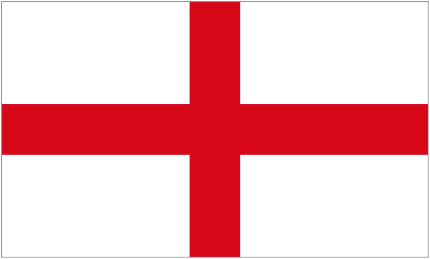 1814 - Peace Stone, Carfax, Oxford (England). Inscribed: "'PEACE
was proclaim’d In the CITY of OXFORD JUNE 1814.'
There is a more modern inscribed stone immediately below the peace stone, which adds no information whatsoever: 'THE STONE ABOVE COMMEMORATES THE PEACE OF 1814.'
In 1814 this peace stone was set in the north side of the tower of the original [11th century] medieval Church of St. Martin at Carfax. This church was in the centre of the City of Oxford where four roads meet, and it was also the City Church." 1814 - Peace Stone, Carfax, Oxford (England). Inscribed: "'PEACE
was proclaim’d In the CITY of OXFORD JUNE 1814.'
There is a more modern inscribed stone immediately below the peace stone, which adds no information whatsoever: 'THE STONE ABOVE COMMEMORATES THE PEACE OF 1814.'
In 1814 this peace stone was set in the north side of the tower of the original [11th century] medieval Church of St. Martin at Carfax. This church was in the centre of the City of Oxford where four roads meet, and it was also the City Church."
|


 |   1814 - Peace Stone, Plain Roundabout, Oxford (England). Now the pedestal of a street lamp. Inscribed "PEACE
was proclaimed in the City of OXFORD
JUNE 27 1814." The roundabout marked the eastern entrance to Oxford from the London direction in 1814 (St. Clement's was not taken into the city until 1835).
Information courtesy of Stephanie Jenkins & Tim Myatt. 1814 - Peace Stone, Plain Roundabout, Oxford (England). Now the pedestal of a street lamp. Inscribed "PEACE
was proclaimed in the City of OXFORD
JUNE 27 1814." The roundabout marked the eastern entrance to Oxford from the London direction in 1814 (St. Clement's was not taken into the city until 1835).
Information courtesy of Stephanie Jenkins & Tim Myatt.
|
 |   After 14 June 1814 - Vase of Siberian Jasper, Merton College, Oxford University, Oxford (England). Danziger's article also depicts a "vase of Siberian jasper sent to Merton College by Tsar Alexander I [1777-1825] & his sister Ekaterina Pavlovna [1788-1819] in thanks after lodging there [during the peace celebration] on the night of 14 June 1814." (This is similar to the vase [qv] given by Russia to the Peace Palace in The Hague 100 years later.) After 14 June 1814 - Vase of Siberian Jasper, Merton College, Oxford University, Oxford (England). Danziger's article also depicts a "vase of Siberian jasper sent to Merton College by Tsar Alexander I [1777-1825] & his sister Ekaterina Pavlovna [1788-1819] in thanks after lodging there [during the peace celebration] on the night of 14 June 1814." (This is similar to the vase [qv] given by Russia to the Peace Palace in The Hague 100 years later.) 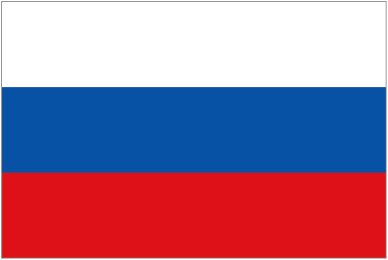
|
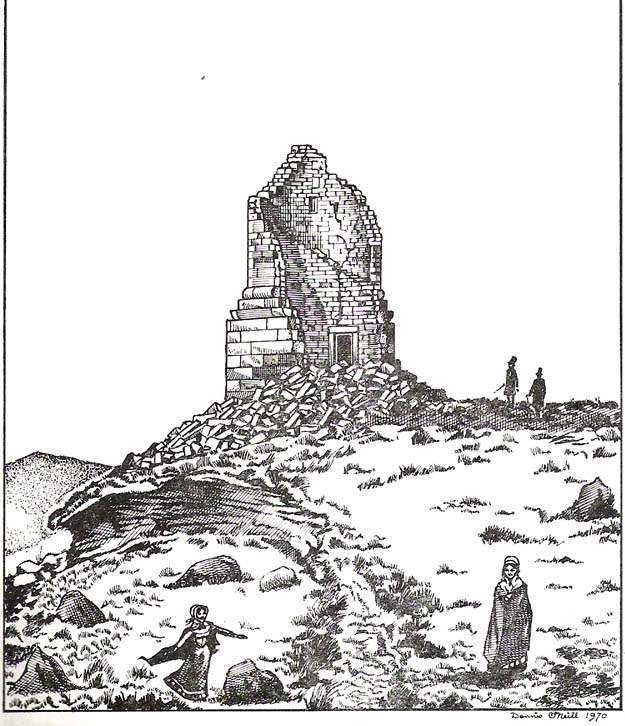

 |   1814-1854, 1856 - Stoodley Pike Monument, West Yorkshire (England). Stoodley Pike is a 1,300-foot (400 m) hill in the south Pennines, noted for the 121 foot Stoodley Pike Monument at its summit, which dominates the moors above Todmorden. Inscription above the entrance is worn & covered with lichen, but it is legible & reads: "Stoodley Pike. A beacon monument erected by public subscription commenced in 1814 to commemorate the surrender of Paris to the allies and finished after the Battle of Waterloo when peace was established in 1815. By a strange coincidence the pike [monument] fell on the day the Russian ambassador left London before the declaration of war with Russia in 1854. Was rebuilt when peace was restored in 1856." Info courtesy of Nick Wilding. 1814-1854, 1856 - Stoodley Pike Monument, West Yorkshire (England). Stoodley Pike is a 1,300-foot (400 m) hill in the south Pennines, noted for the 121 foot Stoodley Pike Monument at its summit, which dominates the moors above Todmorden. Inscription above the entrance is worn & covered with lichen, but it is legible & reads: "Stoodley Pike. A beacon monument erected by public subscription commenced in 1814 to commemorate the surrender of Paris to the allies and finished after the Battle of Waterloo when peace was established in 1815. By a strange coincidence the pike [monument] fell on the day the Russian ambassador left London before the declaration of war with Russia in 1854. Was rebuilt when peace was restored in 1856." Info courtesy of Nick Wilding.
|

|  September 1814-June 1815 - Congress of Vienna, Vienna (Austria). "A conference of ambassadors of European states chaired by Clemens Prince von Metternich [1773-1859]. Its objective was to settle the many issues arising from the French Revolutionary Wars, the Napoleonic Wars & the dissolution of the Holy Roman Empire. It resulted in the redrawing of the continent's political map, establishing the boundaries of France, the Duchy of Warsaw, the Netherlands, the states of the Rhine, the German province of Saxony & various Italian territories, & the creation of spheres of influence through which Austria, Britain, France & Russia brokered local & regional problems. It was the first of a series of international meetings that came to be known as the Concert of Europe, which was an attempt to forge a peaceful balance of power in Europe & which served as a model for later organizations such as the League of Nations & United Nations." /// Image is an 1815 painting by Parisian court painter Jean-Baptiste Isabey [1767–1855] who traveled to Vienna as part of the French delegation & executed portraits of each of the 23 congress participants. /// Among the meetings of the Great Powers during the "Age of Metternich" were: Aix-la-Chappelle (1818), Carlsbad (1819), Verona (1822), London (1832) & Berlin (1878). September 1814-June 1815 - Congress of Vienna, Vienna (Austria). "A conference of ambassadors of European states chaired by Clemens Prince von Metternich [1773-1859]. Its objective was to settle the many issues arising from the French Revolutionary Wars, the Napoleonic Wars & the dissolution of the Holy Roman Empire. It resulted in the redrawing of the continent's political map, establishing the boundaries of France, the Duchy of Warsaw, the Netherlands, the states of the Rhine, the German province of Saxony & various Italian territories, & the creation of spheres of influence through which Austria, Britain, France & Russia brokered local & regional problems. It was the first of a series of international meetings that came to be known as the Concert of Europe, which was an attempt to forge a peaceful balance of power in Europe & which served as a model for later organizations such as the League of Nations & United Nations." /// Image is an 1815 painting by Parisian court painter Jean-Baptiste Isabey [1767–1855] who traveled to Vienna as part of the French delegation & executed portraits of each of the 23 congress participants. /// Among the meetings of the Great Powers during the "Age of Metternich" were: Aix-la-Chappelle (1818), Carlsbad (1819), Verona (1822), London (1832) & Berlin (1878).
|
  1815-1828 - First incarnation of the New York Peace Society. "The first peace society to be established in the USA.
David Low Dodge [1774-1852] founds the society in 1815, soon after the end of the War of 1812. It became an active organization, holding regular weekly meetings & producing literature which is spread as far as Gibraltar & Malta, describing the horrors of war & advocating pacificism on Christian grounds. The society will have four different incarnations, as it has merged into other organizations or dissolved & then been re-created." See 1828 below. 1815-1828 - First incarnation of the New York Peace Society. "The first peace society to be established in the USA.
David Low Dodge [1774-1852] founds the society in 1815, soon after the end of the War of 1812. It became an active organization, holding regular weekly meetings & producing literature which is spread as far as Gibraltar & Malta, describing the horrors of war & advocating pacificism on Christian grounds. The society will have four different incarnations, as it has merged into other organizations or dissolved & then been re-created." See 1828 below.
  1815 - New York, New York (USA). "Élie Ducommun credited the establishment of the first Peace Society in New York in 1815, and the concept quickly spread to Europe." David Low Dodge [1774-1852] founded the New York Peace Society in 1815, soon after the end of the War of 1812 [1812-15]. It became an active organization, holding regular weekly meetings, and producing literature which was spread as far as Gibraltar & Malta, describing the horrors of war & advocating pacificism on Christian grounds.
In 1828, the New York society merged with others in New Hampshire, Maine & Massachusetts to form the American Peace Society. 1815 - New York, New York (USA). "Élie Ducommun credited the establishment of the first Peace Society in New York in 1815, and the concept quickly spread to Europe." David Low Dodge [1774-1852] founded the New York Peace Society in 1815, soon after the end of the War of 1812 [1812-15]. It became an active organization, holding regular weekly meetings, and producing literature which was spread as far as Gibraltar & Malta, describing the horrors of war & advocating pacificism on Christian grounds.
In 1828, the New York society merged with others in New Hampshire, Maine & Massachusetts to form the American Peace Society.
|

| H
O
U
S
E |   1911-1948 - American Peace Society House, 734 Jackson Place, NW, Washington, DC (USA). A Late Victorian 3-story brick house with a hexagonal bay that was the headquarters of the American Peace Society from 1911 to 1948. Constructed in 1878 for financier & philanthropist Charles C. Glover [1846-1936]. Declared a National Historic Landmark in 1974. Included in the Lafayette Square Historic District. Currently used as offices for the White House Council on Environmental Quality. The American Peace Society was founded in 1828 and moved to Washington from Boston in 1911. What happened in 1948? (Stephen Norman [1918-1946], last descendant of Theodor Herzl [1860-1904], jumped off the Charles C. Glover Memorial Bridge three weeks after learning that his parents had died in the Holocaust.) 1911-1948 - American Peace Society House, 734 Jackson Place, NW, Washington, DC (USA). A Late Victorian 3-story brick house with a hexagonal bay that was the headquarters of the American Peace Society from 1911 to 1948. Constructed in 1878 for financier & philanthropist Charles C. Glover [1846-1936]. Declared a National Historic Landmark in 1974. Included in the Lafayette Square Historic District. Currently used as offices for the White House Council on Environmental Quality. The American Peace Society was founded in 1828 and moved to Washington from Boston in 1911. What happened in 1948? (Stephen Norman [1918-1946], last descendant of Theodor Herzl [1860-1904], jumped off the Charles C. Glover Memorial Bridge three weeks after learning that his parents had died in the Holocaust.)
|

|   June 14, 1816 - London (England). Society for the Promotion of Permanent & Universal Peace -- better known as the London Peace Society, the Peace Society or the International Peace Society -- is founded by Quaker William Allen [1770-1843] & Rev. Thomas Harper. June 14, 1816 - London (England). Society for the Promotion of Permanent & Universal Peace -- better known as the London Peace Society, the Peace Society or the International Peace Society -- is founded by Quaker William Allen [1770-1843] & Rev. Thomas Harper.
|


|  October 1-November, 1818 - Congress of Aix-la-Chappelle, Aachen, North Rhine-Westphalia (Germany). "Primarily a meeting of the four allied powers - Britain, Austria, Prussia & Russia - to decide the question of the withdrawal of the army of occupation from France & the nature of the modifications to be introduced in consequence into the relations of the four powers towards each other, and collectively towards France. This was the third conference to bear that name; the first took place in 1668, the second in 1748." Image shows conference memorial in Aachen. October 1-November, 1818 - Congress of Aix-la-Chappelle, Aachen, North Rhine-Westphalia (Germany). "Primarily a meeting of the four allied powers - Britain, Austria, Prussia & Russia - to decide the question of the withdrawal of the army of occupation from France & the nature of the modifications to be introduced in consequence into the relations of the four powers towards each other, and collectively towards France. This was the third conference to bear that name; the first took place in 1668, the second in 1748." Image shows conference memorial in Aachen.
|

| 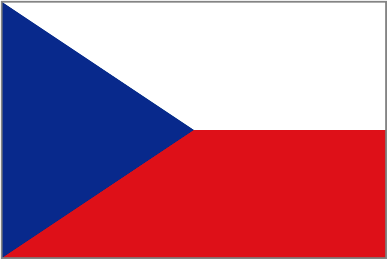 1819 - Congress of Carlsbad, Carlsbad, Bohemia (Czech Republic). Resulted in a set of reactionary restrictions introduced in the states of the German Confederation by resolution of the Bundesversammlung on 20 September 1819. They banned nationalist fraternities (Burschenschaften), removed liberal university professors & expanded the censorship of the press. /// Image is a contemporary lithograph mocking the new restrictions on the press & free expression imposed by the Carlsbad Decrees. The sign on the wall behind the table reads: "Important question to be considered in today's meeting: 'How long will we be allowed to think?'" 1819 - Congress of Carlsbad, Carlsbad, Bohemia (Czech Republic). Resulted in a set of reactionary restrictions introduced in the states of the German Confederation by resolution of the Bundesversammlung on 20 September 1819. They banned nationalist fraternities (Burschenschaften), removed liberal university professors & expanded the censorship of the press. /// Image is a contemporary lithograph mocking the new restrictions on the press & free expression imposed by the Carlsbad Decrees. The sign on the wall behind the table reads: "Important question to be considered in today's meeting: 'How long will we be allowed to think?'"
|  1820 -
"In France, the early pacifist movements were initially based either on moral considerations, as in the case of the Société de la Morale chrétienne, founded in 1820, or on the theories of Utopian socialism put forward by Henri de Saint-Simon [1760-1825] and Charles Fourier [1772-1837]." [André Durand, 1996] 1820 -
"In France, the early pacifist movements were initially based either on moral considerations, as in the case of the Société de la Morale chrétienne, founded in 1820, or on the theories of Utopian socialism put forward by Henri de Saint-Simon [1760-1825] and Charles Fourier [1772-1837]." [André Durand, 1996]

|  1820 - Temple de l'amité et de la paix / Temple of Friendship & Peace, United Nations, Geneva (Switzerland). Built by Count Jean-Jaques de Sellon [1782-1839] on his estate La Fenêtre (which now belongs to the United Nations). Destroyed during a storm in 1946, but its stones remain in storage (as shown in lower image). 1820 - Temple de l'amité et de la paix / Temple of Friendship & Peace, United Nations, Geneva (Switzerland). Built by Count Jean-Jaques de Sellon [1782-1839] on his estate La Fenêtre (which now belongs to the United Nations). Destroyed during a storm in 1946, but its stones remain in storage (as shown in lower image). 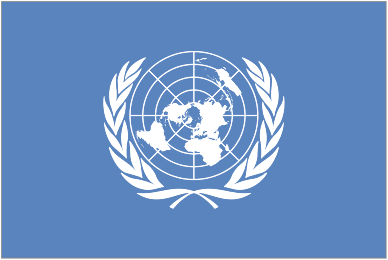
|

| 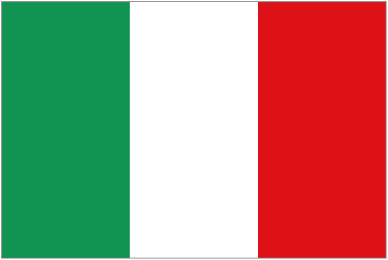 October 20, 1822 - Congress of Verona, Verona (Italy). Part of the series of international conferences or congresses that opened with the Congress of Vienna in 1814-15, which had instituted the Concert of Europe at the close of the Napoleonic Wars. Attended by members of the Quintuple Alliance - Russia, Austria, Prussia, France & United Kingdom. /// Image is a satirical drawing of the congress. October 20, 1822 - Congress of Verona, Verona (Italy). Part of the series of international conferences or congresses that opened with the Congress of Vienna in 1814-15, which had instituted the Concert of Europe at the close of the Napoleonic Wars. Attended by members of the Quintuple Alliance - Russia, Austria, Prussia, France & United Kingdom. /// Image is a satirical drawing of the congress.
|

|   December 15, 1823 - "William Ladd [1778-1841] begins the Peace Society of Minot, Town of Minot, Maine (USA). The first meeting is held at the local blacksmith shop at Minot Corner. Ladd will eventually organize five additional peace societies, and in 1826 will initiate the thought to turn the peace society into a national organization. On May 8, 1828, the American Peace Society is formed in Boston, Masssachusetts. From 1911 to 1948, the American Peace Society headquarters will be located near the White House in Washington, DC. In 1974 the building was declared a historic landmark." [NB: Population of Minot was 2,607 in the census of 2010. Image shows backsmith shop in West Minot, c.1900.] December 15, 1823 - "William Ladd [1778-1841] begins the Peace Society of Minot, Town of Minot, Maine (USA). The first meeting is held at the local blacksmith shop at Minot Corner. Ladd will eventually organize five additional peace societies, and in 1826 will initiate the thought to turn the peace society into a national organization. On May 8, 1828, the American Peace Society is formed in Boston, Masssachusetts. From 1911 to 1948, the American Peace Society headquarters will be located near the White House in Washington, DC. In 1974 the building was declared a historic landmark." [NB: Population of Minot was 2,607 in the census of 2010. Image shows backsmith shop in West Minot, c.1900.]
|
  1828-1844 - Second & third incarnations of the New York Peace Society (1837-1844). On May 8, 1828, the society merges with others in New Hampshire, Maine & Massachusetts to form the American Peace Society.
The society will be re-formed as an independent organization in 1837. Until 1844, it sought to prevent war against Mexico by advocating negotiation. It then dissolved. An attempt was made to re-create it, but this was short-lived." See 1906 below. 1828-1844 - Second & third incarnations of the New York Peace Society (1837-1844). On May 8, 1828, the society merges with others in New Hampshire, Maine & Massachusetts to form the American Peace Society.
The society will be re-formed as an independent organization in 1837. Until 1844, it sought to prevent war against Mexico by advocating negotiation. It then dissolved. An attempt was made to re-create it, but this was short-lived." See 1906 below.
|
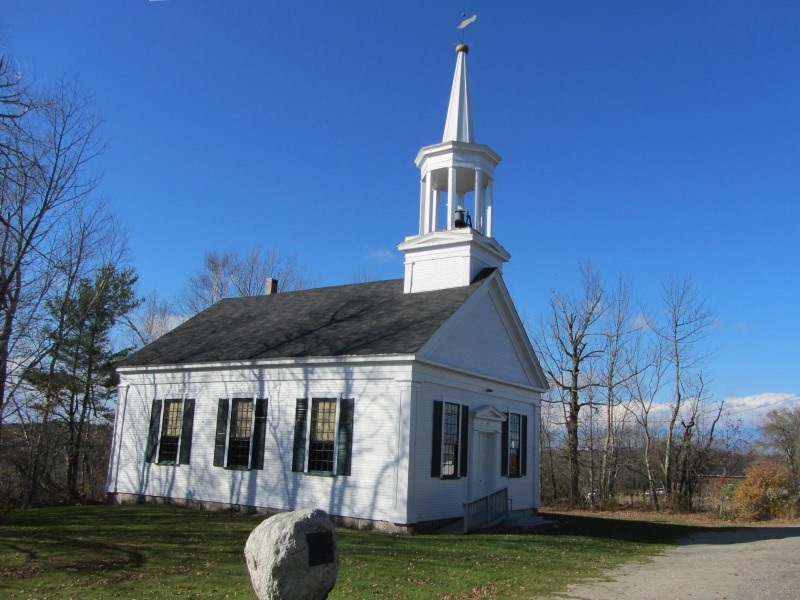 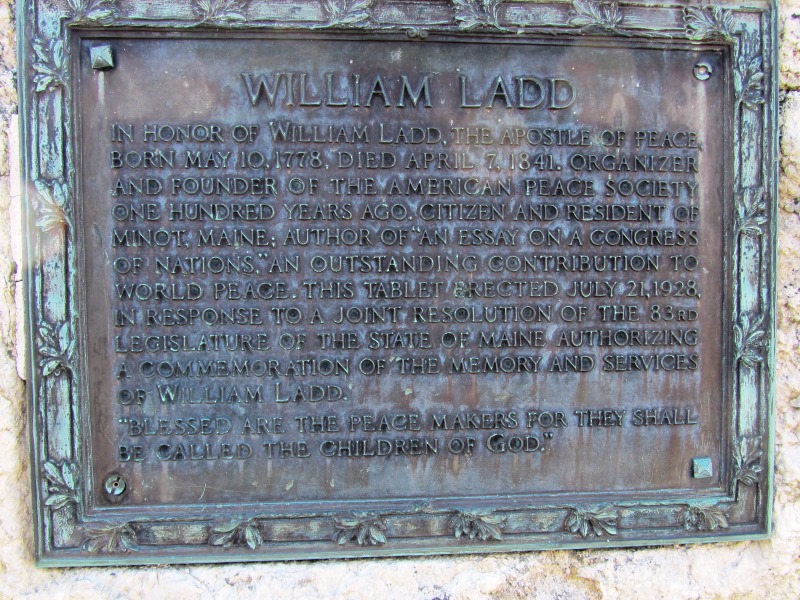

|   July 21, 1928 - William Ladd Boulder, Center Minot Congregational Church, Minot, Maine (USA). Monument created for the 100th anniversary of the founding of the American Peace Society & the 150th anniversary of William Ladd’s birth. Rests on granite from every state in New England, as well as stones from 14 other countries." Inscription on plaque: "In honor of William Ladd, the Apostle of Peace, born May 10, 1778, died April 7, 1841. Organizer and founder of the American Peace Society one hundred years ago. Citizen and resident of Minot, Maine, author of 'An Essay on a Congress of Nations' [1840], an outstanding contribution to world peace. This tablet erected July 21, 1928, in response to a joint resolution of the 83rd legislature of the State of Maine authorizing a commemoration of the memory and services of William Ladd. Blessed are the peace makers for they shall be called the children of God." July 21, 1928 - William Ladd Boulder, Center Minot Congregational Church, Minot, Maine (USA). Monument created for the 100th anniversary of the founding of the American Peace Society & the 150th anniversary of William Ladd’s birth. Rests on granite from every state in New England, as well as stones from 14 other countries." Inscription on plaque: "In honor of William Ladd, the Apostle of Peace, born May 10, 1778, died April 7, 1841. Organizer and founder of the American Peace Society one hundred years ago. Citizen and resident of Minot, Maine, author of 'An Essay on a Congress of Nations' [1840], an outstanding contribution to world peace. This tablet erected July 21, 1928, in response to a joint resolution of the 83rd legislature of the State of Maine authorizing a commemoration of the memory and services of William Ladd. Blessed are the peace makers for they shall be called the children of God."
|
 1830 - In Geneva (Switzerland), the first continental European peace society (friedensgesellschaft) was set up in 1830 by Count Jean-Jacques de Sellon [1782-1839]. De Sellon took as his guiding principle the inviolability of the individual, which led him first of all to campaign for the abolition of slavery & of the death penalty, and later to devote his efforts to promoting peace & arbitration between nations. [André Durand, 1996] 1830 - In Geneva (Switzerland), the first continental European peace society (friedensgesellschaft) was set up in 1830 by Count Jean-Jacques de Sellon [1782-1839]. De Sellon took as his guiding principle the inviolability of the individual, which led him first of all to campaign for the abolition of slavery & of the death penalty, and later to devote his efforts to promoting peace & arbitration between nations. [André Durand, 1996]
|


|  1832 - Marble Obilisk, Cemetiere du Petit-Saconnex, chemin Moise-Duboule 12, Le Petit-Saconnex, near Geneva (Switzerland). Erected by Count Jean-Jaques de Sellon [1782-1839] on his estate La Fenêtre (which now belongs to the United Nations) in Pregny, but it was transferred in 1907 to the nearby cemetery where he is buried. Inscriptions: "Heureux ceux ui procurent la paix car ils seront appelles enfants de dieu."
"Dieu ne veut pas la mort du pecheur mais sa conversion et sa vie."
"La Societe de la Paix fut fondee le 1er Decembre 1830 par J.J. de Sellon, Citoyen de Geneve, Comte du St Empire. Il consacra ce monuent a l'inviolabilite de la vie de l'homme l'an 1832." Also bears the names of advocates of peace & of the abolition of the death penalty: William Penn, Casimir Perrier, [Stanley?] Livingston, Nicholas de Flue, William Wilberforce, Elisabeth (the queen?), the US states of Maine & New Hampshire (ont aboli la peine de mort l'an 1837 [sic]), Duke Leopold of Tuscany, Victor de Tracy, Charles Lucas, Cesare Beccaria, Grohmann, Fredericc Guillaume of Prussia,
Henry IV of France, the Duke of Sully,
Fenelon & the Duke of Sussex. ALL information about this monument is from "Itinerary for Peace in the Streets of Geneva" (August 2002), pp. 102-3. Image shows the cemetery but NOT the monument. 1832 - Marble Obilisk, Cemetiere du Petit-Saconnex, chemin Moise-Duboule 12, Le Petit-Saconnex, near Geneva (Switzerland). Erected by Count Jean-Jaques de Sellon [1782-1839] on his estate La Fenêtre (which now belongs to the United Nations) in Pregny, but it was transferred in 1907 to the nearby cemetery where he is buried. Inscriptions: "Heureux ceux ui procurent la paix car ils seront appelles enfants de dieu."
"Dieu ne veut pas la mort du pecheur mais sa conversion et sa vie."
"La Societe de la Paix fut fondee le 1er Decembre 1830 par J.J. de Sellon, Citoyen de Geneve, Comte du St Empire. Il consacra ce monuent a l'inviolabilite de la vie de l'homme l'an 1832." Also bears the names of advocates of peace & of the abolition of the death penalty: William Penn, Casimir Perrier, [Stanley?] Livingston, Nicholas de Flue, William Wilberforce, Elisabeth (the queen?), the US states of Maine & New Hampshire (ont aboli la peine de mort l'an 1837 [sic]), Duke Leopold of Tuscany, Victor de Tracy, Charles Lucas, Cesare Beccaria, Grohmann, Fredericc Guillaume of Prussia,
Henry IV of France, the Duke of Sully,
Fenelon & the Duke of Sussex. ALL information about this monument is from "Itinerary for Peace in the Streets of Geneva" (August 2002), pp. 102-3. Image shows the cemetery but NOT the monument.
|  |  Before 1839 - Château Allaman/Allaman Castle, Allaman, Vaud (Switzerland). "Has its origins in the 11th Century but the main components were built by the Count of Vaud in 1253.
The wealthy Genevan philanthropist Jean-Jacques de Sellon [1782-1839], who owned the property until 1839, gave accommodation at the castle to, amongst many others, such political refugees as Napoleon's brother Joseph Bonaparte, Joséphine de Beauharnais, the Duke of Bassano, the Count Camille Cavour, Voltaire as well as to Franz Liszt & George Sand. In 1820 [sic], de Sellon founded the Society of Peace, forerunner of the League of Nations & the United Nations Organization (UN). Since then, the Castle has also been referred to 'The Castle of Peace,' & Sellon was also instrumental in the abolition of the death penalty in Switzerland.
One of the largest private properties of Switzerland, the private estate covers over 330,000 square metres (33 hectares; 82 acres) and offers some 6,000 m2 (65,000 sq ft) of living space. It is surrounded by private forests, parks, gardens & Grand Cru vineyards." Before 1839 - Château Allaman/Allaman Castle, Allaman, Vaud (Switzerland). "Has its origins in the 11th Century but the main components were built by the Count of Vaud in 1253.
The wealthy Genevan philanthropist Jean-Jacques de Sellon [1782-1839], who owned the property until 1839, gave accommodation at the castle to, amongst many others, such political refugees as Napoleon's brother Joseph Bonaparte, Joséphine de Beauharnais, the Duke of Bassano, the Count Camille Cavour, Voltaire as well as to Franz Liszt & George Sand. In 1820 [sic], de Sellon founded the Society of Peace, forerunner of the League of Nations & the United Nations Organization (UN). Since then, the Castle has also been referred to 'The Castle of Peace,' & Sellon was also instrumental in the abolition of the death penalty in Switzerland.
One of the largest private properties of Switzerland, the private estate covers over 330,000 square metres (33 hectares; 82 acres) and offers some 6,000 m2 (65,000 sq ft) of living space. It is surrounded by private forests, parks, gardens & Grand Cru vineyards."
|

|
  May 1832 - Congress of London, London (England). "An international conference convened to establish a stable government in Greece. Negotiations between the three Great Powers - Britain, France & Russia - resulted in the establishment of the Kingdom of Greece under a Bavarian Prince. On July 21, 1832 British ambassador Sir Stratford Canning [1786-1880] & the other representatives concluded the Treaty of Constantinople, which set the boundaries of the new Kingdom of Greece at a line running from Arta to Volos. The treaty followed the Akkerman Convention which had previously recognized another territorial change in the Balkans, the suzerainty of Principality of Serbia." /// Image is a satirical drawing of the congress. May 1832 - Congress of London, London (England). "An international conference convened to establish a stable government in Greece. Negotiations between the three Great Powers - Britain, France & Russia - resulted in the establishment of the Kingdom of Greece under a Bavarian Prince. On July 21, 1832 British ambassador Sir Stratford Canning [1786-1880] & the other representatives concluded the Treaty of Constantinople, which set the boundaries of the new Kingdom of Greece at a line running from Arta to Volos. The treaty followed the Akkerman Convention which had previously recognized another territorial change in the Balkans, the suzerainty of Principality of Serbia." /// Image is a satirical drawing of the congress.
|

 |  1838 - Peace Column, Château Allaman/Allaman Castle (aka Peace Castle), Allaman, Vaud (Switzerland). On Lake Geneva. Column was discovered in 2013 hidden, perhaps deliberately, inside a plaster pillar.
"One of the most significant historical Castles (maybe in the whole of Europe, the heart of the Peace movement, initiated & inspired by Count J.J. de Sellon. It is in [this castle] that the first Congrès of Peace took place in 1832. So, you are, if I may say, and keeper of the Peace history. What does it represent for you to be the owner of the Peace Castle? ///
Markus Jerger: The honour, privilege & pleasure to own & live in a medieval estate is not comparable to any other form of 'home' or 'life' experience. You are inspired daily by a new historic discovery when surrounded by a rich past, like in Allaman Castle. This place emerges you into the evolution of the societies of the region in the 10th, 12th, 14th, 18th Century & the past owners life & contribution to our history. Sellon is such an exceptional example, but also Cavour or the Countess Margarite de Langallerie were outstanding contributors to the Castle's unique evolution." /// Translation of the column's inscriptions is unavailable. INCOMPLETE 1838 - Peace Column, Château Allaman/Allaman Castle (aka Peace Castle), Allaman, Vaud (Switzerland). On Lake Geneva. Column was discovered in 2013 hidden, perhaps deliberately, inside a plaster pillar.
"One of the most significant historical Castles (maybe in the whole of Europe, the heart of the Peace movement, initiated & inspired by Count J.J. de Sellon. It is in [this castle] that the first Congrès of Peace took place in 1832. So, you are, if I may say, and keeper of the Peace history. What does it represent for you to be the owner of the Peace Castle? ///
Markus Jerger: The honour, privilege & pleasure to own & live in a medieval estate is not comparable to any other form of 'home' or 'life' experience. You are inspired daily by a new historic discovery when surrounded by a rich past, like in Allaman Castle. This place emerges you into the evolution of the societies of the region in the 10th, 12th, 14th, 18th Century & the past owners life & contribution to our history. Sellon is such an exceptional example, but also Cavour or the Countess Margarite de Langallerie were outstanding contributors to the Castle's unique evolution." /// Translation of the column's inscriptions is unavailable. INCOMPLETE
|   April 17, 1839 - The Anti-Slavery Society, London (England). Formed by Thomas Clarkson [1760-1846] & other abolitionists to campaign against slavery worldwide. Today known as Anti-Slavery International. April 17, 1839 - The Anti-Slavery Society, London (England). Formed by Thomas Clarkson [1760-1846] & other abolitionists to campaign against slavery worldwide. Today known as Anti-Slavery International.
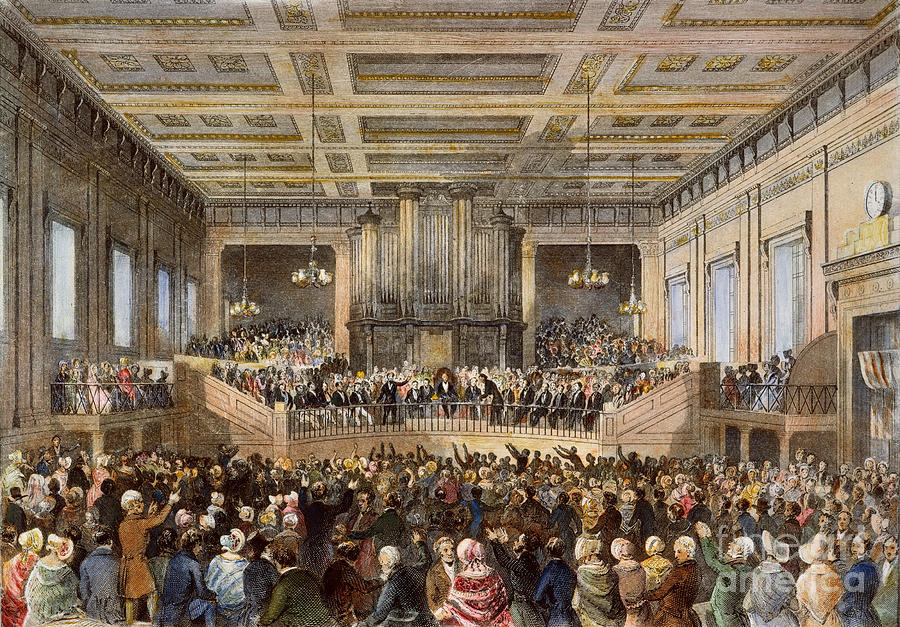



|   June 12-23, 1840 - World Anti-Slavery Convention, Exeter (or Fremasons) Hall, London (England). Convened by the Anti-Slavery Society. World's first anti-slavery convention.. Organized by Joseph Sturge [1793-1859]. Key speaker was Thomas Clarkson [1760-1846]. Attracted delegates from Europe, North America & Caribbean countries, as well as the British dominions of Australia & Ireland, though no delegates from Africa attended. Included African-Caribbean delegates from Haiti & Jamaica (then representing Britain), women activists from the USA & many Nonconformists." "Lucretia Mott & Elizabeth Cady Stanton traveled with their husbands to London for the convention, but the women were not allowed to participate." Later conferences held in 1843 (Brussels) & 1849 (Paris). Left image is a contempory engraging. Middle image is 'The Anti-Slavery Society Convention, 1840' by Benjamin Robert Haydon [1786-1846]. "Inset shows from left to right: Vice Admiral Constantine Richard Moorsom [1792-1861], Sturge, American delegate John Keep [1781-1870], Joseph Eaton. Top left G.K.Prince & top right, James Dean (another American)." June 12-23, 1840 - World Anti-Slavery Convention, Exeter (or Fremasons) Hall, London (England). Convened by the Anti-Slavery Society. World's first anti-slavery convention.. Organized by Joseph Sturge [1793-1859]. Key speaker was Thomas Clarkson [1760-1846]. Attracted delegates from Europe, North America & Caribbean countries, as well as the British dominions of Australia & Ireland, though no delegates from Africa attended. Included African-Caribbean delegates from Haiti & Jamaica (then representing Britain), women activists from the USA & many Nonconformists." "Lucretia Mott & Elizabeth Cady Stanton traveled with their husbands to London for the convention, but the women were not allowed to participate." Later conferences held in 1843 (Brussels) & 1849 (Paris). Left image is a contempory engraging. Middle image is 'The Anti-Slavery Society Convention, 1840' by Benjamin Robert Haydon [1786-1846]. "Inset shows from left to right: Vice Admiral Constantine Richard Moorsom [1792-1861], Sturge, American delegate John Keep [1781-1870], Joseph Eaton. Top left G.K.Prince & top right, James Dean (another American)."
| |  1840 - "The seed for the first Woman's Rights Convention was planted in 1840, when Elizabeth Cady Stanton [1815-1902] met Lucretia Mott [1793-1880] at the World Anti-Slavery Convention in London, the conference that refused to seat Mott and other women delegates from America because of their sex. Stanton, the young bride of an antislavery agent, and Mott, a Quaker preacher & veteran of reform, talked then of calling a convention to address the condition of women. Eight years later, it came about as a spontaneous event [in Seneca Falls, New York, on July 19-20, 1848]." 1840 - "The seed for the first Woman's Rights Convention was planted in 1840, when Elizabeth Cady Stanton [1815-1902] met Lucretia Mott [1793-1880] at the World Anti-Slavery Convention in London, the conference that refused to seat Mott and other women delegates from America because of their sex. Stanton, the young bride of an antislavery agent, and Mott, a Quaker preacher & veteran of reform, talked then of calling a convention to address the condition of women. Eight years later, it came about as a spontaneous event [in Seneca Falls, New York, on July 19-20, 1848]."
 1843 - 2nd World Anti-Slavery Convention, Brussels (Belgium). 1843 - 2nd World Anti-Slavery Convention, Brussels (Belgium).

|   1843 - Congress of Peace, London (England). "To coordinate the advancement of world peace, the British convened the first Congress of Peace in London in 1843, inviting delegates from peace movements from around the world." "Convened by the London Peace Society [image] on the initiative of the American Peace Society. The participants, most of them Anglo-Saxons, mainly discussed matters relating to Christian humanitarianism. A few social issues, which were subsequently to take on much more importance, did appear, however, together with a proposal that conflicts be settled by mediation." "Following a preparatory congress at London in 1843, a series of congresses called International Congress of the Friends of Peace or more informally 'International Peace Congress' were organised from 1848 until 1853." 1843 - Congress of Peace, London (England). "To coordinate the advancement of world peace, the British convened the first Congress of Peace in London in 1843, inviting delegates from peace movements from around the world." "Convened by the London Peace Society [image] on the initiative of the American Peace Society. The participants, most of them Anglo-Saxons, mainly discussed matters relating to Christian humanitarianism. A few social issues, which were subsequently to take on much more importance, did appear, however, together with a proposal that conflicts be settled by mediation." "Following a preparatory congress at London in 1843, a series of congresses called International Congress of the Friends of Peace or more informally 'International Peace Congress' were organised from 1848 until 1853."
|
|   July 19-20, 1848 - First Woman's Rights Convention, Seneca Falls, New York (USA). Organized by Elizabeth Cady Stanton [1815-1902] & Lucretia Mott [1793-1880] who met at the World Anti-Slavery Convention in London in 1840. Attended by about 260 women & 40 men from central New York state (including former slave Frederick Douglass). Not an international conference. July 19-20, 1848 - First Woman's Rights Convention, Seneca Falls, New York (USA). Organized by Elizabeth Cady Stanton [1815-1902] & Lucretia Mott [1793-1880] who met at the World Anti-Slavery Convention in London in 1840. Attended by about 260 women & 40 men from central New York state (including former slave Frederick Douglass). Not an international conference.
 September 1848 - 1st International Peace Congress, Brussels (Belgium). "First peace congress after the revolution of February 1848." "Organized by American philanthropist & social activist [& former blacksmith] Elihu Burritt [1810-1879] & chaired by Belgian lawyer & philanthropist Auguste Visschers [1804-1874]. Among the distinguished delegates were Richard Cobden [1804-1865], Augustin Thierry [1795-1856], Émile de Girardin [1802-1881], and Frédéric Bastiat [1801-1850]. The congress adopted resolutions urging limitation of armaments and the placing of a ban upon foreign loans for war purposes." "The first Congress was mainly a British-American venture. The following Congresses attracted a more and more international participation, but British & American societies were for a long time the core of the movement." (Burritt attended the peace congresses`at Frankfort-am-Main in 1850, London in 1851, Manchester in 1852, and Edinburgh in 1853.) ("Auguste Visschers reappeared at the side of Gustave Moynier at the International Charity Congress in Brussels in 1856 & at the Geneva Diplomatic Conference in 1864.") September 1848 - 1st International Peace Congress, Brussels (Belgium). "First peace congress after the revolution of February 1848." "Organized by American philanthropist & social activist [& former blacksmith] Elihu Burritt [1810-1879] & chaired by Belgian lawyer & philanthropist Auguste Visschers [1804-1874]. Among the distinguished delegates were Richard Cobden [1804-1865], Augustin Thierry [1795-1856], Émile de Girardin [1802-1881], and Frédéric Bastiat [1801-1850]. The congress adopted resolutions urging limitation of armaments and the placing of a ban upon foreign loans for war purposes." "The first Congress was mainly a British-American venture. The following Congresses attracted a more and more international participation, but British & American societies were for a long time the core of the movement." (Burritt attended the peace congresses`at Frankfort-am-Main in 1850, London in 1851, Manchester in 1852, and Edinburgh in 1853.) ("Auguste Visschers reappeared at the side of Gustave Moynier at the International Charity Congress in Brussels in 1856 & at the Geneva Diplomatic Conference in 1864.")
|
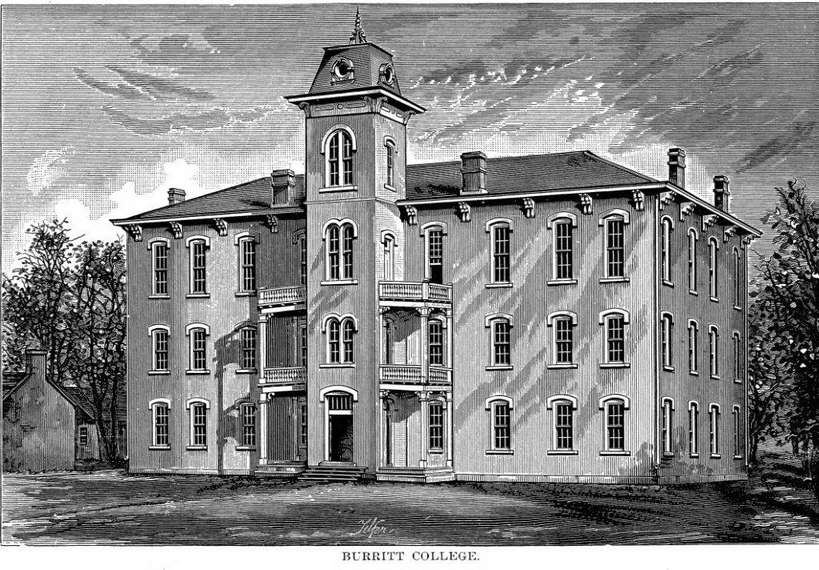

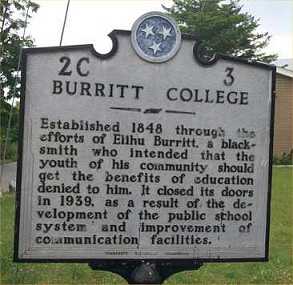
|   1848-1939 - Burritt College, Spencer, Van Buren County, Tennessee (USA). Closed in 1939, but ruins still visible. "Founders chose the name of Ehihu Burritt [1810-1879] to affix to their school because they admired the initiative, perseverance, and determination which characterized Burritt's rise to national prominence. While there was not an overwhelming amount of pacifistic sentiment within the Church of Christ, there was nevertheless a sufficient amount for the small band of Christians in the isolated village of Spencer, Tennessee, to know of the life and work of one of the outstanding leaders in the peace movement. Generally the Church of Christ followed the pattern set by other religious groups in questions such as war & slavery." 1848-1939 - Burritt College, Spencer, Van Buren County, Tennessee (USA). Closed in 1939, but ruins still visible. "Founders chose the name of Ehihu Burritt [1810-1879] to affix to their school because they admired the initiative, perseverance, and determination which characterized Burritt's rise to national prominence. While there was not an overwhelming amount of pacifistic sentiment within the Church of Christ, there was nevertheless a sufficient amount for the small band of Christians in the isolated village of Spencer, Tennessee, to know of the life and work of one of the outstanding leaders in the peace movement. Generally the Church of Christ followed the pattern set by other religious groups in questions such as war & slavery."
|

|
 August 22-24, 1849 -
2nd International Peace Congress, Salle Sainte-Cecile, Paris (France). "One year after Brussels, the Peace Congress met in Paris with Victor Hugo [1802-1885] as President."
"Hugo became interested in the philosophy of pacifism and in 1851 [sic] took part in the International Peace Congress in Paris where he called for the creation of a United States of Europe. Hugo was also a member of the Legislative Assembly but was forced to flee the country in 1852 after Emperor Napoleon III gained power." "Hugo's opening speech - known as "The United States of Europe" - has been called 'the best-known document of the 19th-century peace movement.'" "The Paris Congress adopted what may have been the first programme of the international peace movement." The proceedings of the 1849 & 1850 conferences were published by Charles Gilpin [1815-1874] in England and are available on-line from Google Books. "The Salle Sainte-Cecile was soon to fall prey to Louis-Napoleon's reconstruction of Paris... The placing here, if not of a statue, of at least a memorial plaque, seems appropriate." August 22-24, 1849 -
2nd International Peace Congress, Salle Sainte-Cecile, Paris (France). "One year after Brussels, the Peace Congress met in Paris with Victor Hugo [1802-1885] as President."
"Hugo became interested in the philosophy of pacifism and in 1851 [sic] took part in the International Peace Congress in Paris where he called for the creation of a United States of Europe. Hugo was also a member of the Legislative Assembly but was forced to flee the country in 1852 after Emperor Napoleon III gained power." "Hugo's opening speech - known as "The United States of Europe" - has been called 'the best-known document of the 19th-century peace movement.'" "The Paris Congress adopted what may have been the first programme of the international peace movement." The proceedings of the 1849 & 1850 conferences were published by Charles Gilpin [1815-1874] in England and are available on-line from Google Books. "The Salle Sainte-Cecile was soon to fall prey to Louis-Napoleon's reconstruction of Paris... The placing here, if not of a statue, of at least a memorial plaque, seems appropriate."
|




|   1850 -
3rd International Peace Congress, Paulskirche, Paulsplatz, Frankfurt am Main (Germany). From Peter van den Dungen: "Seat of course of the 1848-49 parliament [the first publicly and freely elected body of Germany], but also of the August 1850 international peace congress (of the peace movement). If I remember well, there are some reminders of this inside the building. I visited it at least once, when I received an invitation to attend the award of Germany’s most important peace prize, the one awarded by the German book trade (Friedenspreis des Deutschen Buchhandels). The annual ceremony is being held here. In my view, it comes second, after the Nobel, in terms of the elaborateness of the ceremony, the dignity of the occasion, the standing in the country, the documentation which is produced, etc. It follows the Nobel at some distance, but that is inevitable (no royalty involved, the prize money is less, the outside world hardly takes notice, etc.). It has interesting origins, not long after WW-II." 1850 -
3rd International Peace Congress, Paulskirche, Paulsplatz, Frankfurt am Main (Germany). From Peter van den Dungen: "Seat of course of the 1848-49 parliament [the first publicly and freely elected body of Germany], but also of the August 1850 international peace congress (of the peace movement). If I remember well, there are some reminders of this inside the building. I visited it at least once, when I received an invitation to attend the award of Germany’s most important peace prize, the one awarded by the German book trade (Friedenspreis des Deutschen Buchhandels). The annual ceremony is being held here. In my view, it comes second, after the Nobel, in terms of the elaborateness of the ceremony, the dignity of the occasion, the standing in the country, the documentation which is produced, etc. It follows the Nobel at some distance, but that is inevitable (no royalty involved, the prize money is less, the outside world hardly takes notice, etc.). It has interesting origins, not long after WW-II."
|   October 23-24, 1850 - First National Women's Rights Convention, Brinley Hall, Worcester, Massachusetts (USA). Combined both male & female leadership. And attracted a wide base of support including temperance advocates & abolitionists. Speeches given on equal wages, expanded education & career opportunities, women's property rights, marriage reform & temperance. Chief among the concerns discussed at the convention was the passage of laws that would give suffrage to women. Thereafter, the convention became an annual series of meetings that increased the visibility of the early women's rights movement in the USA. October 23-24, 1850 - First National Women's Rights Convention, Brinley Hall, Worcester, Massachusetts (USA). Combined both male & female leadership. And attracted a wide base of support including temperance advocates & abolitionists. Speeches given on equal wages, expanded education & career opportunities, women's property rights, marriage reform & temperance. Chief among the concerns discussed at the convention was the passage of laws that would give suffrage to women. Thereafter, the convention became an annual series of meetings that increased the visibility of the early women's rights movement in the USA.
| Comment: Visit on 04Aug2010 yielded absolutely no physical evidence at Paulskirche of the 1850 peace conference or of the annual Friedenspreis des Deutschen Buchhandels. No plaque, not part of the many bilingual photo displays (devoted almost entirely to the 1848-49 conference and to the destruction by allied bombs and fire in 1944), not part of the multilanguage film, no mention in English language brochure. This was confirmed by the attendent on duty -- who at least knew of the 1850 peace conference. The Paulskirche may therefore be a "freedom monument," but it serves only as an unintentioinal "peace monument."
  July 1851 -
4th International Peace Congress, London (England). July 1851 -
4th International Peace Congress, London (England).
 |
  January 27-28, 1853 -
5th International Peace Congress, Corn Exchange,
Manchester (England). "Delegates from all over England assembled for a two-day conference on peace. The boundaries of this mid-century international movement were the 1848 Revolutions & the Crimean War... Historians have in general regarded the Manchester & Edinburgh conferences as little more than footnotes to the more serious business that had gone before. Paris has been portrayed as the movement's high-water mark, whereas Manchester & Edinburgh are normally seen as purely domestic affairs - an attempt by the British peace movement to rescue a flagging & moribund cause..." /// N.B.: This conference is the subject of a talk at a Peace History Conference in Birmingham on November 10, 2012, by Martin Ceadel, Professor of Politics, University of Oxford. January 27-28, 1853 -
5th International Peace Congress, Corn Exchange,
Manchester (England). "Delegates from all over England assembled for a two-day conference on peace. The boundaries of this mid-century international movement were the 1848 Revolutions & the Crimean War... Historians have in general regarded the Manchester & Edinburgh conferences as little more than footnotes to the more serious business that had gone before. Paris has been portrayed as the movement's high-water mark, whereas Manchester & Edinburgh are normally seen as purely domestic affairs - an attempt by the British peace movement to rescue a flagging & moribund cause..." /// N.B.: This conference is the subject of a talk at a Peace History Conference in Birmingham on November 10, 2012, by Martin Ceadel, Professor of Politics, University of Oxford.
|   October 1853 -
6th International Peace Congress, Edinburgh (Scotland). Why did this series of International Peace Congresses end in 1853? No peace conference held again in the UK until 1890? October 1853 -
6th International Peace Congress, Edinburgh (Scotland). Why did this series of International Peace Congresses end in 1853? No peace conference held again in the UK until 1890?


 |
  May 12-25, 1857 - Congress of the Advanced Minds of the World, St. Martin's Hall, Long Acre, & in the Literary & Scientific Institution, John Street, Fitzroy Square, London (England). Convened by Robert Owen [1771-1858]. "...consider[ed] the best peaceable mode of changing the present false and evil system for the true and good system of society by which to new-form the character af all from birth, and reconstruct society through all its remifications, in order to make man good, united to his fellows, wise and happy, and society prosperous, consistent, and each part working in harmony with every other part, forming thus a perfect science of society to create, consolidate and perpetuate human happness." Information courtesy of Christine Kyprianides Potter, Indiana University. May 12-25, 1857 - Congress of the Advanced Minds of the World, St. Martin's Hall, Long Acre, & in the Literary & Scientific Institution, John Street, Fitzroy Square, London (England). Convened by Robert Owen [1771-1858]. "...consider[ed] the best peaceable mode of changing the present false and evil system for the true and good system of society by which to new-form the character af all from birth, and reconstruct society through all its remifications, in order to make man good, united to his fellows, wise and happy, and society prosperous, consistent, and each part working in harmony with every other part, forming thus a perfect science of society to create, consolidate and perpetuate human happness." Information courtesy of Christine Kyprianides Potter, Indiana University.
|  June 24, 1859 - Battle of Solferino Solferino (Italy). "Resulted in victory of the allied French Army under Napoleon III & Sardinian Army under Victor Emmanuel II (together known as the Franco-Sardinian Alliance) against the Austrian Army under Emperor Franz Joseph I. The last major battle in world history where all the armies were under the personal command of their monarchs. Perhaps 300,000 soldiers fought in this important battle, the largest since the Battle of Leipzig in 1813. There were about 130,000 Austrian troops and a combined total of 140,000 French and allied Piedmontese troops." /// Suffering witnessed by Henry Durant [1828-1910], leading to the creation of the Red Cross in Geneva (Switzerland). June 24, 1859 - Battle of Solferino Solferino (Italy). "Resulted in victory of the allied French Army under Napoleon III & Sardinian Army under Victor Emmanuel II (together known as the Franco-Sardinian Alliance) against the Austrian Army under Emperor Franz Joseph I. The last major battle in world history where all the armies were under the personal command of their monarchs. Perhaps 300,000 soldiers fought in this important battle, the largest since the Battle of Leipzig in 1813. There were about 130,000 Austrian troops and a combined total of 140,000 French and allied Piedmontese troops." /// Suffering witnessed by Henry Durant [1828-1910], leading to the creation of the Red Cross in Geneva (Switzerland).
1861-1865 - American Civil War.
"In 1861, the [peace] societies for the first time were confronted with the classic pacifist dilemma when the American Civil War broke out. The American Peace Society saw slavery as a greater evil than war, and supported the Northern war effort, while the London Peace Society protested against violence in all circumstances." -- From Santi (1991).
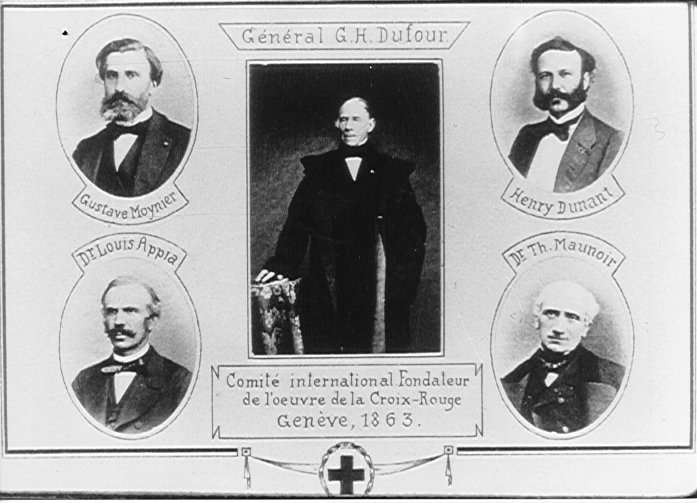 |
 October 1863 - "Geneva Congress," Geneva (Switzerland). Organized by a five-member committee (after its first meeting on February 17, 1863) to discuss the improvement of care for wounded soldiers. Attended by 14 states. "Speaking after General Guillaume-Henri Dufour [1787-1875], Gustave Moynier [1826-1910] explained the position of the International Committee of the Red Cross (ICRC)."
"Henry Dunant [1828-1910], however, was only a protocol leader because of Moynier's efforts to diminish his role." October 1863 - "Geneva Congress," Geneva (Switzerland). Organized by a five-member committee (after its first meeting on February 17, 1863) to discuss the improvement of care for wounded soldiers. Attended by 14 states. "Speaking after General Guillaume-Henri Dufour [1787-1875], Gustave Moynier [1826-1910] explained the position of the International Committee of the Red Cross (ICRC)."
"Henry Dunant [1828-1910], however, was only a protocol leader because of Moynier's efforts to diminish his role." 
|

  August 22, 1864 -
First Geneva Convention, Hotel de Ville / City Hall, Geneva (Switzerland). A diplomatic conference organized by the Swiss Parliament. ("Henri Dunant, again, was only in charge of organizing accommodation for the attendees.") "The First Geneva Convention founds the International Committee of the Red Cross (ICRC) & begins Geneva's role as an international city." The ten articles of this first treaty were initially adopted by 12 nations. Clara Barton [1821-1912] was instrumental in campaigning for the ratification of the convention by the USA, which eventually ratified it in 1882. Subsequenet conventions & protocols were signed in 1906, 1929, 1949, 1977 & 2005. Hall in which the convention took place is now called Salle de l'Alabama / Hall of the Alabama (see below). August 22, 1864 -
First Geneva Convention, Hotel de Ville / City Hall, Geneva (Switzerland). A diplomatic conference organized by the Swiss Parliament. ("Henri Dunant, again, was only in charge of organizing accommodation for the attendees.") "The First Geneva Convention founds the International Committee of the Red Cross (ICRC) & begins Geneva's role as an international city." The ten articles of this first treaty were initially adopted by 12 nations. Clara Barton [1821-1912] was instrumental in campaigning for the ratification of the convention by the USA, which eventually ratified it in 1882. Subsequenet conventions & protocols were signed in 1906, 1929, 1949, 1977 & 2005. Hall in which the convention took place is now called Salle de l'Alabama / Hall of the Alabama (see below). 
| M
U
SE
U
M |

 
 1988 - Musee International de la Croix-Rouge et du Croissant-Rouge / International Red Cross & Red Crescent Museum, 17 avenue de la Paix, Geneva (Switzerland). Click here for Wikipedia article. Right image shows "The Petrified" at museum entrance.
Associated with the International Network of Museums for Peace (INMP). 1988 - Musee International de la Croix-Rouge et du Croissant-Rouge / International Red Cross & Red Crescent Museum, 17 avenue de la Paix, Geneva (Switzerland). Click here for Wikipedia article. Right image shows "The Petrified" at museum entrance.
Associated with the International Network of Museums for Peace (INMP). 

|

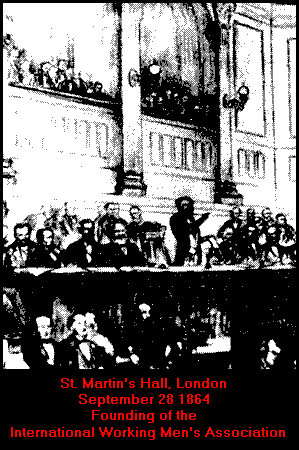

|   September 28, 1864 - International Workers' Association, St. Martin's Hall, Long Acre, London (England). "International meeting for the reception of the French delegates... Attended by a wide array of European radicals, including English Owenites, French followers of Pierre-Joseph Proudhon & Louis Auguste Blanqui, Irish & Polish nationalists, Italian republicans & German socialists, including a somewhat obscure 46-year old émigré journalist, Karl Marx [1818-1883]." /// "With the appearance of the first workers' organizations, culminating in the founding of the International Workers' Association (IWA) in London in 1864, the religious, humanitarian & moral motivations underlying the pacifist movements in the first half of the century were replaced by a call for social justice; while peace was maintained as an objective, the class struggle was proposed as a means of attaining it." [André Durand, 1996] /// The IWA was also known as the "First International." September 28, 1864 - International Workers' Association, St. Martin's Hall, Long Acre, London (England). "International meeting for the reception of the French delegates... Attended by a wide array of European radicals, including English Owenites, French followers of Pierre-Joseph Proudhon & Louis Auguste Blanqui, Irish & Polish nationalists, Italian republicans & German socialists, including a somewhat obscure 46-year old émigré journalist, Karl Marx [1818-1883]." /// "With the appearance of the first workers' organizations, culminating in the founding of the International Workers' Association (IWA) in London in 1864, the religious, humanitarian & moral motivations underlying the pacifist movements in the first half of the century were replaced by a call for social justice; while peace was maintained as an objective, the class struggle was proposed as a means of attaining it." [André Durand, 1996] /// The IWA was also known as the "First International."
|  May 17, 1865 - International Telegraph Union, Berne (Switzerland). One of the first 8 international organizations, according journalist to W.T Stead (1898), and one of four to be in Berne. Now called the International Telecommunication Union (ITU) and headquarted in Geneva. May 17, 1865 - International Telegraph Union, Berne (Switzerland). One of the first 8 international organizations, according journalist to W.T Stead (1898), and one of four to be in Berne. Now called the International Telecommunication Union (ITU) and headquarted in Geneva.
"In 1867, the rift manifested itself on the international level when two international organisations were founded. The International League for Peace came into being at a conference in Paris in May 1867. The International League for Peace & Freedom was created at a meeting in Geneva in September 1867. Two founders of the latter were Victor Hugo of France [1802-1885] of France & Giuseppe Garibaldi [1807-1882] of Italy. The League for Peace was neutral in political & religious matters, while the League for Peace & Freedom was more radical. It advocated a republic in place of monarchical rule, objected to clerical violence & 'Popery' & advocated democracy. Garibaldi wanted revolutionary measures, while a group of French socialists spoke about the oppressiveness of capitalism, which created an uproar and some dry comments about internal quarrels among pacifists. The League for Peace feared being compromised & changed its name to the Society of Friends of Peace (Société des Amis de la Paix). In the interest of peace this league tried to dampen British criticism against the new French dictator Louis Napoleon, while the exiled Victor Hugo wanted a French revolution & a republic. These differences have continued to be the issue of never-ending discussions within the peace movement: Should the State arm itself for 'defence' (against other states, revolutions, greater evils), and is it right (or a good strategy) for the oppressed to use violence against the State, or against a greater evil." -- From Santi (1991).
 May 30, 1867 - Frédéric Passy [1822-1912] announces in Paris the establishment of a new society, the Ligue internationale et permanente de la Paix. "The new society, considering that wars ran clearly counter to the trends of civilization, referred first of all to the balance of European powers, which had the duty of abstaining from any attack upon or threat against other nations. In order to uphold and propagate the great principles of mutual respect, which in Passy's opinion should thenceforth constitute the common charter of humankind, he appealed for the support of all men of good will in every country. Gustave Moynier is a founding member." [André Durand, 1996] /// "President in 1867, French lawyer, notary & writer Émile Arnaud [1864-1921] will -- in 1901 -- propose the term 'pacifism' to summarize the various currents & intellectual positions of the peace movement in general." May 30, 1867 - Frédéric Passy [1822-1912] announces in Paris the establishment of a new society, the Ligue internationale et permanente de la Paix. "The new society, considering that wars ran clearly counter to the trends of civilization, referred first of all to the balance of European powers, which had the duty of abstaining from any attack upon or threat against other nations. In order to uphold and propagate the great principles of mutual respect, which in Passy's opinion should thenceforth constitute the common charter of humankind, he appealed for the support of all men of good will in every country. Gustave Moynier is a founding member." [André Durand, 1996] /// "President in 1867, French lawyer, notary & writer Émile Arnaud [1864-1921] will -- in 1901 -- propose the term 'pacifism' to summarize the various currents & intellectual positions of the peace movement in general."
 September 9, 1867 - Pacifist Congress, Electoral Building, Geneva (Switzerland).
"On the initiative of the philosopher Charles Lemonnier, a follower of Henri de Saint-Simon [1760-1825], [a group of French pacifists] convene a pacifist congress in Geneva in September 1867, with objectives and means that differed substantially from those proposed by Frédéric Passy [1822-1912]: 'The aim of the Geneva Congress is to determine the political and economic conditions required for peace among peoples, and in particular for the establishment of the United States of Europe. It aspires to be the conference of European democracy, expressing through its most authorized spokesmen the elements of this great solution and sounding, in the name of the immortal principles of the French Revolution, the signal for consciences to awake: it is time for democracy to stand up and show itself.'" [André Durand, 1996] The International League of Peace & Liberty organised a series of international peace congresses: 1867 - 1st congress, Geneva (Switzerland). 1873 - 2nd congress. 1889 - 3rd congress. September 9, 1867 - Pacifist Congress, Electoral Building, Geneva (Switzerland).
"On the initiative of the philosopher Charles Lemonnier, a follower of Henri de Saint-Simon [1760-1825], [a group of French pacifists] convene a pacifist congress in Geneva in September 1867, with objectives and means that differed substantially from those proposed by Frédéric Passy [1822-1912]: 'The aim of the Geneva Congress is to determine the political and economic conditions required for peace among peoples, and in particular for the establishment of the United States of Europe. It aspires to be the conference of European democracy, expressing through its most authorized spokesmen the elements of this great solution and sounding, in the name of the immortal principles of the French Revolution, the signal for consciences to awake: it is time for democracy to stand up and show itself.'" [André Durand, 1996] The International League of Peace & Liberty organised a series of international peace congresses: 1867 - 1st congress, Geneva (Switzerland). 1873 - 2nd congress. 1889 - 3rd congress.
July 1870-May 1871 - Franco-Prussian War.
  1872 - "Un Congrès pour la Paix tenu en 1872 à Philadelphie (USA) par l' Universal Peace Union." Only information is from description of the "Charrue de la Paix" / "Plow of Peace" in Geneva (see below). According to the Swarthmore College Peace Collection, "this militant band [the UPU] grew out of reaction against compromising tactics which the American Peace Society adopted during the Civil War. The new movement was launched at Providence, Rhode Island, in 1866. Taking leading parts were Joshua P. Blanshard, Adin Ballou [1803-1890], Henry C. Wright [1797-1870], Alfred H. Love [1830=1913], and Lucretia Mott [1793-1880]... The UPU held its annual meetings at Mystic Grove, Connecticut [sic - not found on-line], for many years. At the first meetings only about 60 people were present. However, in the 1880's and 1890's the number of attendees soared to close to 10,000." 1872 - "Un Congrès pour la Paix tenu en 1872 à Philadelphie (USA) par l' Universal Peace Union." Only information is from description of the "Charrue de la Paix" / "Plow of Peace" in Geneva (see below). According to the Swarthmore College Peace Collection, "this militant band [the UPU] grew out of reaction against compromising tactics which the American Peace Society adopted during the Civil War. The new movement was launched at Providence, Rhode Island, in 1866. Taking leading parts were Joshua P. Blanshard, Adin Ballou [1803-1890], Henry C. Wright [1797-1870], Alfred H. Love [1830=1913], and Lucretia Mott [1793-1880]... The UPU held its annual meetings at Mystic Grove, Connecticut [sic - not found on-line], for many years. At the first meetings only about 60 people were present. However, in the 1880's and 1890's the number of attendees soared to close to 10,000."
|

  1866-c1896 - Universal Peace Union (UPU), Philadelphia, Pennsylvania (USA). Founded in 1866 by Joshua P. Blanshard, Adin Ballou, Henry C. Wright, Alfred H. Love, Lucretia Mott, and others, the UPU has been called "the most colorful and important peace organization to rise from the the Civil War." It maintained its headquarters in Independence Hall (a national shrine) until c.1896. But UPU's opposition to the Spanish-American War unleashed a storm of passion against the organization, it was thrown out of Independence Hall, precious mementos were ruthlessly scattered, and UPU head Alfred H. Love was burned in effigy. 1866-c1896 - Universal Peace Union (UPU), Philadelphia, Pennsylvania (USA). Founded in 1866 by Joshua P. Blanshard, Adin Ballou, Henry C. Wright, Alfred H. Love, Lucretia Mott, and others, the UPU has been called "the most colorful and important peace organization to rise from the the Civil War." It maintained its headquarters in Independence Hall (a national shrine) until c.1896. But UPU's opposition to the Spanish-American War unleashed a storm of passion against the organization, it was thrown out of Independence Hall, precious mementos were ruthlessly scattered, and UPU head Alfred H. Love was burned in effigy.
|

 |  September 14, 1872 - Alabama Claims, Salle de l'Alabama / Hall of the Alabama, Hotel de Ville / City Hall, Geneva (Switzerland). A five-nation tribunal (UK, USA, Italy, Switzerland & Brazil) meeting here settles the so-called "Alabama Claims" of the USA against the UK about actions of the CSS Alabama & other raiders during the US Civil War, thus establishing the principle of international arbritration. Lower image shows
the "Charrue de la Paix" / "Plow of Peace," "offerte à la Ville et au peuple de Genève après avoir figuré comme symbole de paix à l'exposition de Paris en 1878. Elle fut confectionnée avec les sabres que des officiers américains avaient cédés lors d'un congrès pour la paix tenu en 1872 à Philadelphie par l' "Universal Peace Union".
La cloche est une réplique miniature de la "Liberty Bell" de Philadelphie. Elle sonna l'ouverture de la première assemblée de la Société des Nations le 15 novembre 1920." September 14, 1872 - Alabama Claims, Salle de l'Alabama / Hall of the Alabama, Hotel de Ville / City Hall, Geneva (Switzerland). A five-nation tribunal (UK, USA, Italy, Switzerland & Brazil) meeting here settles the so-called "Alabama Claims" of the USA against the UK about actions of the CSS Alabama & other raiders during the US Civil War, thus establishing the principle of international arbritration. Lower image shows
the "Charrue de la Paix" / "Plow of Peace," "offerte à la Ville et au peuple de Genève après avoir figuré comme symbole de paix à l'exposition de Paris en 1878. Elle fut confectionnée avec les sabres que des officiers américains avaient cédés lors d'un congrès pour la paix tenu en 1872 à Philadelphie par l' "Universal Peace Union".
La cloche est une réplique miniature de la "Liberty Bell" de Philadelphie. Elle sonna l'ouverture de la première assemblée de la Société des Nations le 15 novembre 1920."     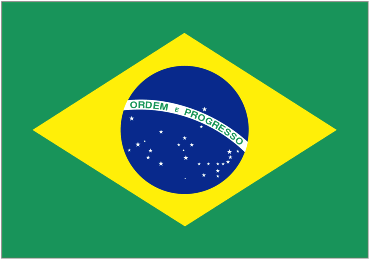
|

 December 4, 1871 -
Re the Geneva Peace Conference:
"An example has thus been set which...may be followed by other civilized nations and finally be the means of returning to productive industry millions of men now maintained to settle the disputes of nations by the bayonet and broadside." -- President Ulysses S. Grant, Message to US Congress. December 4, 1871 -
Re the Geneva Peace Conference:
"An example has thus been set which...may be followed by other civilized nations and finally be the means of returning to productive industry millions of men now maintained to settle the disputes of nations by the bayonet and broadside." -- President Ulysses S. Grant, Message to US Congress.
|
 September 1872 - Hague Congress,
The Hague (Netherlands). The 5th congress of the International Workingmen's Association (IWA). Famous for the expulsion of the anarchists Mikhail Bakunin [1814-1876] and James Guillaume [1844=1916] for clashing with Marx and his followers over the role of politics in the IWA. The congress marks the end of this organization as a unitarian alliance of all socialist factions (Anarchists and Marxists). Anarchists consider the congress null and void. The IWA "was not able to withstand the differences between anarchist and Marxist currents, with the anarchists largely withdrawing after the Hague Congress of 1872. And the First International had wound down entirely by 1876, leading to several attempts to start specifically anarchist Internationals, notably the Anarchist St. Imier International. However the collapse of the Paris Commune in 1871 proved a major setback for the movement, and the rise of "Propaganda of the deed" meant that serious moves to establish an anarcho-syndicalist international would not begin until the early 20th century." [Wikipedia] September 1872 - Hague Congress,
The Hague (Netherlands). The 5th congress of the International Workingmen's Association (IWA). Famous for the expulsion of the anarchists Mikhail Bakunin [1814-1876] and James Guillaume [1844=1916] for clashing with Marx and his followers over the role of politics in the IWA. The congress marks the end of this organization as a unitarian alliance of all socialist factions (Anarchists and Marxists). Anarchists consider the congress null and void. The IWA "was not able to withstand the differences between anarchist and Marxist currents, with the anarchists largely withdrawing after the Hague Congress of 1872. And the First International had wound down entirely by 1876, leading to several attempts to start specifically anarchist Internationals, notably the Anarchist St. Imier International. However the collapse of the Paris Commune in 1871 proved a major setback for the movement, and the rise of "Propaganda of the deed" meant that serious moves to establish an anarcho-syndicalist international would not begin until the early 20th century." [Wikipedia]
 1874 - The Congress for Peace and Liberty met again in Geneva (Switzerland). Victor Hugo, who was invited to attend, this time declined the invitation. He added new reservations to those he had already expressed in 1869. Meanwhile, there had been the Franco-Prussian war, the invasion of France, and the loss of two provinces. Reparation was required. Hence the prime issue was no longer peace, but justice. 'All fraternities are adjourned; where there was hope, there is now menace: we are faced with a whole series of disasters, each of which gives rise to another and must be seen through; there is no stopping now.'" [André Durand, 1996] 1874 - The Congress for Peace and Liberty met again in Geneva (Switzerland). Victor Hugo, who was invited to attend, this time declined the invitation. He added new reservations to those he had already expressed in 1869. Meanwhile, there had been the Franco-Prussian war, the invasion of France, and the loss of two provinces. Reparation was required. Hence the prime issue was no longer peace, but justice. 'All fraternities are adjourned; where there was hope, there is now menace: we are faced with a whole series of disasters, each of which gives rise to another and must be seen through; there is no stopping now.'" [André Durand, 1996]
 October 9, 1874 - Universal Postal Union (UPU), Berne (Switzerland). One of the first 8 international organizations, according to journalist W.T Stead (1898), and one of four to be in Berne. October 9, 1874 - Universal Postal Union (UPU), Berne (Switzerland). One of the first 8 international organizations, according to journalist W.T Stead (1898), and one of four to be in Berne.
|



|  1909 - Weltpostdenkmal / Universal Postal Union Monument, Bern (Switzerland). Bronze & granite. By René de Saint-Marceaux. The five continents join to transmit messages around the globe. 1 of 40 monuments in "Peace Symbols" by Zonia Baber (1948), pp. 30-31. 1909 - Weltpostdenkmal / Universal Postal Union Monument, Bern (Switzerland). Bronze & granite. By René de Saint-Marceaux. The five continents join to transmit messages around the globe. 1 of 40 monuments in "Peace Symbols" by Zonia Baber (1948), pp. 30-31.
|  May 20, 1875 - International Bureau of Weights and Measures (BIPM), Paris (France). One of the first 8 international organizations, according to journalist W.T Stead (1898). "Based at the Pavillon de Breteuil in Sèvres (France), a 4.35 ha site (originally 2.52 ha) granted to the Bureau by the French Government in 1876, where it enjoys extraterritorial status." May 20, 1875 - International Bureau of Weights and Measures (BIPM), Paris (France). One of the first 8 international organizations, according to journalist W.T Stead (1898). "Based at the Pavillon de Breteuil in Sèvres (France), a 4.35 ha site (originally 2.52 ha) granted to the Bureau by the French Government in 1876, where it enjoys extraterritorial status."
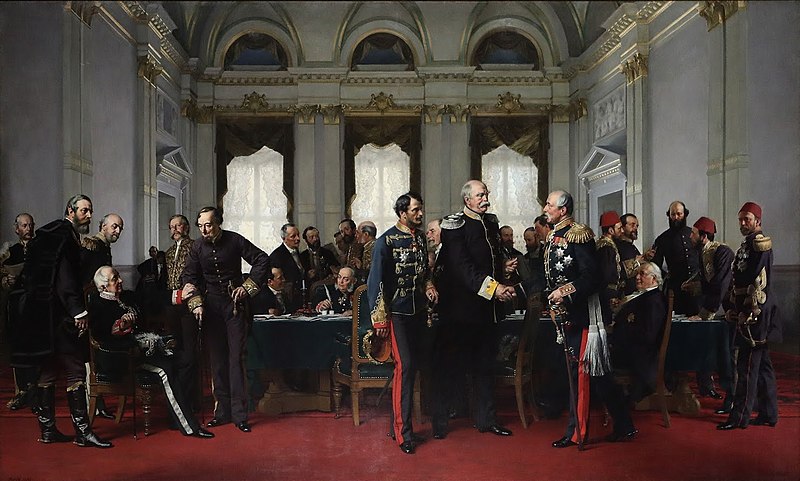
|  June 13-July 13, 1878 - Congress of Berlin, Berlin (Germany). "A meeting of the European Great Powers & the Ottoman Empire. In the wake of the Russo-Turkish War of 1877–78, the meeting's aim was to reorganize the countries of the Balkans. German Chancellor Otto von Bismarck [1815-1898], who led the Congress, undertook to stabilize the Balkans, recognize the reduced power of the Ottoman Empire & balance the distinct interests of Britain, Russia & Austria-Hungary; at the same time he tried to diminish Russian gains in the region & to prevent the rise of a big Bulgaria." /// Image is a 1881 painting by Anton von Werner [1843-1915] showing Bismarck between Gyula Andrássy & Pyotr Shuvalov, on the left Alajos Károlyi, Alexander Gorchakov & Benjamin Disraeli. June 13-July 13, 1878 - Congress of Berlin, Berlin (Germany). "A meeting of the European Great Powers & the Ottoman Empire. In the wake of the Russo-Turkish War of 1877–78, the meeting's aim was to reorganize the countries of the Balkans. German Chancellor Otto von Bismarck [1815-1898], who led the Congress, undertook to stabilize the Balkans, recognize the reduced power of the Ottoman Empire & balance the distinct interests of Britain, Russia & Austria-Hungary; at the same time he tried to diminish Russian gains in the region & to prevent the rise of a big Bulgaria." /// Image is a 1881 painting by Anton von Werner [1843-1915] showing Bismarck between Gyula Andrássy & Pyotr Shuvalov, on the left Alajos Károlyi, Alexander Gorchakov & Benjamin Disraeli.
|

 |
  1880 - Pacifist Hodgson Pratt [1824-1907] founds the International Arbitration & Peace Association (IAPA) in London (England). Pratt worked 14 years for the East India Company and the Bengal government in 1861 and went back to England. After 1880, he visited a number of European cities as IAPA representative, such as Berlin, Frankfurt, Paris, Copenhagen, Stockholm, Budapest, Milan and Rome. In 1883 he was with Henri La Fontaine [1854-1943], the impetus for the Belgian Society for mediation and peace to found [sic]. Together with Franz Napian Wirth [1826-1897] he founded in 1886 Frankfurt Peace Society. ("Bertha von
Suttner learned about the IAPA in 1887, promptly joined, became its leading spokesperson.")
Pratt was nominated in 1906 for the Nobel Peace Prize, but it went instead to US President Theodore Roosevelt. 1880 - Pacifist Hodgson Pratt [1824-1907] founds the International Arbitration & Peace Association (IAPA) in London (England). Pratt worked 14 years for the East India Company and the Bengal government in 1861 and went back to England. After 1880, he visited a number of European cities as IAPA representative, such as Berlin, Frankfurt, Paris, Copenhagen, Stockholm, Budapest, Milan and Rome. In 1883 he was with Henri La Fontaine [1854-1943], the impetus for the Belgian Society for mediation and peace to found [sic]. Together with Franz Napian Wirth [1826-1897] he founded in 1886 Frankfurt Peace Society. ("Bertha von
Suttner learned about the IAPA in 1887, promptly joined, became its leading spokesperson.")
Pratt was nominated in 1906 for the Nobel Peace Prize, but it went instead to US President Theodore Roosevelt.
|
 1882 -
Peace Conference, Brussels (Belgium). Attended by over 500 delegates from many countries. British delegation led by Hodgson Pratt [1824-1907]. Nothing found about this conference except reference in website about Hodgson Pratt. 1882 -
Peace Conference, Brussels (Belgium). Attended by over 500 delegates from many countries. British delegation led by Hodgson Pratt [1824-1907]. Nothing found about this conference except reference in website about Hodgson Pratt.
 1883 - "Bureau which looks after Trademarks and Patents ("intellectural property"), Berne (Switzerland). One of the first 8 international organizations, according to journalist W.T Stead (1898), and one of four to be in Berne. "Its function exended to deal with copyrights in 1886." 1883 - "Bureau which looks after Trademarks and Patents ("intellectural property"), Berne (Switzerland). One of the first 8 international organizations, according to journalist W.T Stead (1898), and one of four to be in Berne. "Its function exended to deal with copyrights in 1886."
 
 |   October-November 1884 - International Meridian Conference, Washington, DC (USA). Twenty-five nations, represented by 41 delegates, met to determine the world's Prime Meridian. "By the end of the difficult summit, Greenwich (England) had won the prize of longitude 0º by a vote of 22 to one, with only San Domingo against and France & Brazil abstaining. One of the main reasons for the British victory over key rivals Washington, Berlin & Paris, was that 72% of the world’s shipping already depended on sea charts that used Greenwich as the Prime Meridian. It was also convenient that Greenwich’s location insured that the 180º meridian, where formally the date line should be located, mostly passed over water." /// Is this the first international conference ever held in Washington, DC? October-November 1884 - International Meridian Conference, Washington, DC (USA). Twenty-five nations, represented by 41 delegates, met to determine the world's Prime Meridian. "By the end of the difficult summit, Greenwich (England) had won the prize of longitude 0º by a vote of 22 to one, with only San Domingo against and France & Brazil abstaining. One of the main reasons for the British victory over key rivals Washington, Berlin & Paris, was that 72% of the world’s shipping already depended on sea charts that used Greenwich as the Prime Meridian. It was also convenient that Greenwich’s location insured that the 180º meridian, where formally the date line should be located, mostly passed over water." /// Is this the first international conference ever held in Washington, DC?
|
 1887 - Unione Lombarda per la Pace e l'Arbitrato / Lombard Association for Peace & Arbitration founded in Italy by Ernesto Teodoro Moneta [1833-1918]. The association called for disarmament and envisaged the creation of a League of Nations. 1887 - Unione Lombarda per la Pace e l'Arbitrato / Lombard Association for Peace & Arbitration founded in Italy by Ernesto Teodoro Moneta [1833-1918]. The association called for disarmament and envisaged the creation of a League of Nations.
  March-April 1888 - Conference sponsored by the International Council of Women (ICW), Washington, DC (USA). The ICW was the first women's organization to work across national boundaries for the common cause of advocating human rights for women. In March-April 1888, women leaders came together with 80 speakers & 49 delegates representing 53 women's organizations from 9 countries: Canada, USA, Ireland, India, England, Finland, Denmark, France & Norway. "Rachel Foster Avery [1858-1919] planned much of the first ICW, & Susan B. Anthony [1820-1906] presided over 8 of the 16 sessions." March-April 1888 - Conference sponsored by the International Council of Women (ICW), Washington, DC (USA). The ICW was the first women's organization to work across national boundaries for the common cause of advocating human rights for women. In March-April 1888, women leaders came together with 80 speakers & 49 delegates representing 53 women's organizations from 9 countries: Canada, USA, Ireland, India, England, Finland, Denmark, France & Norway. "Rachel Foster Avery [1858-1919] planned much of the first ICW, & Susan B. Anthony [1820-1906] presided over 8 of the 16 sessions."
 October 31, 1888 - Inter-Parliamentary Union (IPU), Grand Hôtel, Paris (France). "[The IPU] grew out of a meeting between British & French legislators in Paris in 1888. They agreed to meet on an annual basis & invited legislators from other nations with constitutional forms of government to future conferences to advocate the adoption of arbitration agreements & other pacifist measures in national legislation. Frédéric Passy [1822-1912], Charles Albert Gobat [1843-1914], Bertha von Suttner [1843-1914], Alfred Hermann Fried [1864-1921], and Henri La Fontaine [1854-1943] played major roles in these organizations." Click here for more information. October 31, 1888 - Inter-Parliamentary Union (IPU), Grand Hôtel, Paris (France). "[The IPU] grew out of a meeting between British & French legislators in Paris in 1888. They agreed to meet on an annual basis & invited legislators from other nations with constitutional forms of government to future conferences to advocate the adoption of arbitration agreements & other pacifist measures in national legislation. Frédéric Passy [1822-1912], Charles Albert Gobat [1843-1914], Bertha von Suttner [1843-1914], Alfred Hermann Fried [1864-1921], and Henri La Fontaine [1854-1943] played major roles in these organizations." Click here for more information.
1889 was an important year for the development of the peace movement. Together with French and British parliamentarians, French deputy Frédéric Passy [1822-1912] founded the Inter-Parliamentary Union. Passy in 1889 also chaired the first major international Peace Congress since 1853, in Paris." -- From Santi (1991).

|  June 23-27, 1889 - 1st Universal Peace Congress, Paris (France). Presided over by Jules Simon [1814-1896]. The first major international Peace Congress since 1853. The present peace societies decide to unite under the name of International Union of Peace Societies. First in a series of "Universal Peace Congresses." The series lasts until 1939 (33 congresses at almost annual intervals).
/// N.B. This peace congress was held during the Exposition Universelle de Paris / World's Exposition which took place from 6 May until 31 October 1889. Image is a general view of the expositon (for which the Eifel Tower was constructed). June 23-27, 1889 - 1st Universal Peace Congress, Paris (France). Presided over by Jules Simon [1814-1896]. The first major international Peace Congress since 1853. The present peace societies decide to unite under the name of International Union of Peace Societies. First in a series of "Universal Peace Congresses." The series lasts until 1939 (33 congresses at almost annual intervals).
/// N.B. This peace congress was held during the Exposition Universelle de Paris / World's Exposition which took place from 6 May until 31 October 1889. Image is a general view of the expositon (for which the Eifel Tower was constructed).
|



|
 1889 - First meeting,
Inter-Parliamentary Union / Union Interparlementaire (IPU), Paris (France). "The forerunner of the League of Nations, the IPU was formed by peace activists William Randal Cremer [1828-1908] of the UK & Frédéric Passy [1822-1912] of France. Initially, the organization was for individual parliamentarians, but has since transformed into an international organization of the parliaments of sovereign states. The national parliaments of 143 countries are members, and seven regional parliamentary assemblies are associate members." "The 1889 meeting included representatives from eight nations. Cremer was elected vice-president of the Union & secretary of the British section." Did this happen DURING the 1st Universal Peace Congress? /// Image shows IPU secretariat builting in Geneva (Switzerland). 1889 - First meeting,
Inter-Parliamentary Union / Union Interparlementaire (IPU), Paris (France). "The forerunner of the League of Nations, the IPU was formed by peace activists William Randal Cremer [1828-1908] of the UK & Frédéric Passy [1822-1912] of France. Initially, the organization was for individual parliamentarians, but has since transformed into an international organization of the parliaments of sovereign states. The national parliaments of 143 countries are members, and seven regional parliamentary assemblies are associate members." "The 1889 meeting included representatives from eight nations. Cremer was elected vice-president of the Union & secretary of the British section." Did this happen DURING the 1st Universal Peace Congress? /// Image shows IPU secretariat builting in Geneva (Switzerland).  
|
  October 2, 1889-April 27, 1890 - First International Conference of American States, Wallach Hotel, Washington, DC (USA). "First introduced by [Secretary of State] James G. Blaine [1830-1893] of Maine in order to establish closer ties between the USA & its southern neighbors, specifically Latin America. Blaine hoped that ties between the USA and its southern counterparts would open Latin American markets to US trade." /// Comment Nov. 23, 2011, by Ana Colomar O'Brien, OAS Chief of Protocol: "The purpose of the Organization at its very beginning was the preservation of peace & also of a commercial nature. The US Secretary of State invited in l889 & l890 a large group of Foreign Ministers & high authorities of the Americas to attend a Conference that laid the foundation for the creation of the Pan American Union (PAU) that [in 1948] became the Organization of American States (OAS).
The purpose [of the conference] is still nebulous, but I am inclined to believe because of circumstancial evidence that industrialists in the United States were also looking at the expansion of US markets since some of the [conference] topics had to do with customs, a uniform system of weights & measurement, author’s rights, patents, etc.
Several US industrial barons attended this meeting.
This first meeting that was sponsored by the US government had the following representatives attending (these are only a few names):
Andrew Carnegie [1835-1919],
J. Hanson (considered one of the Kings of Cotton in the USA),
William Henry Trescott [1822-1898] (from South Carolina, connected to maritime interests) & fnu Studebaker." October 2, 1889-April 27, 1890 - First International Conference of American States, Wallach Hotel, Washington, DC (USA). "First introduced by [Secretary of State] James G. Blaine [1830-1893] of Maine in order to establish closer ties between the USA & its southern neighbors, specifically Latin America. Blaine hoped that ties between the USA and its southern counterparts would open Latin American markets to US trade." /// Comment Nov. 23, 2011, by Ana Colomar O'Brien, OAS Chief of Protocol: "The purpose of the Organization at its very beginning was the preservation of peace & also of a commercial nature. The US Secretary of State invited in l889 & l890 a large group of Foreign Ministers & high authorities of the Americas to attend a Conference that laid the foundation for the creation of the Pan American Union (PAU) that [in 1948] became the Organization of American States (OAS).
The purpose [of the conference] is still nebulous, but I am inclined to believe because of circumstancial evidence that industrialists in the United States were also looking at the expansion of US markets since some of the [conference] topics had to do with customs, a uniform system of weights & measurement, author’s rights, patents, etc.
Several US industrial barons attended this meeting.
This first meeting that was sponsored by the US government had the following representatives attending (these are only a few names):
Andrew Carnegie [1835-1919],
J. Hanson (considered one of the Kings of Cotton in the USA),
William Henry Trescott [1822-1898] (from South Carolina, connected to maritime interests) & fnu Studebaker."
|
 1890 - Union of International Railways, Berne (Switzerland). One of the first 8 international organizations, according to journalist W.T Stead (1898), and one of four to be in Berne. 1890 - Union of International Railways, Berne (Switzerland). One of the first 8 international organizations, according to journalist W.T Stead (1898), and one of four to be in Berne.
|
 July 2, 1890 - Brussels Conference Act of 1890 signed in Brussels (Belgium). Full title "Convention Relative to the Slave Trade & Importation into Africa of Firearms, Ammunition & Spiritous Liquors." "A collection of anti-slavery measures putting 'an end to Negro Slave Trade by land as well as by sea, and to improve the moral and material conditions of existence of the native races... specifically applicable to those countries who have possessions or Protectorates in the conventional basin of the Congo,' to the Ottoman Empire and other powers or parts who were involved in slave trade in East African coast, Indian Ocean and other areas...
The parties to the agreement were the United Kingdom, France, the German Empire, the Kingdom of Portugal, the Congo Free State, the Kingdom of Italy, Spain, the Netherlands, Belgium, the Russian Empire, Austria-Hungary, Sweden-Norway, Denmark, the United States, the Ottoman Empire, Zanzibar, and Persia." July 2, 1890 - Brussels Conference Act of 1890 signed in Brussels (Belgium). Full title "Convention Relative to the Slave Trade & Importation into Africa of Firearms, Ammunition & Spiritous Liquors." "A collection of anti-slavery measures putting 'an end to Negro Slave Trade by land as well as by sea, and to improve the moral and material conditions of existence of the native races... specifically applicable to those countries who have possessions or Protectorates in the conventional basin of the Congo,' to the Ottoman Empire and other powers or parts who were involved in slave trade in East African coast, Indian Ocean and other areas...
The parties to the agreement were the United Kingdom, France, the German Empire, the Kingdom of Portugal, the Congo Free State, the Kingdom of Italy, Spain, the Netherlands, Belgium, the Russian Empire, Austria-Hungary, Sweden-Norway, Denmark, the United States, the Ottoman Empire, Zanzibar, and Persia."
|
 Date? - Bureau concerned with the supression of the slave trade, Brussels (Belgium). One of the first 8 international organizations, according to journalist W.T Stead (1898). Date? - Bureau concerned with the supression of the slave trade, Brussels (Belgium). One of the first 8 international organizations, according to journalist W.T Stead (1898).
|
 July 5, 1890 - International Office for the Publication of Tariffs, Brussels (Belgium). One of the first 8 international organizations, according to journalist W.T Stead (1898). July 5, 1890 - International Office for the Publication of Tariffs, Brussels (Belgium). One of the first 8 international organizations, according to journalist W.T Stead (1898).
|  Date? - Bureau Géodésique, Berlin (Germany). One of the first 8 international organizations, according to journalist W.T Stead (1898). Related to the Prussian Geodetic Institute in Potsdam? Date? - Bureau Géodésique, Berlin (Germany). One of the first 8 international organizations, according to journalist W.T Stead (1898). Related to the Prussian Geodetic Institute in Potsdam?
|
  July 14-19, 1890 - 2nd Universal Peace Congress, London (England). "Hodgson Pratt [1824-1907] was Chairman of the 2nd World Peace Congress in London." "There was a need for a permanent institution to organise the Congresses, and to represent the peace movement internationally. Fredrik Bajer [1837-1922] of Denmark first proposed a Peace Bureau at the London Congress. A committee was appointed to make a detailed proposal." July 14-19, 1890 - 2nd Universal Peace Congress, London (England). "Hodgson Pratt [1824-1907] was Chairman of the 2nd World Peace Congress in London." "There was a need for a permanent institution to organise the Congresses, and to represent the peace movement internationally. Fredrik Bajer [1837-1922] of Denmark first proposed a Peace Bureau at the London Congress. A committee was appointed to make a detailed proposal."
|

 |   November 24-25, 1890 - Conference on the Past, Present & Future of Israel, First Methodist Episcopal Church, Chicago, Illinois (USA). Organized by William Eugene Blackstone [1841-1935], a prominent "Christian Restorationist." Participants included leaders of many Christian communities. Resolutions of sympathy for the oppressed Jews living in Russia were passed, but Blackstone was convinced that such resolutions - even though passed by prominent men - were insufficient. He advocated strongly for the resettlement of Jewish people in Palestine [lower image]. Accordingly, the Blackstone Memorial of 1891 was drafted as a petition signed by 413 prominent Americans. It read, in part: "Why shall not the powers which under the treaty of Berlin, in 1878, gave Bulgaria to the Bulgarians & Servia to the Servians now give Palestine back to the Jews?... These provinces, as well as Romania, Montenegro & Greece, were wrested from the Turks and given to their natural owners. Does not Palestine as rightfully belong to the Jews?" November 24-25, 1890 - Conference on the Past, Present & Future of Israel, First Methodist Episcopal Church, Chicago, Illinois (USA). Organized by William Eugene Blackstone [1841-1935], a prominent "Christian Restorationist." Participants included leaders of many Christian communities. Resolutions of sympathy for the oppressed Jews living in Russia were passed, but Blackstone was convinced that such resolutions - even though passed by prominent men - were insufficient. He advocated strongly for the resettlement of Jewish people in Palestine [lower image]. Accordingly, the Blackstone Memorial of 1891 was drafted as a petition signed by 413 prominent Americans. It read, in part: "Why shall not the powers which under the treaty of Berlin, in 1878, gave Bulgaria to the Bulgarians & Servia to the Servians now give Palestine back to the Jews?... These provinces, as well as Romania, Montenegro & Greece, were wrested from the Turks and given to their natural owners. Does not Palestine as rightfully belong to the Jews?" |

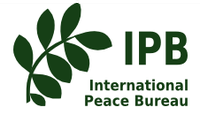

|  November 11-16, 1891 - 3rd Universal Peace Congress, Rome (Italy). "Hodgson Pratt [1824-1907] was also co-founded by him during Kommissonsmitglied of the [3rd] World Peace Congress 1891 in Rome Bureau International Permanent de la Paix, which was based in Bern (Switzerland)." The Permanent International Peace Bureau (IPB), the recepient of the Nobel Peace Prize in 1910, was established at the Third Universal Peace Congress at Rome in 1891. It became the clearinghouse for information about the peace movement and now is affiliated with the United Nations. "The 3rd congress decided to create the 'Permanent International Peace Bureau' (IPB) as the executive office of the 'International Union of Peace Societies'." -- From Santi (1991). /// First peace congress attended by Bertha von Suttner (beginning her 25 years of "indefatigable peace activism"). November 11-16, 1891 - 3rd Universal Peace Congress, Rome (Italy). "Hodgson Pratt [1824-1907] was also co-founded by him during Kommissonsmitglied of the [3rd] World Peace Congress 1891 in Rome Bureau International Permanent de la Paix, which was based in Bern (Switzerland)." The Permanent International Peace Bureau (IPB), the recepient of the Nobel Peace Prize in 1910, was established at the Third Universal Peace Congress at Rome in 1891. It became the clearinghouse for information about the peace movement and now is affiliated with the United Nations. "The 3rd congress decided to create the 'Permanent International Peace Bureau' (IPB) as the executive office of the 'International Union of Peace Societies'." -- From Santi (1991). /// First peace congress attended by Bertha von Suttner (beginning her 25 years of "indefatigable peace activism").
|
 December 1, 1891 - Bern (Switzerland). The formal establishment of the International Peace Bureau (IPB) was on December 1st 1891 in Bern (Switzerland). December 1, 1891 - Bern (Switzerland). The formal establishment of the International Peace Bureau (IPB) was on December 1st 1891 in Bern (Switzerland).
 August 22-27, 1892 - 4th Universal Peace Congress, Bern (Switzerland).
"The rules and the Council were approved and elected. Dane Fredrik Bajer [1837-1922] became the first IPB president. The IPB was a unique effort within the whole peace movement, the radical, as well as liberal and conservative elements coming together in one organisation. The founders of the two Leagues for Peace (and Freedom) joined in the IPB, as did pacifists and anti-militarists. Liberal pacifism remained the core of the programme for the peace movement and the IPB, but an on-going debate about it remained. The 4th congress called for the convocation of a conference of the European powers on mutual, balanced & simultaneous disarmament. The IPB started on a modest level, with the publication of its journal, the Correspondence autographiée. It had a circulation of 100 copies.
The IPB was now charged with the organisation of the Universal Peace Congresses. They were held in Chicago in 1893, Antwerp in 1894, and in Budapest in 1896. A bimonthly bulletin replaced the journal, and had a print run of 3000 copies. The membership of the IPB increased quickly. In 1895 65 peace societies in 12 countries belonged to the Bureau. In 1897 they were 88 societies in 14 countries." -- From Santi (1991).
/// "In 1892, we proceeded to Bern... From the US Dr. Trublood, president of the Boston Peace Society (founded in 1816) was there. Ducommun was in the chair at the second session... Hodgson Pratt brought an interesting piece of information: the President of the US had...expressed the wish to have permanent arbitration treaties concluded with all other nations..." -- From memoirs of Bertha von Suttner (1910). August 22-27, 1892 - 4th Universal Peace Congress, Bern (Switzerland).
"The rules and the Council were approved and elected. Dane Fredrik Bajer [1837-1922] became the first IPB president. The IPB was a unique effort within the whole peace movement, the radical, as well as liberal and conservative elements coming together in one organisation. The founders of the two Leagues for Peace (and Freedom) joined in the IPB, as did pacifists and anti-militarists. Liberal pacifism remained the core of the programme for the peace movement and the IPB, but an on-going debate about it remained. The 4th congress called for the convocation of a conference of the European powers on mutual, balanced & simultaneous disarmament. The IPB started on a modest level, with the publication of its journal, the Correspondence autographiée. It had a circulation of 100 copies.
The IPB was now charged with the organisation of the Universal Peace Congresses. They were held in Chicago in 1893, Antwerp in 1894, and in Budapest in 1896. A bimonthly bulletin replaced the journal, and had a print run of 3000 copies. The membership of the IPB increased quickly. In 1895 65 peace societies in 12 countries belonged to the Bureau. In 1897 they were 88 societies in 14 countries." -- From Santi (1991).
/// "In 1892, we proceeded to Bern... From the US Dr. Trublood, president of the Boston Peace Society (founded in 1816) was there. Ducommun was in the chair at the second session... Hodgson Pratt brought an interesting piece of information: the President of the US had...expressed the wish to have permanent arbitration treaties concluded with all other nations..." -- From memoirs of Bertha von Suttner (1910).
|
 1893 - "Tobias Asser's Hague Conference on Private International Law opened the international era in The Hague (Netherlands)." 1893 - "Tobias Asser's Hague Conference on Private International Law opened the international era in The Hague (Netherlands)."
|
  August 14-20, 1893 - 5th Universal Peace Congress, Chicago, Illinois (USA). Concurrent with the World Columbian Exposition (Chicago World's Fair). August 14-20, 1893 - 5th Universal Peace Congress, Chicago, Illinois (USA). Concurrent with the World Columbian Exposition (Chicago World's Fair).
|
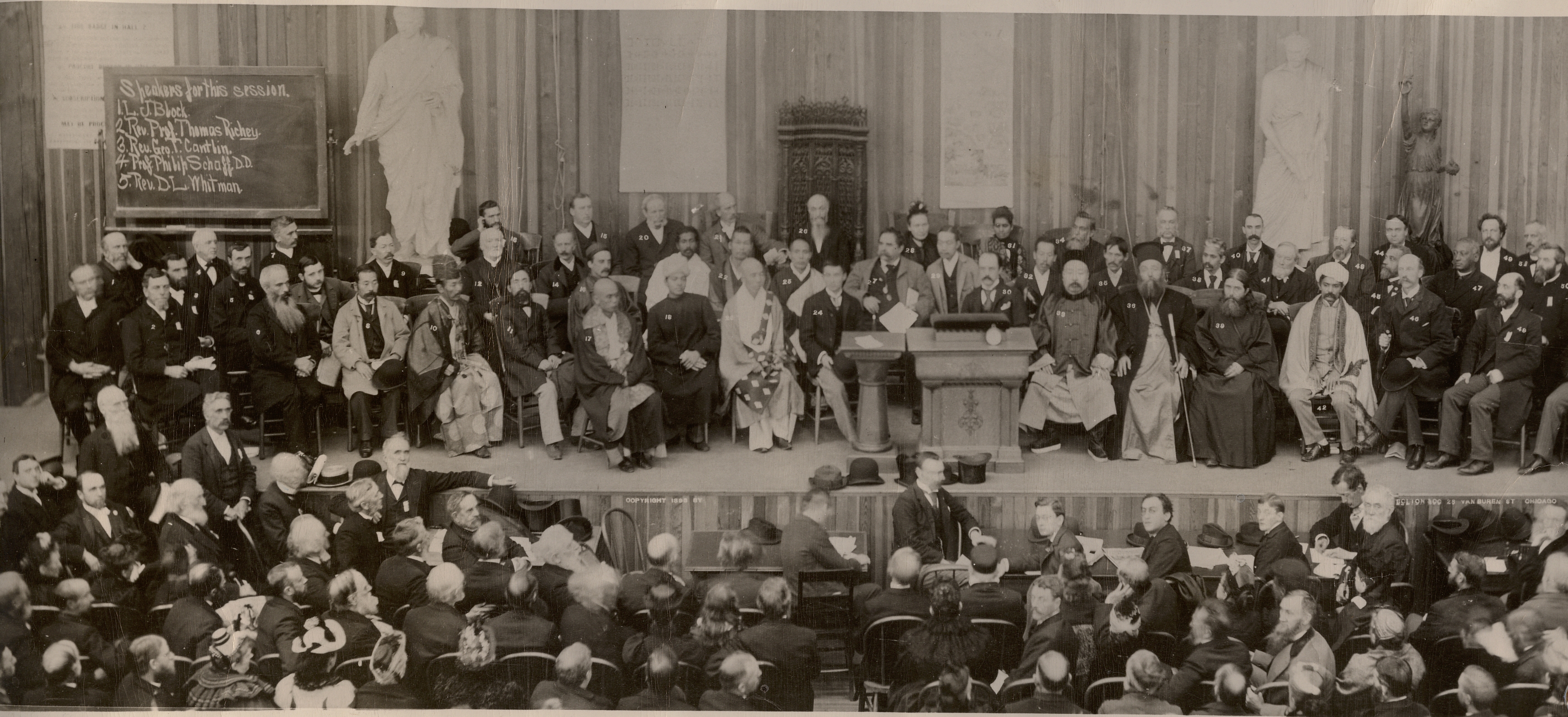
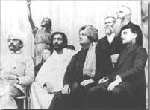
|   September 11-27, 1893 - First Parliament of the World's Religions, Chicago, Illinois (USA). Concurrent with the World Columbian Exposition (Chicago World's Fair). Attended by 4,000 delegates from all over the World. Organized by Unitarian minister Reverend Jenkin Lloyd Jones [1843-1918]. Addresses included an introducton to Hinduism by Swami Vivekananda [1863-1902] and "The Religious Mission of the Colored Race"
by Fannie Barrier Williams [1855-1944], a black member of Jones's Unitarian church in Chicago. Attended by 75-year-old Frederick Douglass [c1818-1895]. September 11-27, 1893 - First Parliament of the World's Religions, Chicago, Illinois (USA). Concurrent with the World Columbian Exposition (Chicago World's Fair). Attended by 4,000 delegates from all over the World. Organized by Unitarian minister Reverend Jenkin Lloyd Jones [1843-1918]. Addresses included an introducton to Hinduism by Swami Vivekananda [1863-1902] and "The Religious Mission of the Colored Race"
by Fannie Barrier Williams [1855-1944], a black member of Jones's Unitarian church in Chicago. Attended by 75-year-old Frederick Douglass [c1818-1895].
|   1988 - Council for a Parliament of the World's Religions, Chicago, Illinois (USA). Created to sponsor a centennial conference in 1993. Additional conferencs have been in Chicago (1993), Cape Town (1999), Barcelona (2004), Monterey (2007) & Melbourne (2009). 1988 - Council for a Parliament of the World's Religions, Chicago, Illinois (USA). Created to sponsor a centennial conference in 1993. Additional conferencs have been in Chicago (1993), Cape Town (1999), Barcelona (2004), Monterey (2007) & Melbourne (2009).


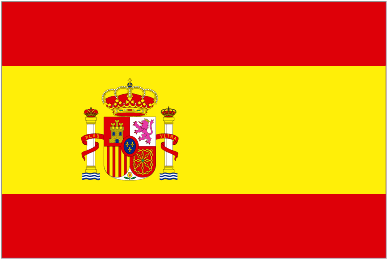

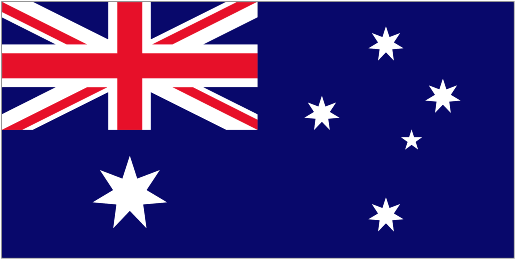
|
 |  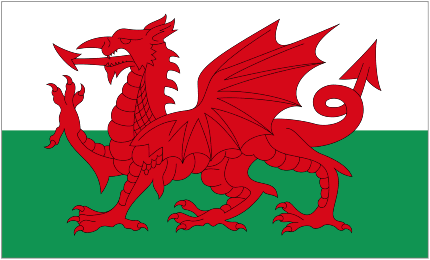 August 18, 1893 - Henry Richard Statue, Tregaron, Cardiganshire (Wales). By Albert Toft." Henry Richard [1812-1888] was born in Tregaron. He was a Nonconformist minister in London before being elected the Liberal Member of Parliament for Merthyr Tydfil in 1868. He was known as 'The Apostle of Peace' in recognition of his work as secretary of the Peace Society [1848-1884]." One of 13 sites on the MAW Peace Map of the British Isles as of January 2009. (N.B.: "Apostle of Peace" also used on plaque for W.T. Stead [1849-1912] in Embleton (England) 327 road miles from Tregaron.) August 18, 1893 - Henry Richard Statue, Tregaron, Cardiganshire (Wales). By Albert Toft." Henry Richard [1812-1888] was born in Tregaron. He was a Nonconformist minister in London before being elected the Liberal Member of Parliament for Merthyr Tydfil in 1868. He was known as 'The Apostle of Peace' in recognition of his work as secretary of the Peace Society [1848-1884]." One of 13 sites on the MAW Peace Map of the British Isles as of January 2009. (N.B.: "Apostle of Peace" also used on plaque for W.T. Stead [1849-1912] in Embleton (England) 327 road miles from Tregaron.)
|

 June 23, 1894 - Founding Congress of the International Olympic Committee (IOC), a corporation based in Lausanne (Switzerland). Organized by Greek businessman Demetrios Vikelas [1836-1908] and French historian Pierre de Coubertin [1863-1937]. de Coubertin invited British pacifist Hodgson Pratt [1824-1907] to participate as an "honorary member" of the congress.
June 23, 1894 - Founding Congress of the International Olympic Committee (IOC), a corporation based in Lausanne (Switzerland). Organized by Greek businessman Demetrios Vikelas [1836-1908] and French historian Pierre de Coubertin [1863-1937]. de Coubertin invited British pacifist Hodgson Pratt [1824-1907] to participate as an "honorary member" of the congress. 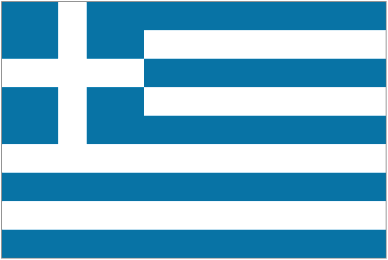 
| M
U
SE
U
M | 
|  June 23, 1993 - Musée olympique / Olympic Museum & Olympic Studies Centre, Lausanne (Switzerland). "Lausanne's main permanent attraction." Preceded by a succession of older & smaller museums. June 23, 1993 - Musée olympique / Olympic Museum & Olympic Studies Centre, Lausanne (Switzerland). "Lausanne's main permanent attraction." Preceded by a succession of older & smaller museums.
|
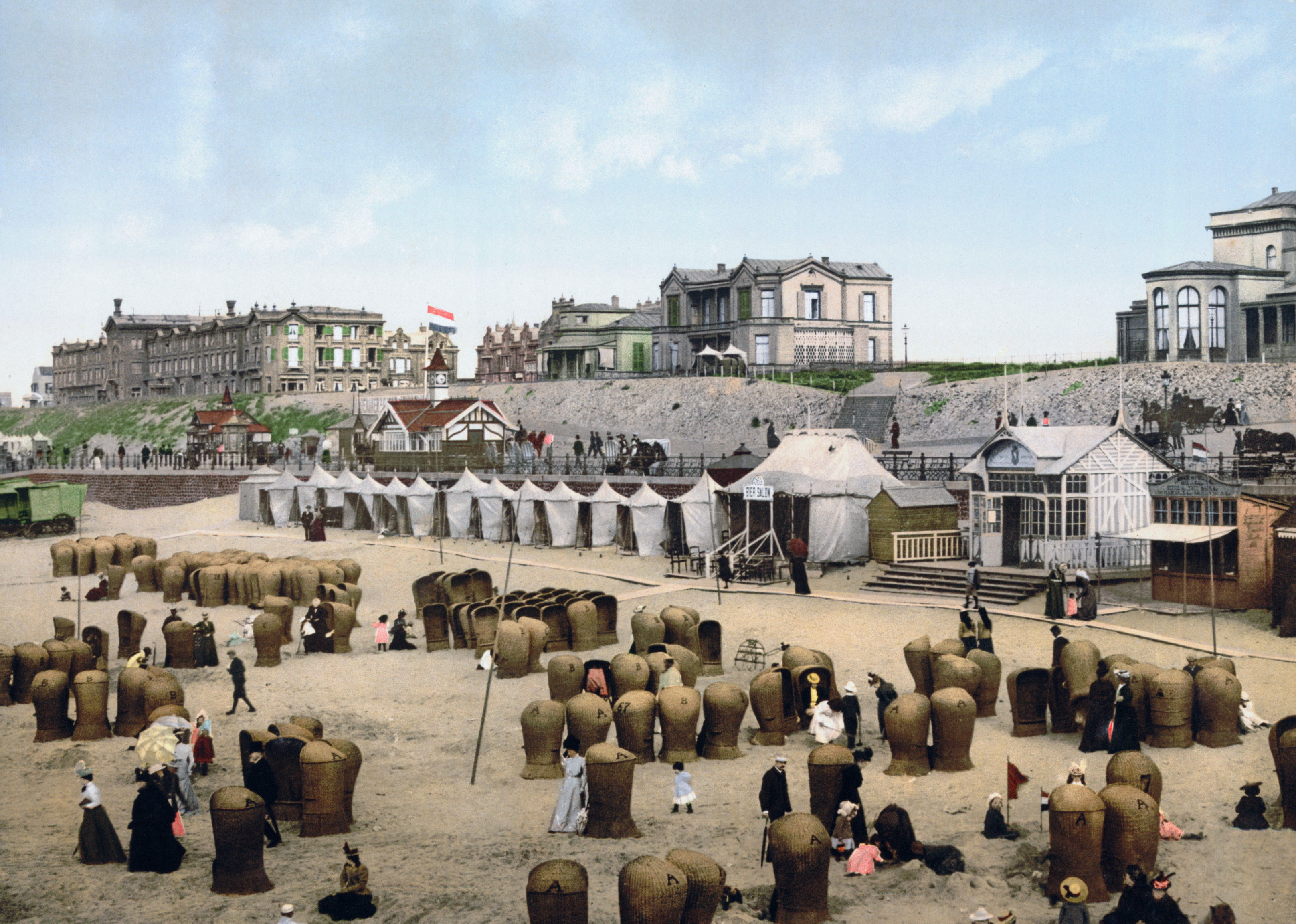 |
 September 6, 1894 - 5ieme Conmference intrparlementaire pour l'Arbitrage et la Paix / Fifth Congress of the Interparliamentary Union, in assembly hall of the First Chamber (Upper House) of the States-General, The Hague (Netherlands). "In the weeks following the Sixth Conference of Pacifism & at the personal invitation of Minister of Interior van Houten, Bertha & Artur von Suttner attended [this congress]. She was, as ever, enthralled by Frédéric Passy [1822-1912]. However, the British MP, Philip James Stanhope [1847-1923] (the later Lord Weardale) who was to be twice President of the Interparliamentary Conferences (1890; 1906) also much impressed her." Bertha "saw Scheveningen when the bathing season was in full swing..." Image shows beach at Scheveningen in 1900. September 6, 1894 - 5ieme Conmference intrparlementaire pour l'Arbitrage et la Paix / Fifth Congress of the Interparliamentary Union, in assembly hall of the First Chamber (Upper House) of the States-General, The Hague (Netherlands). "In the weeks following the Sixth Conference of Pacifism & at the personal invitation of Minister of Interior van Houten, Bertha & Artur von Suttner attended [this congress]. She was, as ever, enthralled by Frédéric Passy [1822-1912]. However, the British MP, Philip James Stanhope [1847-1923] (the later Lord Weardale) who was to be twice President of the Interparliamentary Conferences (1890; 1906) also much impressed her." Bertha "saw Scheveningen when the bathing season was in full swing..." Image shows beach at Scheveningen in 1900.
|
 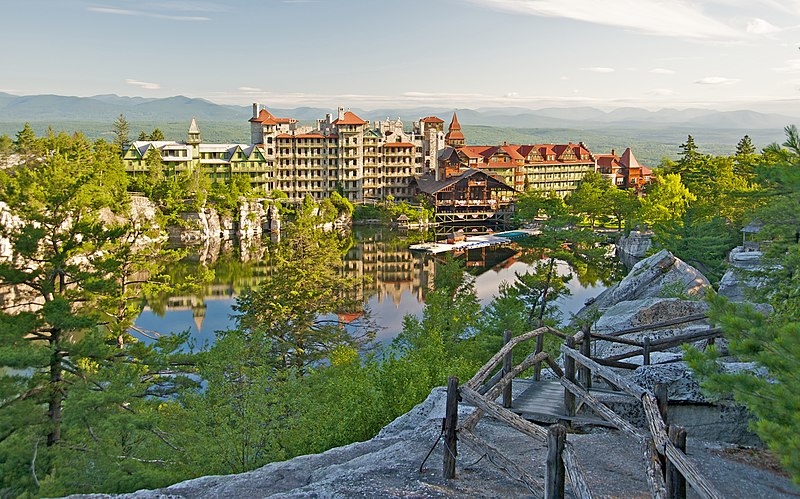
| C
O
N
F
E
R
E
N
C
E |   June 1895 -
First Lake Mohonk Conference on International Arbitration, Mohonk Mountain House, Lake Mohonk, New Paltz, Ulster County, New York (USA). Convened "to support the cause of international arbitration, arbitration treaties & an international court, and to generate public support on behalf of the cause. Fifty individuals selected by Albert K. Smiley [1828-1912], a Quaker and the owner of the Mohonk Mountain House, one of the most prestigious summer resorts of the day, attended the initial sessions at the resort. [The 2nd Mohonk conference was held in June 1896 & the third in June 1897.] Annual conferences soon grew to attract 300 leaders of government, business, religion, the press & education. It was one of the stops of `Abdu'l-Bahá's journeys to the West. After Albert Smiley's death in December 1912, his place as host of the Conferences was taken by his half-brother Daniel Smiley. The last conference was held in 1916. Plans for a 1917 conference were made, but it was never held, partly due to World War I. These meetings were instrumental in the creation of the Permanent Court of Arbitration in The Hague (Netherlands) [in 1899]. // From House website: "The Lake Mohonk Conferences on International Arbitration began in 1895 as an attempt to seek world peace. The conferences are credited with having given impetus to the Hague Conference movement, the World Peace Foundation & the League to Enforce Peace. Hundreds of well-known people attended the peace conferences between 1895 and 1916 including William Jennings Bryan & William Howard Taft. It was through his contact and friendship with the Smileys at Mohonk that Andrew Carnegie founded the Carnegie Endowment for International Peace, with Albert K. Smiley as one of its original trustees." //
The conference papers were later donated by the Smiley Family to Swarthmore College for study & research." // `Abdu'l-Bahá [1844-1921] was head of the Bahá'íFaith. See Peace Conference in May 1912. /// From Peter van den Dungen, August 2, 20ll: "The Lake Mohonk conferences were a most interesting annual event. On my
shelves in hand-reach is a full set of the printed reports of the 22
conferences, together with a most useful analytical 'Index of the
proceedings of the Lake Mohonk Conferences on International Arbitration
1895-1914'. I am not sure whether anyone has written their history." June 1895 -
First Lake Mohonk Conference on International Arbitration, Mohonk Mountain House, Lake Mohonk, New Paltz, Ulster County, New York (USA). Convened "to support the cause of international arbitration, arbitration treaties & an international court, and to generate public support on behalf of the cause. Fifty individuals selected by Albert K. Smiley [1828-1912], a Quaker and the owner of the Mohonk Mountain House, one of the most prestigious summer resorts of the day, attended the initial sessions at the resort. [The 2nd Mohonk conference was held in June 1896 & the third in June 1897.] Annual conferences soon grew to attract 300 leaders of government, business, religion, the press & education. It was one of the stops of `Abdu'l-Bahá's journeys to the West. After Albert Smiley's death in December 1912, his place as host of the Conferences was taken by his half-brother Daniel Smiley. The last conference was held in 1916. Plans for a 1917 conference were made, but it was never held, partly due to World War I. These meetings were instrumental in the creation of the Permanent Court of Arbitration in The Hague (Netherlands) [in 1899]. // From House website: "The Lake Mohonk Conferences on International Arbitration began in 1895 as an attempt to seek world peace. The conferences are credited with having given impetus to the Hague Conference movement, the World Peace Foundation & the League to Enforce Peace. Hundreds of well-known people attended the peace conferences between 1895 and 1916 including William Jennings Bryan & William Howard Taft. It was through his contact and friendship with the Smileys at Mohonk that Andrew Carnegie founded the Carnegie Endowment for International Peace, with Albert K. Smiley as one of its original trustees." //
The conference papers were later donated by the Smiley Family to Swarthmore College for study & research." // `Abdu'l-Bahá [1844-1921] was head of the Bahá'íFaith. See Peace Conference in May 1912. /// From Peter van den Dungen, August 2, 20ll: "The Lake Mohonk conferences were a most interesting annual event. On my
shelves in hand-reach is a full set of the printed reports of the 22
conferences, together with a most useful analytical 'Index of the
proceedings of the Lake Mohonk Conferences on International Arbitration
1895-1914'. I am not sure whether anyone has written their history."
|

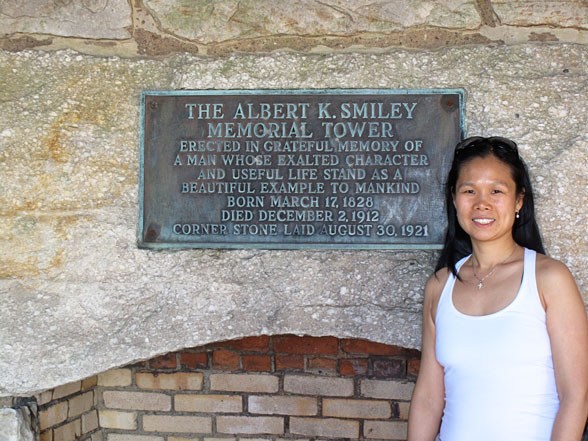
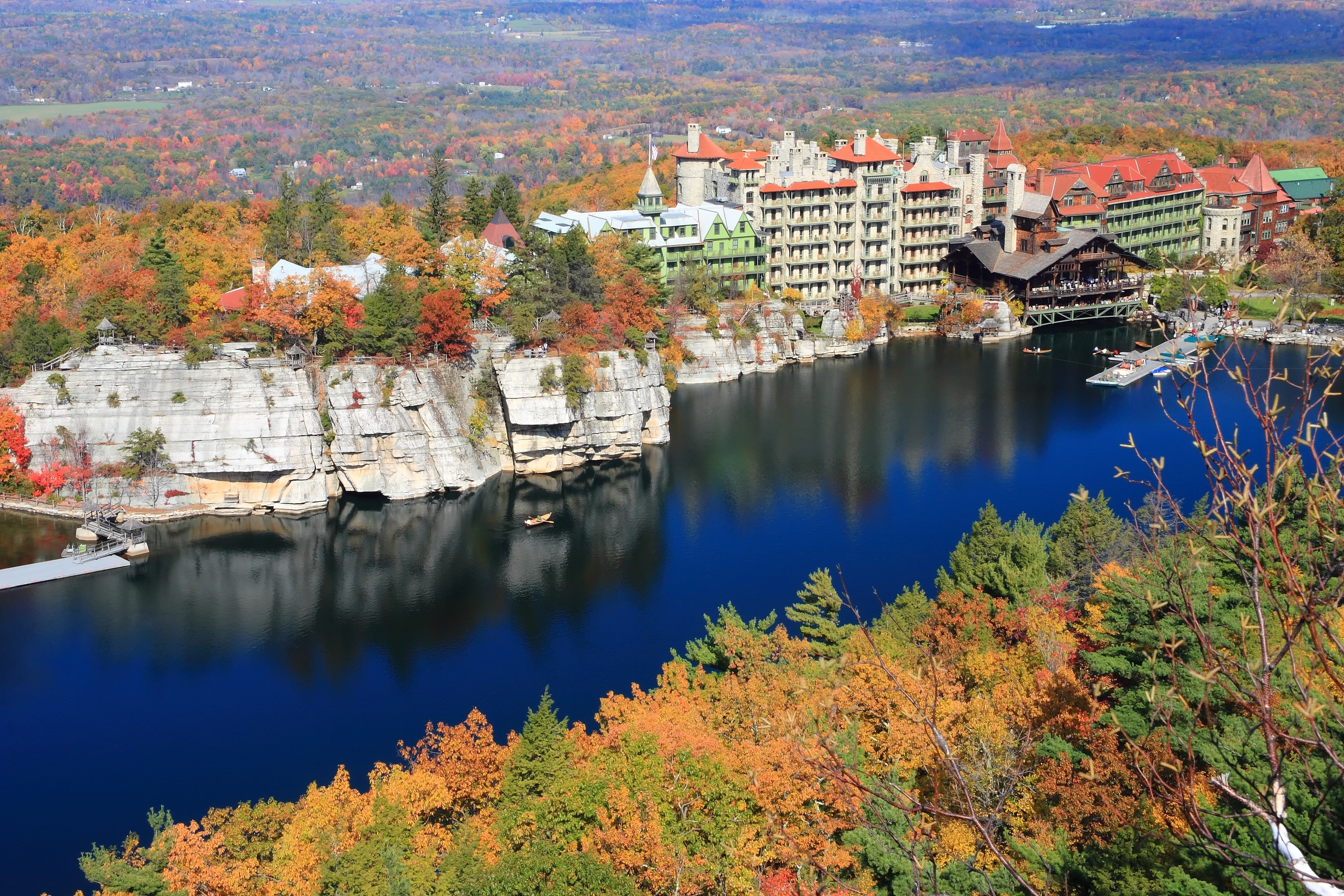
![]()
|   August 30, 1921 - Albert K. Smiley Memorial Tower, Sky Top Mohonk, above Mohonk Mountain House, New Paltz, New York (USA). In Shawangunk Mountains. "Smiley's Quaker beliefs led him to...the cause of peace. In 1895, he convened the first of many annual conferences on International Arbitration, held at Mohonk Mountain House. Their purpose was to provide a forum for national & international leaders to meet & discuss world problems in an effort to find alternatives to war. The conferences continued through 1916, & included notable attendees such as President William Howard Taft, William Jennings Bryan & Secretaries of State of successive administrations. These conferences highlighted a concern for peaceful conflict resolution that has been credited with giving impetus to the Hague Conference movement. The United Nations of today can trace its roots back to the Hague Conferences." Click here for source of this information. /// On April 20, 2017, we tried to drive to the hotel, but a guard refused our entry because we did not have a hotel reservation. He gave us a glossy brochure which does not mention the historic peace conferences or the Albert K. Smiley Mamorial Tower. August 30, 1921 - Albert K. Smiley Memorial Tower, Sky Top Mohonk, above Mohonk Mountain House, New Paltz, New York (USA). In Shawangunk Mountains. "Smiley's Quaker beliefs led him to...the cause of peace. In 1895, he convened the first of many annual conferences on International Arbitration, held at Mohonk Mountain House. Their purpose was to provide a forum for national & international leaders to meet & discuss world problems in an effort to find alternatives to war. The conferences continued through 1916, & included notable attendees such as President William Howard Taft, William Jennings Bryan & Secretaries of State of successive administrations. These conferences highlighted a concern for peaceful conflict resolution that has been credited with giving impetus to the Hague Conference movement. The United Nations of today can trace its roots back to the Hague Conferences." Click here for source of this information. /// On April 20, 2017, we tried to drive to the hotel, but a guard refused our entry because we did not have a hotel reservation. He gave us a glossy brochure which does not mention the historic peace conferences or the Albert K. Smiley Mamorial Tower.
| 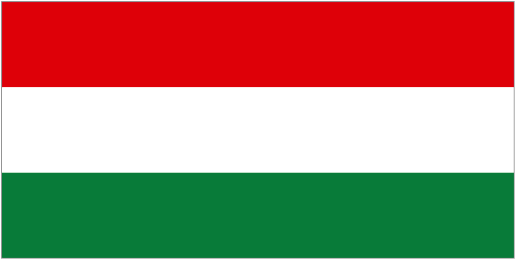 September 17-22, 1896 - 7th Universal Peace Congress, Budapest (Hungary). September 17-22, 1896 - 7th Universal Peace Congress, Budapest (Hungary).
 December 10, 1896 - Death of Alfred Nobel, San Remo (Italy). Alfred Nobel [1833-1896] was a Swedish chemist, engineer, innovator, armaments manufacturer, and inventor of dynamite. In his last will, he used his enormous fortune to institute the Nobel Prizes. His memorial service was conducted by Nathan Söderblom [1866-1931] who knew Nobel in Paris and would later become professor of the history of religions in Leipzig (Germany) & archbishop of Uppsala (Sweden). The first Nobel Peace Prize was awarded in 1901. December 10, 1896 - Death of Alfred Nobel, San Remo (Italy). Alfred Nobel [1833-1896] was a Swedish chemist, engineer, innovator, armaments manufacturer, and inventor of dynamite. In his last will, he used his enormous fortune to institute the Nobel Prizes. His memorial service was conducted by Nathan Söderblom [1866-1931] who knew Nobel in Paris and would later become professor of the history of religions in Leipzig (Germany) & archbishop of Uppsala (Sweden). The first Nobel Peace Prize was awarded in 1901.


| 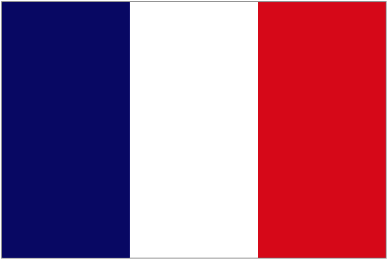 1897 - "Les Grands Artisans de L'Arbitrage et de la Paix / The Great Artisans of Arbitrage and Peace" by French artist Henri-Camille Danger [1857-1937]. Where is the original mural? From Arthur Eyffinger (1999), p. 335: "Among contemporary peace leaders, one recognizes Mancini, Frederic Passy, the Baroness von Suttner, Bajer and Nobel. The work was highly acclaimed in its day." /// From Arthur Eyffinger (2013), p. 122: "Intriguingly, on the great mural...which depicts the history of [arbitrage] through the ages and was a kind of echo of Raphael's 'School of Athens' (1510), Bertha von Suttner [1843-1914] is the only woman to be represented." 1897 - "Les Grands Artisans de L'Arbitrage et de la Paix / The Great Artisans of Arbitrage and Peace" by French artist Henri-Camille Danger [1857-1937]. Where is the original mural? From Arthur Eyffinger (1999), p. 335: "Among contemporary peace leaders, one recognizes Mancini, Frederic Passy, the Baroness von Suttner, Bajer and Nobel. The work was highly acclaimed in its day." /// From Arthur Eyffinger (2013), p. 122: "Intriguingly, on the great mural...which depicts the history of [arbitrage] through the ages and was a kind of echo of Raphael's 'School of Athens' (1510), Bertha von Suttner [1843-1914] is the only woman to be represented." |  | Damaged steel engraving which blongs to the Swarthmore College Peace Collection & is labeled "Given to Benjamin Trueblood [1847-1916]."
|
 |
 August 29-31, 1897 - First Zionist Congress, Basel (Switzerland). Convened & chaired by Theodor Herzl [1860-1904], founder of the modern Zionism movement. Formulated a Zionist platform, known as the Basle program, and founded the Zionist Organization. Also adopted the Hatikvah as its anthem (already the anthem of Hovevei Zion & later to become the national anthem of the State of Israel).
August 29-31, 1897 - First Zionist Congress, Basel (Switzerland). Convened & chaired by Theodor Herzl [1860-1904], founder of the modern Zionism movement. Formulated a Zionist platform, known as the Basle program, and founded the Zionist Organization. Also adopted the Hatikvah as its anthem (already the anthem of Hovevei Zion & later to become the national anthem of the State of Israel).
| 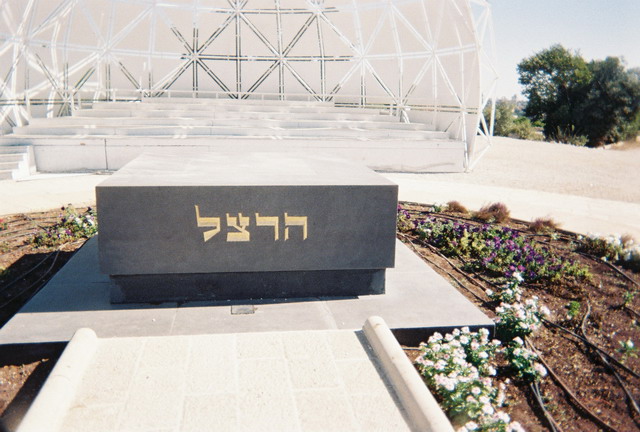
|
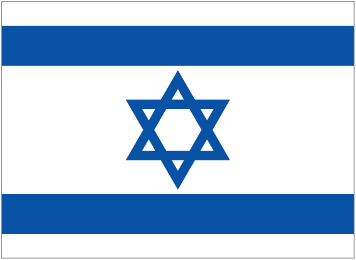 1949 - Grave of Theodor Herzl, Mount Herzl, Jerusalem (Israel). When Herzl died in 1904, he was interred in Vienna. It was only in 1949, 45 years later, that Herzl's remains were brought to Israel and reinterred in Jerusalem. Mount Herzl is Israel's national cemetery on the west side of Jerusalem. Herzl's tomb lies at the top of the hill. Israel's war dead are also buried there.
Yad Vashem, which commemorates the Holocaust, lies just to the west of Mount Herzl. 1949 - Grave of Theodor Herzl, Mount Herzl, Jerusalem (Israel). When Herzl died in 1904, he was interred in Vienna. It was only in 1949, 45 years later, that Herzl's remains were brought to Israel and reinterred in Jerusalem. Mount Herzl is Israel's national cemetery on the west side of Jerusalem. Herzl's tomb lies at the top of the hill. Israel's war dead are also buried there.
Yad Vashem, which commemorates the Holocaust, lies just to the west of Mount Herzl.
|


 | C
O
N
F
E
R
E
N
C
E |  May 18-July 29, 1899 - First Hague Peace Conference, Orange Hall/Oranjezaal, Huis ten Bosch/House in the Wood, The Hague (Netherlands). "The 18th of May, 1899! This is an epochal date in the history of the world. Peace Conference! For ten long years the words and the idea have been laughed to scorn..." [from diary of Bertha von Suttner]. "Not driven by the sudden conversion of Europe's rulers to pacifism, but by Russia's desire to escape the crushing burden of keeping up with Germany and England's armament pace in Western Europe. Although certain idealistic motives played roles, no progress was made on disarmament at the end of each day.
Nevertheless, the Conference was not without important results: First, it produced a convention for the Pacific Settlement of Disputes -- which resulted in the establishment of the first international organization, the Permanent Court of
Arbitration [PCA]; secondly, an issue on Laws and Customs of War on Land known as 'The Hague Convention' -- which remains as the most important source of humanitarian law today; & a third concerning Maritime Warfare. The conference adopted "Declarations" to the effect that throwing projectiles from balloons & other aircraft had an indiscriminate effect on civilians, & the use of asphyxiating gases & dum dum bullets should be forbidden because of their inhumane nature (defenders of nuclear weapons, please note). They further expressed that another conference be held to deal with the unfinished portions of the agenda." Lower image shows the Russian delegation. US delegation headed by Andrew Dickson White [1832-1918]. /// N.B.: May 18 later proposed to be celebrated as Peace Day or International Peace Day. May 18-July 29, 1899 - First Hague Peace Conference, Orange Hall/Oranjezaal, Huis ten Bosch/House in the Wood, The Hague (Netherlands). "The 18th of May, 1899! This is an epochal date in the history of the world. Peace Conference! For ten long years the words and the idea have been laughed to scorn..." [from diary of Bertha von Suttner]. "Not driven by the sudden conversion of Europe's rulers to pacifism, but by Russia's desire to escape the crushing burden of keeping up with Germany and England's armament pace in Western Europe. Although certain idealistic motives played roles, no progress was made on disarmament at the end of each day.
Nevertheless, the Conference was not without important results: First, it produced a convention for the Pacific Settlement of Disputes -- which resulted in the establishment of the first international organization, the Permanent Court of
Arbitration [PCA]; secondly, an issue on Laws and Customs of War on Land known as 'The Hague Convention' -- which remains as the most important source of humanitarian law today; & a third concerning Maritime Warfare. The conference adopted "Declarations" to the effect that throwing projectiles from balloons & other aircraft had an indiscriminate effect on civilians, & the use of asphyxiating gases & dum dum bullets should be forbidden because of their inhumane nature (defenders of nuclear weapons, please note). They further expressed that another conference be held to deal with the unfinished portions of the agenda." Lower image shows the Russian delegation. US delegation headed by Andrew Dickson White [1832-1918]. /// N.B.: May 18 later proposed to be celebrated as Peace Day or International Peace Day.
|  "Handmade oil painting reproduction of advertisement for a Parisian clothes outfitters ["High Life Tailor"] referring to the First Hague Peace Conference of 1899, a painting by Colomb B. Moloch." "Handmade oil painting reproduction of advertisement for a Parisian clothes outfitters ["High Life Tailor"] referring to the First Hague Peace Conference of 1899, a painting by Colomb B. Moloch."
|  1901 - Émile Arnaud proposes the term "pacifism" to summarize the peace movement in general. P 1901 - Émile Arnaud proposes the term "pacifism" to summarize the peace movement in general. P
 April 2-6, 1902 - 11th Universal Peace Congress, Monaco. Among other business, "passed a vote of congratulation to Frau [Professor] Selenka of Munich and Mrs. May Wright Sewell, of Indianapolis, for their work in organizing an annual celebration by the International Council of Women of the meeting of the Hague Peace Conference [in 1899]." April 2-6, 1902 - 11th Universal Peace Congress, Monaco. Among other business, "passed a vote of congratulation to Frau [Professor] Selenka of Munich and Mrs. May Wright Sewell, of Indianapolis, for their work in organizing an annual celebration by the International Council of Women of the meeting of the Hague Peace Conference [in 1899]."

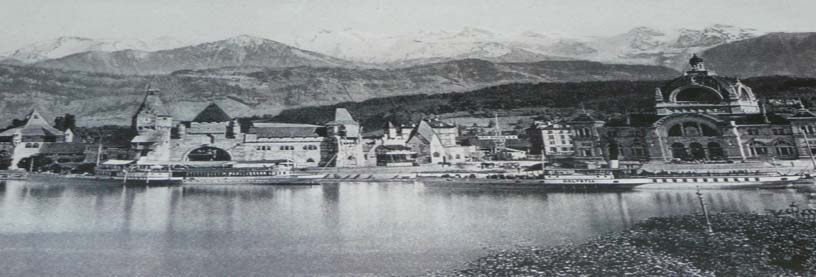

| M
U
SE
U
M |  June 7, 1902 - International Museum of War & Peace, Luzern/Lucerne (Switzerland). World's first peace museum. "Although created by Ivan Bloch, aka Jean de Bloch [1836-1902], a Polish-Russian entrepreneur & author of the 6-volume master work, La Guerre Future / Is War Now Impossible? (1898), Bloch died in Warsaw at the beginning of 1902, and the museum was inaugerated in Shooting Festival Hall by Frédéric Passy & Bertha von Suttner (who respectively received the 1st & 5th Nobel Peace Prizes in 1901 & 1905).
Museum moved to Museggstrasse in 1910 & closed in 1920 due to lack of patronage during World War I. Site is now Culture & Congress Centre by French architect Jean Nouvel (1998). See "The International Museum of War and Peace at Lucerne" by Peter van den Dungen, Schweizerische Zeitschrift fur Geschichte, vol, 31, pp, 185-202 (1981). June 7, 1902 - International Museum of War & Peace, Luzern/Lucerne (Switzerland). World's first peace museum. "Although created by Ivan Bloch, aka Jean de Bloch [1836-1902], a Polish-Russian entrepreneur & author of the 6-volume master work, La Guerre Future / Is War Now Impossible? (1898), Bloch died in Warsaw at the beginning of 1902, and the museum was inaugerated in Shooting Festival Hall by Frédéric Passy & Bertha von Suttner (who respectively received the 1st & 5th Nobel Peace Prizes in 1901 & 1905).
Museum moved to Museggstrasse in 1910 & closed in 1920 due to lack of patronage during World War I. Site is now Culture & Congress Centre by French architect Jean Nouvel (1998). See "The International Museum of War and Peace at Lucerne" by Peter van den Dungen, Schweizerische Zeitschrift fur Geschichte, vol, 31, pp, 185-202 (1981). 
| Note: At the museum dedication Bertha von Suttner says, "our age has been presented with something new and and unprecedented: the embodiment through a building of a similarly new and unprecedented idea... Through the museum this theory will undoubtedly penetrate in much larger circles than could be reached by the book, and will also be easier to grasp."
 1902 - Arbitrage entre les Etas-Unis d"Amerique et les Etats-Unis Mexicans, The Hague (Netherlands). 1902 - Arbitrage entre les Etas-Unis d"Amerique et les Etats-Unis Mexicans, The Hague (Netherlands).  
 September 22-27, 1903 - 12th Universal Peace Congress, Rouen (France). September 22-27, 1903 - 12th Universal Peace Congress, Rouen (France).
 |
 1904 - Congress of the International Council of Women, Berlin (Germany). "The decision for the establishment of the International Alliance of Women was taken in Washington, DC (USA), in 1902 by suffragists frustrated at the reluctance of the International Council of Women (ICW) to support women's suffrage. The Alliance was formally constituted in Berlin in 1904 as the International Woman Suffrage Alliance (IWSA). Amongst subsequent congresses were those held in Copenhagen (1906), Amsterdam (1908), London (1909) & Stockholm (June 1911). The IWSA also started its own monthly journal, the Jus Suffragii. The IWSA, influenced by Millicent Fawcett [1847-1929] against the militancy of suffragettes in the style of Emily Pankhurst [1858-1928], initially refused membership to the Women's Social & Political Union (WSPU) at their 1906 Copenhagen meeting. In the late 1920's, the organization changed its name to the International Alliance of Women for Suffrage & Equal Citizenship, and in 1946 this was altered to its current name, International Alliance of Women: Equal Rights - Equal Responsibilities." 1904 - Congress of the International Council of Women, Berlin (Germany). "The decision for the establishment of the International Alliance of Women was taken in Washington, DC (USA), in 1902 by suffragists frustrated at the reluctance of the International Council of Women (ICW) to support women's suffrage. The Alliance was formally constituted in Berlin in 1904 as the International Woman Suffrage Alliance (IWSA). Amongst subsequent congresses were those held in Copenhagen (1906), Amsterdam (1908), London (1909) & Stockholm (June 1911). The IWSA also started its own monthly journal, the Jus Suffragii. The IWSA, influenced by Millicent Fawcett [1847-1929] against the militancy of suffragettes in the style of Emily Pankhurst [1858-1928], initially refused membership to the Women's Social & Political Union (WSPU) at their 1906 Copenhagen meeting. In the late 1920's, the organization changed its name to the International Alliance of Women for Suffrage & Equal Citizenship, and in 1946 this was altered to its current name, International Alliance of Women: Equal Rights - Equal Responsibilities."
|

 | C
O
N
F |   1904 - 12th conference, Inter-Parliamentary Union, Festival Hall, St. Louis, Missouri (USA). "Held during the St. Louis World’s Fair. Issued its appeal for peace and adopted a resolution calling for a 2nd Hague Peace Conference. This momentous resolution was drafted by US Representative Richard Bartholdt [1855-1932] of Missouri, who was instrumental in bringing the conference to St. Louis and who was also elected president at the conference. Bartholdt as well as IPU secretary Charles Albert Gobat (winner of the Nobel Peace Prize in 1902) later presented this so-called 'Resolution of St. Louis' to US President Theodore Roosevelt. President Roosevelt responded affirmatively to the Inter-Parliamentary resolution, and shortly thereafter, upon Roosevelt’s instruction, Secretary of State Hay issued a circular proposing a 2nd Hague Peace Conference. Subsequently, Czar Nicholas II of Russia formally initiated and convened the Hague Peace Conference of 1907." 1904 - 12th conference, Inter-Parliamentary Union, Festival Hall, St. Louis, Missouri (USA). "Held during the St. Louis World’s Fair. Issued its appeal for peace and adopted a resolution calling for a 2nd Hague Peace Conference. This momentous resolution was drafted by US Representative Richard Bartholdt [1855-1932] of Missouri, who was instrumental in bringing the conference to St. Louis and who was also elected president at the conference. Bartholdt as well as IPU secretary Charles Albert Gobat (winner of the Nobel Peace Prize in 1902) later presented this so-called 'Resolution of St. Louis' to US President Theodore Roosevelt. President Roosevelt responded affirmatively to the Inter-Parliamentary resolution, and shortly thereafter, upon Roosevelt’s instruction, Secretary of State Hay issued a circular proposing a 2nd Hague Peace Conference. Subsequently, Czar Nicholas II of Russia formally initiated and convened the Hague Peace Conference of 1907."
|   October 3-8, 1904 - 13th Universal Peace Congress, Tremont Temple, Boston, Massachusetts (USA). Official report available on-line at Google Books. Bertha von Suttner attends the congress in Boston, followed by her first lecture tour in the United States, during which she meets President Theodore Roosevelt and visits Quaker communities that offer an inspiring example of life devoted to non-violence. October 3-8, 1904 - 13th Universal Peace Congress, Tremont Temple, Boston, Massachusetts (USA). Official report available on-line at Google Books. Bertha von Suttner attends the congress in Boston, followed by her first lecture tour in the United States, during which she meets President Theodore Roosevelt and visits Quaker communities that offer an inspiring example of life devoted to non-violence.

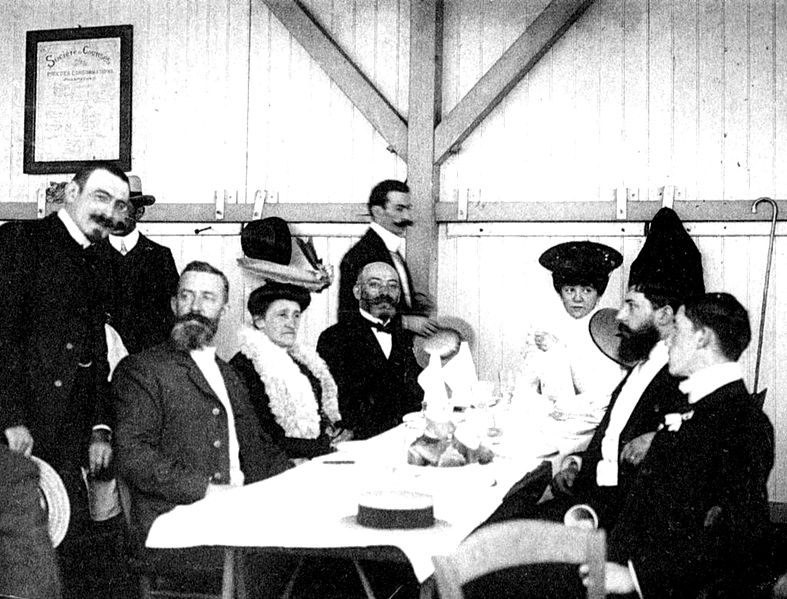

| C
O
N
F |  August 1905 - 1st World Congress of Esperanto, Boulogne-sur-Mer (France). 688 participants. "Since then, world congresses have been held in different countries every year, except during the two World Wars. Since the Second World War, they have been attended by an average of over 2,000 & up to 6,000 people." Second image shows the Zamenhof & Michaux families at the first Esperanto Congress. Ludwik Zamenhof [1859-1917] of Poland was the creator of Esperanto, the most successful constructed language designed for international communication. August 1905 - 1st World Congress of Esperanto, Boulogne-sur-Mer (France). 688 participants. "Since then, world congresses have been held in different countries every year, except during the two World Wars. Since the Second World War, they have been attended by an average of over 2,000 & up to 6,000 people." Second image shows the Zamenhof & Michaux families at the first Esperanto Congress. Ludwik Zamenhof [1859-1917] of Poland was the creator of Esperanto, the most successful constructed language designed for international communication. 
|  September 19-23, 1905 - 14th Universal Peace Congress, Luzern/Lucerne (Switzerland). Among other business, the Congress "urges the methodical teaching of the principles of peace...and that the anniversry of the 18th of May [First Hague Peace Conference] be celebrated in all the schools." Delegates undoubtedly visit the International Museum of War & Peace. September 19-23, 1905 - 14th Universal Peace Congress, Luzern/Lucerne (Switzerland). Among other business, the Congress "urges the methodical teaching of the principles of peace...and that the anniversry of the 18th of May [First Hague Peace Conference] be celebrated in all the schools." Delegates undoubtedly visit the International Museum of War & Peace.
 |   1906-1940 - Fourth incarnation of the New York Peace Society.
"The society is founded anew for the final time in 1906, in the context of the Philippine-American War, the rapid expansion of American influence & military usage abroad & the rise of the American Anti-Imperialist League. It was organized by Oscar Strauss [1850-1926] & Charles Levermore with the support of steel magnate Andrew Carnegie [1835-1919].
The society was involved in a "National Arbitration and Peace Conference" in 1907. During the First World War, the society helped to organize the League to Enforce Peace in opposition to American involvement.
In 1940, the society merged into the Quaker World Alliance for International Friendship through Religion." /// Image is
the January 1918 issue of "The Messenger of the New York Peace Society." 1906-1940 - Fourth incarnation of the New York Peace Society.
"The society is founded anew for the final time in 1906, in the context of the Philippine-American War, the rapid expansion of American influence & military usage abroad & the rise of the American Anti-Imperialist League. It was organized by Oscar Strauss [1850-1926] & Charles Levermore with the support of steel magnate Andrew Carnegie [1835-1919].
The society was involved in a "National Arbitration and Peace Conference" in 1907. During the First World War, the society helped to organize the League to Enforce Peace in opposition to American involvement.
In 1940, the society merged into the Quaker World Alliance for International Friendship through Religion." /// Image is
the January 1918 issue of "The Messenger of the New York Peace Society."
|


![]()
|   April 14-17, 1907 - First National Arbitration & Peace Conference, Carnegie Hall, New York City, New York (USA). On the eve of the Second Hague Peace Conference. Andrew Carnegie [1835-1919] was president of this conference. Delegates included Baron d'Estournelles de Constant [1852-1924], Prof. Hugo Muensterberg [1863-1916], Robert Ball, William Jennings Bryan, Samuel Gompers, W.T. Stead [1849-1912] & many other dignitaries. Women delegates met separately. Upper image is from the NY Herald Tribune, April 21, 1907. Click here to see advance publicity & Click here for NY Times article about the opening session. Click here for information about the proceedings edited by Robert Erskine Ely (lower image). Were there later conferences of this name? /// The NY Times article says that many foreign delegates had also attended the dedication of the Carnegie Institute in Pittsburgh on April 11, 1907 [sic]. /// N.B.: "Nicholas Murray Butler [1862-1947] chaired the Lake Mohonk Conference on International Arbitration (qv) that met periodically from 1907 to 1912. Butler was president of Columbia University 1902-1945, president of the American branch of the Association for International Conciliation (founded in Paris in 1905 by Baron d'Estournelles de Constant), & president of the Carnegie Endowment for International Peace 1925-1945. He "led five international conferences on international arbitration between 1907 and 1912" & received the Nobel Peace Prize in 1931 (with Jane Addams)." April 14-17, 1907 - First National Arbitration & Peace Conference, Carnegie Hall, New York City, New York (USA). On the eve of the Second Hague Peace Conference. Andrew Carnegie [1835-1919] was president of this conference. Delegates included Baron d'Estournelles de Constant [1852-1924], Prof. Hugo Muensterberg [1863-1916], Robert Ball, William Jennings Bryan, Samuel Gompers, W.T. Stead [1849-1912] & many other dignitaries. Women delegates met separately. Upper image is from the NY Herald Tribune, April 21, 1907. Click here to see advance publicity & Click here for NY Times article about the opening session. Click here for information about the proceedings edited by Robert Erskine Ely (lower image). Were there later conferences of this name? /// The NY Times article says that many foreign delegates had also attended the dedication of the Carnegie Institute in Pittsburgh on April 11, 1907 [sic]. /// N.B.: "Nicholas Murray Butler [1862-1947] chaired the Lake Mohonk Conference on International Arbitration (qv) that met periodically from 1907 to 1912. Butler was president of Columbia University 1902-1945, president of the American branch of the Association for International Conciliation (founded in Paris in 1905 by Baron d'Estournelles de Constant), & president of the Carnegie Endowment for International Peace 1925-1945. He "led five international conferences on international arbitration between 1907 and 1912" & received the Nobel Peace Prize in 1931 (with Jane Addams)."
|

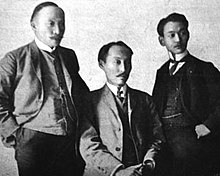
 | C
O
N
F
E
R
E
N
C
E |  June 15, 1907 - Second Hague Peace Conference, Binnenhof, Hall of Knights, The Hague (Netherlands). "It is a little known fact that the initiative for the Second Hague Peace Conference came from civil society in the USA. Prompted by a petition in 1903 from the American Peace Society in Boston, the Massachusetts legislature passed a resolution requesting Congress to authorize the President of the USA to invite the governments of the world to join in establishing a regular international congress to meet at stated periods to deliberate upon the various questions of common interest. The idea was taken up in St. Louis in 1904 [year of the St. Louis Worlds Fair] by the Interparliamentary Union (IPU) that recommended a conference to deal with the subjects postponed at The Hague in 1899. It led to the negotiation of a series of arbitration treaties among the various nations and the consideration of plans for a series of congresses-the kind recommended by the Massachusetts legislature.
President Theodore Roosevelt [1858-1919] responded to this invitation by convening the Second Hague Peace Conference. It was held on June 15, 1907, after being formally convened by the Czar. This time, Russia proposed an agenda limited to improvements in arbitration and humanitarian law, while America suggested discussing the limitation of armaments and the use of force in the collection of debts."
//// N.B. Cornerstone of the Peace Palace was laid by Andrew Carnegie on July 30, 1907 (midway through the conference).
//// Middle image is Korean delegation. Lower image is Yi Jun Peace Museum established in 1995. Yi Jun [1859-1907] represented Korea at the Second Hague Peace Conference and died in this building during the conference. Video June 15, 1907 - Second Hague Peace Conference, Binnenhof, Hall of Knights, The Hague (Netherlands). "It is a little known fact that the initiative for the Second Hague Peace Conference came from civil society in the USA. Prompted by a petition in 1903 from the American Peace Society in Boston, the Massachusetts legislature passed a resolution requesting Congress to authorize the President of the USA to invite the governments of the world to join in establishing a regular international congress to meet at stated periods to deliberate upon the various questions of common interest. The idea was taken up in St. Louis in 1904 [year of the St. Louis Worlds Fair] by the Interparliamentary Union (IPU) that recommended a conference to deal with the subjects postponed at The Hague in 1899. It led to the negotiation of a series of arbitration treaties among the various nations and the consideration of plans for a series of congresses-the kind recommended by the Massachusetts legislature.
President Theodore Roosevelt [1858-1919] responded to this invitation by convening the Second Hague Peace Conference. It was held on June 15, 1907, after being formally convened by the Czar. This time, Russia proposed an agenda limited to improvements in arbitration and humanitarian law, while America suggested discussing the limitation of armaments and the use of force in the collection of debts."
//// N.B. Cornerstone of the Peace Palace was laid by Andrew Carnegie on July 30, 1907 (midway through the conference).
//// Middle image is Korean delegation. Lower image is Yi Jun Peace Museum established in 1995. Yi Jun [1859-1907] represented Korea at the Second Hague Peace Conference and died in this building during the conference. Video

|
 September 9-14, 1907 - 16th Universal Peace Congress , Munich (Germany). According to the
Swarthmore College Peace Collection, the upper photo at far left is from Munich and shows Benjamin Franklin Trueblood, Bertha von Suttner and others. According to the Hague Appeal for Peace, the photo is from the Second Hague Peace Conference. Which source is corrent? September 9-14, 1907 - 16th Universal Peace Congress , Munich (Germany). According to the
Swarthmore College Peace Collection, the upper photo at far left is from Munich and shows Benjamin Franklin Trueblood, Bertha von Suttner and others. According to the Hague Appeal for Peace, the photo is from the Second Hague Peace Conference. Which source is corrent?
| Note: "An inflexible alliance system emerged by 1907, which pitted the Entente Powers (Britain, France, and Russia) against the Triple Alliance (Germany, Austria-Hungary, and Italy). The Great Powers no longer enjoyed the opportunity to shift alliances to maintain a balance of power."
 

|  August 18-24, 1907 - Seventh Socialist International, Second International, Liederhalle, Stuttgart (Germany). "A resolution agains 'militarism and imperialism' sought to bridge the gap between the socialist and pcifist visions...the first serious democratic attemps to create a strategy of public action to prevent war..." (John Gettings) August 18-24, 1907 - Seventh Socialist International, Second International, Liederhalle, Stuttgart (Germany). "A resolution agains 'militarism and imperialism' sought to bridge the gap between the socialist and pcifist visions...the first serious democratic attemps to create a strategy of public action to prevent war..." (John Gettings)
|

|  October 1908 - 1er Congres International de la Route / 1st International Road Congress, Paris (France). "In 1903, the British government introduced four 'national' road signs based on shape, but the basic patterns of most traffic signs were set at the 1908 International Road Congress in Rome [sic]. In 1909, nine European governments agreed on the use of four pictorial symbols, indicating 'bump,' 'curve,' 'intersection,'& 'grade-level railroad crossing.' The intensive work on international road signs that took place between 1926 & 1949 eventually led to the development of the European road sign system." October 1908 - 1er Congres International de la Route / 1st International Road Congress, Paris (France). "In 1903, the British government introduced four 'national' road signs based on shape, but the basic patterns of most traffic signs were set at the 1908 International Road Congress in Rome [sic]. In 1909, nine European governments agreed on the use of four pictorial symbols, indicating 'bump,' 'curve,' 'intersection,'& 'grade-level railroad crossing.' The intensive work on international road signs that took place between 1926 & 1949 eventually led to the development of the European road sign system."
|
![]() |
  December 4, 1908-February 26, 1909 - First London Naval Conference, London (England).
A continuation of the debates of the 2nd Hague Conference, with the United Kingdom hoping for the formation of an International Prize Court. Ten nations sent representatives -- the main naval powers of Europe, the USA, and Japan. The agreements were issued as the Declaration of London. Containing seventy-one articles, it restated much existing international maritime law.
The signatories' governments did not all ratify the Declaration, and it never went into effect.
This was the first of three major international naval conferences in London. The second was January 21- April 22, 1930, and the third in December1935. The latter two, together with the Washington Naval Conference in 1921-22 and the Geneva Conferences (1927 and 1932), resulted in agreements between the major powers on navy vessel numbers, armaments and the rules of engagement in the inter-war period. December 4, 1908-February 26, 1909 - First London Naval Conference, London (England).
A continuation of the debates of the 2nd Hague Conference, with the United Kingdom hoping for the formation of an International Prize Court. Ten nations sent representatives -- the main naval powers of Europe, the USA, and Japan. The agreements were issued as the Declaration of London. Containing seventy-one articles, it restated much existing international maritime law.
The signatories' governments did not all ratify the Declaration, and it never went into effect.
This was the first of three major international naval conferences in London. The second was January 21- April 22, 1930, and the third in December1935. The latter two, together with the Washington Naval Conference in 1921-22 and the Geneva Conferences (1927 and 1932), resulted in agreements between the major powers on navy vessel numbers, armaments and the rules of engagement in the inter-war period.
|

![]()
|   May 2-5, 1909 Second National Peace Congress, Chicago, Illinois (USA). German-born Anna B. Eckstein [1868-1947] took an active part in this congress. Click here for congress proceedings edited by Charles Edward Beals, Field Secretaty, American Peace Society, 31 Beacon Street, Boston. This on-line document contains a very long list of officers & attendees. (In 1916, Beals wrote "Benjamin F. Trueblood: Prophet of Peace, 1847-1916.") May 2-5, 1909 Second National Peace Congress, Chicago, Illinois (USA). German-born Anna B. Eckstein [1868-1947] took an active part in this congress. Click here for congress proceedings edited by Charles Edward Beals, Field Secretaty, American Peace Society, 31 Beacon Street, Boston. This on-line document contains a very long list of officers & attendees. (In 1916, Beals wrote "Benjamin F. Trueblood: Prophet of Peace, 1847-1916.")
|
 1909 - The Great Illusion". A book by Norman Angell [1872-1967], first published under the title "Europe's Optical Illusion.' Republished in 1910 & subsequently in various enlarged & revised editions under the title 'The Great Illusion.' Angell's main argument was that war between industrial countries was futile because conquest did not pay. Moreover, if a conquering power confiscated property in the territory it seized, 'the incentive to produce [of the local population] would be sapped & the conquered area be rendered worthless. Thus, the conquering power had to leave property in the hands of the local population while incurring the costs of conquest & occupation.'" Angell was awarded the Nobel Peace Prize in 1933. 1909 - The Great Illusion". A book by Norman Angell [1872-1967], first published under the title "Europe's Optical Illusion.' Republished in 1910 & subsequently in various enlarged & revised editions under the title 'The Great Illusion.' Angell's main argument was that war between industrial countries was futile because conquest did not pay. Moreover, if a conquering power confiscated property in the territory it seized, 'the incentive to produce [of the local population] would be sapped & the conquered area be rendered worthless. Thus, the conquering power had to leave property in the hands of the local population while incurring the costs of conquest & occupation.'" Angell was awarded the Nobel Peace Prize in 1933.

|   May 8-11, 1910 - New England Arbitration & Peace Conference, Hartford, Connecticut (USA). Yale Law School dean Henry Wade Rogers [1853-1926] presided. Benjamin Franklin Trueblood of the American Peace Society was a principal speaker. Click here for NY Times article of May 10, 1910. May 8-11, 1910 - New England Arbitration & Peace Conference, Hartford, Connecticut (USA). Yale Law School dean Henry Wade Rogers [1853-1926] presided. Benjamin Franklin Trueblood of the American Peace Society was a principal speaker. Click here for NY Times article of May 10, 1910.
|
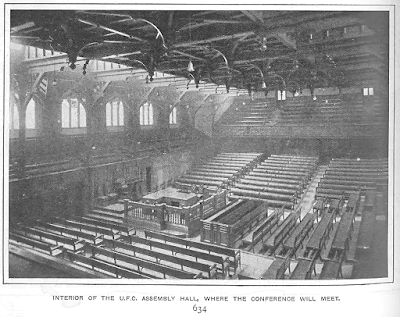
 |
 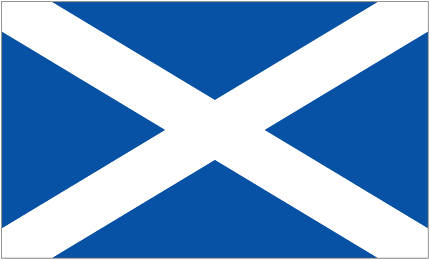 June 14-23, 1910 - World Missionary Conference, Assembly Hall of the United Free Church of Scotland, Edinburgh (Scotland). Also called the Edinburgh Missionary Conference. Attended by 1,200 representatives of all major Protestant denominations & missionary societies, predominantly from North America & Northern Europe. Seen as both the culmination of 19th century Protestant Christian missions and the formal beginning of the modern Protestant Christian ecumenical movement.
Lord Alfred Balfour [1848-1932] of the Church of Scotland was conference president. Conference proceedings were chaired by John R. Mott [1865-1955], an American Methodist layperson & leader of both the Student Volunteer Movement for Foreign Missions and the World Student Christian Federation. /// Attended by American Disciple Charles Clayton Morrison [1874-1966] who campaigned for what would become the World Council of Churches (WCC) in 1937. (The WCC was organized in 1948 (see below). In 1949 Morrison and 35 other church leaders proposed the so-called "Greenwich" or "Morrison" plan for a united Protestant church.) Church leaders agreed in 1937 to establish a WCC, based on a merger of the Faith & Order Movement and Life & Work Movement.
WCC's official establishment was deferred with the outbreak of World War II until August 23, 1948. Delegates of 147 churches assembled in Amsterdam to merge the Faith & Order Movement and Life & Work Movement. Subsequent mergers were with the International Missionary Council in 1961 & the World Council of Christian Education, with its roots in the 18th century Sunday School movement, in 1971. Also attended by Americans Arthur Judson Brown [1856-1963] & George Sherwood Eddy [1871-1963], "a young man of wealth who is supporting himself in mission work in India." June 14-23, 1910 - World Missionary Conference, Assembly Hall of the United Free Church of Scotland, Edinburgh (Scotland). Also called the Edinburgh Missionary Conference. Attended by 1,200 representatives of all major Protestant denominations & missionary societies, predominantly from North America & Northern Europe. Seen as both the culmination of 19th century Protestant Christian missions and the formal beginning of the modern Protestant Christian ecumenical movement.
Lord Alfred Balfour [1848-1932] of the Church of Scotland was conference president. Conference proceedings were chaired by John R. Mott [1865-1955], an American Methodist layperson & leader of both the Student Volunteer Movement for Foreign Missions and the World Student Christian Federation. /// Attended by American Disciple Charles Clayton Morrison [1874-1966] who campaigned for what would become the World Council of Churches (WCC) in 1937. (The WCC was organized in 1948 (see below). In 1949 Morrison and 35 other church leaders proposed the so-called "Greenwich" or "Morrison" plan for a united Protestant church.) Church leaders agreed in 1937 to establish a WCC, based on a merger of the Faith & Order Movement and Life & Work Movement.
WCC's official establishment was deferred with the outbreak of World War II until August 23, 1948. Delegates of 147 churches assembled in Amsterdam to merge the Faith & Order Movement and Life & Work Movement. Subsequent mergers were with the International Missionary Council in 1961 & the World Council of Christian Education, with its roots in the 18th century Sunday School movement, in 1971. Also attended by Americans Arthur Judson Brown [1856-1963] & George Sherwood Eddy [1871-1963], "a young man of wealth who is supporting himself in mission work in India."

  November 9-11, 2010 - Centennial Gathering, Marriott New Orleans Convention Center, New Orleans, Louisiana (USA). Marked 100th anniversary of the World Mission Conference. Sponsored by National Council of Churches (NCC) & Church World Service. November 9-11, 2010 - Centennial Gathering, Marriott New Orleans Convention Center, New Orleans, Louisiana (USA). Marked 100th anniversary of the World Mission Conference. Sponsored by National Council of Churches (NCC) & Church World Service.
| |
 
|
 1910 - 1st World Congress of International Organizations, Brussels (Belgium). Attended by 132 international bodies & 13 governments. The Union of International Associations (UIA) is founded under its present name. Henri La Fontaine [1854-1943], Paul Otlet [1868-1944] & Cyrille Van Overbergh [1866-1959] are appointed Secretaries-General. The Annuaire de la Vie Internationale is published until 1911 with the support of the Carnegie Endowment for International Peace. Otlet & La Fontaine first envision a "city of knowledge," which Otlet originally named the "Palais Mondial," that would serve as a central repository for the world's information. /// "In 1934 [lower image], Otlet sketched out plans for a global network of computers (or 'electric telescopes' as he called them) that would allow people to search & browse through millions of interlinked documents, images, audio & video files. He described how people would use the devices to send messages to one another, share files & even congregate in online social networks. He called the whole thing a réseau, which might be translated as network — or arguably, web." 1910 - 1st World Congress of International Organizations, Brussels (Belgium). Attended by 132 international bodies & 13 governments. The Union of International Associations (UIA) is founded under its present name. Henri La Fontaine [1854-1943], Paul Otlet [1868-1944] & Cyrille Van Overbergh [1866-1959] are appointed Secretaries-General. The Annuaire de la Vie Internationale is published until 1911 with the support of the Carnegie Endowment for International Peace. Otlet & La Fontaine first envision a "city of knowledge," which Otlet originally named the "Palais Mondial," that would serve as a central repository for the world's information. /// "In 1934 [lower image], Otlet sketched out plans for a global network of computers (or 'electric telescopes' as he called them) that would allow people to search & browse through millions of interlinked documents, images, audio & video files. He described how people would use the devices to send messages to one another, share files & even congregate in online social networks. He called the whole thing a réseau, which might be translated as network — or arguably, web."
|  |  1998 - Mundaneum, 76 de la rue de Nimy, Mons (Belgium). "Un centre d'archives de la Communauté française. Bénéficie d'une salle d'exposition dont la scénographie a été réalisée par François Schuiten et Benoît Peeters." 1998 - Mundaneum, 76 de la rue de Nimy, Mons (Belgium). "Un centre d'archives de la Communauté française. Bénéficie d'une salle d'exposition dont la scénographie a été réalisée par François Schuiten et Benoît Peeters."
|
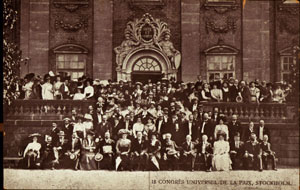 |
 August 1-5, 1910 - 18th Universal Peace Congress , Stockholm (Sweden). Leo Tolstoy [1828-1910] prepared to speak at this congress on "the incompatibility between the Christian spirit & military service" but his wife Sonya & old age prevented him from attending.
Click here for other photos from the Swarthmore College Peace Collection. August 1-5, 1910 - 18th Universal Peace Congress , Stockholm (Sweden). Leo Tolstoy [1828-1910] prepared to speak at this congress on "the incompatibility between the Christian spirit & military service" but his wife Sonya & old age prevented him from attending.
Click here for other photos from the Swarthmore College Peace Collection.
|

|   December 14, 1910 - Carnegie Endowment for International Peace (CEIP), Washington, DC (USA). Originally located in New York City.
Andrew Carnegie [1835-1919], "like other leading internationalists of his day, believed that war could be eliminated by stronger international laws and organizations." Carnegie charged trustees to use the Endowment to "hasten the abolition of international war, the foulest blot upon our civilization" and chose longtime adviser Elihu Root [1845-1937], Senator from New York and former Secretary of War and of State, to be its head. Root served as Endowment president until 1925. // "Nicholas Murray Butler [1862-1947]
was CEIP president 1925-1945. Butler was also president of Columbia University 1902-1945, chair of the Lake Mohonk Conference on International Arbitration (qv) that met periodically from 1907 to 1912 & was president of the American branch of the Association for International Conciliation (founded in Paris in 1905 by Baron d'Estournelles de Constant). /// Root received the Nobel Peace Prize in 1912, and Butler received it in 1931 (with Jane Addams)." December 14, 1910 - Carnegie Endowment for International Peace (CEIP), Washington, DC (USA). Originally located in New York City.
Andrew Carnegie [1835-1919], "like other leading internationalists of his day, believed that war could be eliminated by stronger international laws and organizations." Carnegie charged trustees to use the Endowment to "hasten the abolition of international war, the foulest blot upon our civilization" and chose longtime adviser Elihu Root [1845-1937], Senator from New York and former Secretary of War and of State, to be its head. Root served as Endowment president until 1925. // "Nicholas Murray Butler [1862-1947]
was CEIP president 1925-1945. Butler was also president of Columbia University 1902-1945, chair of the Lake Mohonk Conference on International Arbitration (qv) that met periodically from 1907 to 1912 & was president of the American branch of the Association for International Conciliation (founded in Paris in 1905 by Baron d'Estournelles de Constant). /// Root received the Nobel Peace Prize in 1912, and Butler received it in 1931 (with Jane Addams)."
|

| C
O
N
F |   1911 - Conference for Peace & Arbitration, Mission Inn, Riverside, California (USA). Mission Inn owner Frank Augustus Miller [1857-1935] staged the conference "a year after industrialist Andrew Carnegie established the Endowment for International Peace. Among those attending were naturalist John Muir, Theodore Roosevelt’s Vice President Charles W. Fairbanks & Miller’s good friend, former Stanford University president David Starr Jordan [1851-1931]. /// "Three years after the first Riverside conference, war erupted in Europe. In 1915, Miller's good friend, Roycroft founder Elbert Hubbard & his wife, lost their lives in Germany’s sinking of the ocean liner Lusitania." Was there ever a "second Riverside conferene"? /// Miller founded the Institute of World Affairs (which is now the World Affairs Council of Inland Southern California). In 1925, the Frank A. Miller Testimonial Peace Tower on Mount Rubidoux [image] was constructed to honor him. The tower bears the names & coats of arms of all nations as of 1925. Entry #111 in the "Peace Movement Directory" by James Richard Bennett (2001). 1911 - Conference for Peace & Arbitration, Mission Inn, Riverside, California (USA). Mission Inn owner Frank Augustus Miller [1857-1935] staged the conference "a year after industrialist Andrew Carnegie established the Endowment for International Peace. Among those attending were naturalist John Muir, Theodore Roosevelt’s Vice President Charles W. Fairbanks & Miller’s good friend, former Stanford University president David Starr Jordan [1851-1931]. /// "Three years after the first Riverside conference, war erupted in Europe. In 1915, Miller's good friend, Roycroft founder Elbert Hubbard & his wife, lost their lives in Germany’s sinking of the ocean liner Lusitania." Was there ever a "second Riverside conferene"? /// Miller founded the Institute of World Affairs (which is now the World Affairs Council of Inland Southern California). In 1925, the Frank A. Miller Testimonial Peace Tower on Mount Rubidoux [image] was constructed to honor him. The tower bears the names & coats of arms of all nations as of 1925. Entry #111 in the "Peace Movement Directory" by James Richard Bennett (2001).
|  April 15, 1912 - RMS Titanic sinks in the North Atlantic Ocean after colliding with an iceberg during her maiden voyage from Southampton (England) to New York City (USA). British journalist & peacemaker William Thomas Stead [1849-1912] is drowned while en route to the "Congress of the Men and Religion Forward Movement" (qv). Stead published a daily account ("Chronique de la Conference de la Paix") in the "Dagblad" newspaper during the First Hague Peace Conference in 1907. Identical monuments will be erected for him in London & in New York City. April 15, 1912 - RMS Titanic sinks in the North Atlantic Ocean after colliding with an iceberg during her maiden voyage from Southampton (England) to New York City (USA). British journalist & peacemaker William Thomas Stead [1849-1912] is drowned while en route to the "Congress of the Men and Religion Forward Movement" (qv). Stead published a daily account ("Chronique de la Conference de la Paix") in the "Dagblad" newspaper during the First Hague Peace Conference in 1907. Identical monuments will be erected for him in London & in New York City.


![]()
|   April 22, 1912 - Congress of the Men and Religion Forward Movement, Carnegie Hall, New York City, New York (USA). Turned into a "memorial meeting" when it was learned that British journalist & peacemaker William Thomas Stead [1849-1912] went down with the Titanic on April 15 while en route to the congress. See article by Stead written just before his departure from England. /// From "The Life of W.T. Stead" by Frederic Whyte (1925), vol. 2, pp. 311-2:
"A cablegram from New York, March 17, 1912, by Mr. Fred B[urton] Smith, the
organizer of a kind of 'Revivalist' campaign known as 'The National Men and
Religion Forward Movement' ... 'Will you come to New York and address the
Great Men and Religious Congress in Carnegie Hall April 22nd [!] together
with President Taft? We pay expenses. Subject World Peace. Please cable.'" British ambassador James Bryce [1838-1922], William Jennings Bryan & Booker T. Washington were also expected to attend.
/// Left image shows Stead & right image shows Fred Burton Smith [1865-1936], a "YMCA secretary involved in international work" who published "On the Trail of the Peacemakers" in 1922. No independent evidence has been found so far that Taft, Bryce, Bryan or Washington actually attended this congress. April 22, 1912 - Congress of the Men and Religion Forward Movement, Carnegie Hall, New York City, New York (USA). Turned into a "memorial meeting" when it was learned that British journalist & peacemaker William Thomas Stead [1849-1912] went down with the Titanic on April 15 while en route to the congress. See article by Stead written just before his departure from England. /// From "The Life of W.T. Stead" by Frederic Whyte (1925), vol. 2, pp. 311-2:
"A cablegram from New York, March 17, 1912, by Mr. Fred B[urton] Smith, the
organizer of a kind of 'Revivalist' campaign known as 'The National Men and
Religion Forward Movement' ... 'Will you come to New York and address the
Great Men and Religious Congress in Carnegie Hall April 22nd [!] together
with President Taft? We pay expenses. Subject World Peace. Please cable.'" British ambassador James Bryce [1838-1922], William Jennings Bryan & Booker T. Washington were also expected to attend.
/// Left image shows Stead & right image shows Fred Burton Smith [1865-1936], a "YMCA secretary involved in international work" who published "On the Trail of the Peacemakers" in 1922. No independent evidence has been found so far that Taft, Bryce, Bryan or Washington actually attended this congress. 
|
.png)

 | C
O
N
F |   May 14-16, 1912 -
Peace Conference, Mohonk Mountain House, Lake Mohonk, New Paltz, Ulster County, New York (USA). "This conference was the greatest of all the peace conferences in America." It was hosted by hotel owner Albert K. Smiley [1828-1912] (said to be "president of the International Peace Society"), and it took place in "a spacious hall of the hotel facing the lake, the hall having been especially built for the conference." Image shows clipping from New York Times of May 26, 1912. Text of caption: "THE PEACE CONFERENCE AT LAKE MOHONK. Left to Right -- E.C. Getsinger, Mrs. E.C. Getsinger, Dr. Ameen Farred, Miz Ahmed Sahrab, Miza Vargha, Signid Assadullah, Dr. Zia Bagdadi [d.1937], Abdul Bahai [1844-1921] (in front)." Many if not all of these appear to be of the Bahá'íFaith, of which `Abdu'l-Bahá was its head. See First Lake Mohonk Conference on International Arbitration in June 1895. May 14-16, 1912 -
Peace Conference, Mohonk Mountain House, Lake Mohonk, New Paltz, Ulster County, New York (USA). "This conference was the greatest of all the peace conferences in America." It was hosted by hotel owner Albert K. Smiley [1828-1912] (said to be "president of the International Peace Society"), and it took place in "a spacious hall of the hotel facing the lake, the hall having been especially built for the conference." Image shows clipping from New York Times of May 26, 1912. Text of caption: "THE PEACE CONFERENCE AT LAKE MOHONK. Left to Right -- E.C. Getsinger, Mrs. E.C. Getsinger, Dr. Ameen Farred, Miz Ahmed Sahrab, Miza Vargha, Signid Assadullah, Dr. Zia Bagdadi [d.1937], Abdul Bahai [1844-1921] (in front)." Many if not all of these appear to be of the Bahá'íFaith, of which `Abdu'l-Bahá was its head. See First Lake Mohonk Conference on International Arbitration in June 1895.
|
![]() |

 December 16, 1912-May 30, 1913 - London Peace Conference, London (England). "Also known as the "London Conference of 1913." An international summit to discuss issues arising from the declaration of independence by Albania during the First Balkan War. An armistice to end the First Balkan War had been signed on 3 December 1912.
The London Peace Conference was attended by those delegates from the Balkan allies (including Greece) who had not signed the previous armistice, as well as Turkey. Ended 23 January 1913 when the Coup of 1913 in the Ottoman Empire took place. On 30 May 1913, the conference finally closed with the signing of the Treaty of London (1913), which established the independence and territory of Albania, as well as dividing the lands the Balkan League had captured from the Ottoman Empire during the First Balkan War." December 16, 1912-May 30, 1913 - London Peace Conference, London (England). "Also known as the "London Conference of 1913." An international summit to discuss issues arising from the declaration of independence by Albania during the First Balkan War. An armistice to end the First Balkan War had been signed on 3 December 1912.
The London Peace Conference was attended by those delegates from the Balkan allies (including Greece) who had not signed the previous armistice, as well as Turkey. Ended 23 January 1913 when the Coup of 1913 in the Ottoman Empire took place. On 30 May 1913, the conference finally closed with the signing of the Treaty of London (1913), which established the independence and territory of Albania, as well as dividing the lands the Balkan League had captured from the Ottoman Empire during the First Balkan War."
|

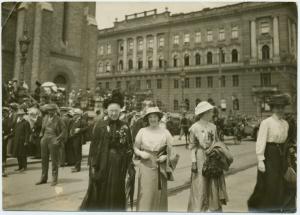
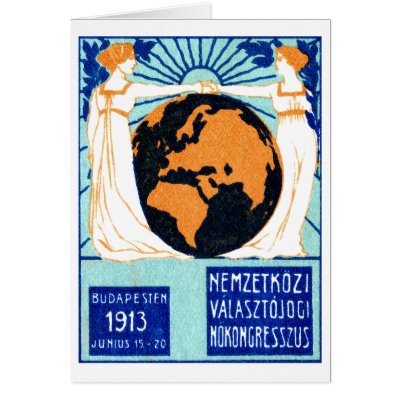
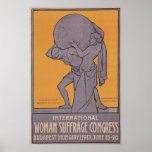
 |
 June 15-20, 1913 - International Woman Suffrage Congress, Redoute Building, Budapest (Hungary). Left image shows Carrie Chapman Catt [1859-1947], Millicent Fawcett [1847-1929] & other board members of the International Woman Suffrage Alliance (IWSA) at the congress. "The IWSA was formally constituted in Berlin in 1904. Subsequent congresses were held in Copenhagen (1906), Amsterdam (1908), London (1909), Stockholm (June 1911) & and Budapest (June 1913). The IWSA had its own monthly journal, the Jus Suffragii. Influenced by Millicent Fawcett against the militancy of suffragettes in the style of Emily Pankhurst [1882-1960], the IWSA initially refused membership to the Women's Social & Political Union (WSPU) at their 1906 Copenhagen meeting." June 15-20, 1913 - International Woman Suffrage Congress, Redoute Building, Budapest (Hungary). Left image shows Carrie Chapman Catt [1859-1947], Millicent Fawcett [1847-1929] & other board members of the International Woman Suffrage Alliance (IWSA) at the congress. "The IWSA was formally constituted in Berlin in 1904. Subsequent congresses were held in Copenhagen (1906), Amsterdam (1908), London (1909), Stockholm (June 1911) & and Budapest (June 1913). The IWSA had its own monthly journal, the Jus Suffragii. Influenced by Millicent Fawcett against the militancy of suffragettes in the style of Emily Pankhurst [1882-1960], the IWSA initially refused membership to the Women's Social & Political Union (WSPU) at their 1906 Copenhagen meeting."
|
 August 18-23, 1913 - XXe Congrès universel de la paix / 20th Universal Peace Congress, Salle des Comtes/Hall of Knights, The Hague (Netherlands). "Sous la haute protection de S.A.R. le prince Henri des Pays-Bas, Duc de
Mecklembourg." Attended by "500 pacifists," including Bertha von Sutner [1843-1914] & Henri Mandere [1883-1959], among others. A visit to the Peace Palace (not yet formally open) is a special event on the conference programme. August 18-23, 1913 - XXe Congrès universel de la paix / 20th Universal Peace Congress, Salle des Comtes/Hall of Knights, The Hague (Netherlands). "Sous la haute protection de S.A.R. le prince Henri des Pays-Bas, Duc de
Mecklembourg." Attended by "500 pacifists," including Bertha von Sutner [1843-1914] & Henri Mandere [1883-1959], among others. A visit to the Peace Palace (not yet formally open) is a special event on the conference programme.
Note: At inauguration of the Peace Palace, Bertha von Suttner says that peace conferences, treaties and tribunals are not sufficient by themselves: "These things also require their material forms, their easily recognisable visible symbols, their homes. War, which has dominated the world for thousands of years, is not short of monuments and palaces. Peace has just ONE monument: the statue of Christ on the Andes [sic]; and in Europe it now has for the first time ONE beautiful building: the Peace Palace..."
 1913 - 18th Conference, Interparliamentary Union, Salle des Comtes/Hall of Knights, The Hague (Netherlands). 1913 - 18th Conference, Interparliamentary Union, Salle des Comtes/Hall of Knights, The Hague (Netherlands).
 March 16, 1914, Bern (Switzerland) - "Charles Gobat [1843-1914] - Nobel Peace Prize 1902 - died while attending meeting of the peace conference at Bern, he arose as if to speak but collapsed, dying about an hour later." March 16, 1914, Bern (Switzerland) - "Charles Gobat [1843-1914] - Nobel Peace Prize 1902 - died while attending meeting of the peace conference at Bern, he arose as if to speak but collapsed, dying about an hour later."
 |
 June 21, 1914 - Death of Bertha von Suttner (age 71) at her home, Zedlitzgasse no. 7, Vienna (Austria). Photo was taken in Vienna on June 7 in 1913 or 1914 (age 70). Archduke Franz Ferdinand of Austria is assassinated seven days later, triggering World War I. June 21, 1914 - Death of Bertha von Suttner (age 71) at her home, Zedlitzgasse no. 7, Vienna (Austria). Photo was taken in Vienna on June 7 in 1913 or 1914 (age 70). Archduke Franz Ferdinand of Austria is assassinated seven days later, triggering World War I.
|
 |
 September 1914 - 21st Universal Peace Congress scheduled in Vienna in Bertha von Suttner's honor. The program for the congress featured an item entitled "The Suttner Museum" and reported, "The intention exists to maintain exact the apartment of the defunct Baroness Bertha von Suttner in Zedlitzgasse no. 7 also after the congress is over, and to open it up to registered participants during the congress. Afterwards, at least her study should be kept as it was when she died, and the ground floor should be given over to a Suttner-Museum." But nothing comes of this -- or of the conference -- because of the advent of WW-I. Information from Peter van den Dungen (2010). September 1914 - 21st Universal Peace Congress scheduled in Vienna in Bertha von Suttner's honor. The program for the congress featured an item entitled "The Suttner Museum" and reported, "The intention exists to maintain exact the apartment of the defunct Baroness Bertha von Suttner in Zedlitzgasse no. 7 also after the congress is over, and to open it up to registered participants during the congress. Afterwards, at least her study should be kept as it was when she died, and the ground floor should be given over to a Suttner-Museum." But nothing comes of this -- or of the conference -- because of the advent of WW-I. Information from Peter van den Dungen (2010).
| Note: "The assassination of Archduke Franz Ferdinand of Austria-Hungary on 28 June 1914 was the spark that set off the Great War. By August 1914, most of the European Great Powers became involved in a war that would last for four years, spread around the world, and result in the deaths of millions."


|  August 1, 1914 - First conference of the Church Peace Union (CPU), Insel Mainau / Mainau Island, Meersburg, Lake Constance (Germany). CPU was founded by Andrew Carnegie [1835-1919] in New York City in February 1914.
"The timing of the CPU's founding was significant. On the very eve of World War I, Carnegie sought to make war obsolete for all time. For its inaugural international event, the CPU sponsored a conference to be held on the shores of Lake Constance in southern Germany. As the delegates made their way to the conference by train, Germany was invading Belgium." "Delegates met on 1st August, the day the Kaiser ordered mobilisation. They were allowed to leave the country on the last train to France, and then boarded a steamer for London." [PvdD 16Jul10] ///
Lower image is Church Peace Union (CPU), Merrill House
170 East 64th Street, New York City, New York (USA). August 1, 1914 - First conference of the Church Peace Union (CPU), Insel Mainau / Mainau Island, Meersburg, Lake Constance (Germany). CPU was founded by Andrew Carnegie [1835-1919] in New York City in February 1914.
"The timing of the CPU's founding was significant. On the very eve of World War I, Carnegie sought to make war obsolete for all time. For its inaugural international event, the CPU sponsored a conference to be held on the shores of Lake Constance in southern Germany. As the delegates made their way to the conference by train, Germany was invading Belgium." "Delegates met on 1st August, the day the Kaiser ordered mobilisation. They were allowed to leave the country on the last train to France, and then boarded a steamer for London." [PvdD 16Jul10] ///
Lower image is Church Peace Union (CPU), Merrill House
170 East 64th Street, New York City, New York (USA). 
|


 |   August 1914 - "At a railway station in Germany, two of the [Mainau] conferees, a British Quaker named Henry Hodgkin [1876-1933] (who taught philosophy at Queens College, Cambridge University) and a Lutheran minister named Friedrich Sigmund-Schulz (who was, astonishingly, chaplain to the Kaiser!) clasped hands and pledged that because they were Christian brothers they, personally, could never be at war and they would seek to work for peace between their nations, regardless of the policies of their respective governments! Back in the UK, Hodgkins quickly acted on his promise. He convened an ecumenical Christian conference at Queens College from which about 20 individuals declared that they could not conceive of God as a nationalist and that they would not agree to a moratorium on the Sermon on the Mount for the length of the war. From this meeting the British chapter of the Fellowship of Reconciliation (FOR) was born." /// Hodgkin was a medical missionary in China for 20 years. He founded the US chapter of the FOR in 1915 and was chosen in July 1928 to serve as first director of Pendle Hill, the new Quaker 'center for study & contemplation' in Wallingford, Pennsylvania, where he died in 1933. /// Sigmund-Schulz "was imprisoned until 1917, founded the Internationaler Versöhnungsbund (German chapter of the FOR) in 1919, was an early outspoken critic of Hitler, and died in a concentration camp." /// The International Fellowship of Reconciliation (IFOR) was organized in 1919 at the end of
WW-I. Image shows IFOR's International Secretariat, Spoorstraat 38,
1815 BK Alkmaar (Netherlands). When occupied?
August 1914 - "At a railway station in Germany, two of the [Mainau] conferees, a British Quaker named Henry Hodgkin [1876-1933] (who taught philosophy at Queens College, Cambridge University) and a Lutheran minister named Friedrich Sigmund-Schulz (who was, astonishingly, chaplain to the Kaiser!) clasped hands and pledged that because they were Christian brothers they, personally, could never be at war and they would seek to work for peace between their nations, regardless of the policies of their respective governments! Back in the UK, Hodgkins quickly acted on his promise. He convened an ecumenical Christian conference at Queens College from which about 20 individuals declared that they could not conceive of God as a nationalist and that they would not agree to a moratorium on the Sermon on the Mount for the length of the war. From this meeting the British chapter of the Fellowship of Reconciliation (FOR) was born." /// Hodgkin was a medical missionary in China for 20 years. He founded the US chapter of the FOR in 1915 and was chosen in July 1928 to serve as first director of Pendle Hill, the new Quaker 'center for study & contemplation' in Wallingford, Pennsylvania, where he died in 1933. /// Sigmund-Schulz "was imprisoned until 1917, founded the Internationaler Versöhnungsbund (German chapter of the FOR) in 1919, was an early outspoken critic of Hitler, and died in a concentration camp." /// The International Fellowship of Reconciliation (IFOR) was organized in 1919 at the end of
WW-I. Image shows IFOR's International Secretariat, Spoorstraat 38,
1815 BK Alkmaar (Netherlands). When occupied? 
| August 1914-June 1919 - World War I.

| C
O
N
F |   January 10, 1915 - Women's meeting, New Willard Hotel, Washington, DC (USA). The forerunner to WILPF, the Woman's Peace Party (WPP) was formed at a meeting called by Jane Addams and Carrie Chapman Catt. The approximately 3,000 women attendees approved a platform calling for the extension of suffrage to women and for a conference of neutral countries to offer continuous mediation as a way of ending war. WPP sent representatives to the International Women's Congress for Peace & Freedom in The Hague, April 28-30, 1915. (Image is not necessarily from the meeitng in January 1915.) January 10, 1915 - Women's meeting, New Willard Hotel, Washington, DC (USA). The forerunner to WILPF, the Woman's Peace Party (WPP) was formed at a meeting called by Jane Addams and Carrie Chapman Catt. The approximately 3,000 women attendees approved a platform calling for the extension of suffrage to women and for a conference of neutral countries to offer continuous mediation as a way of ending war. WPP sent representatives to the International Women's Congress for Peace & Freedom in The Hague, April 28-30, 1915. (Image is not necessarily from the meeitng in January 1915.)
|



| C
O
N
F
E
R
E
N
C
E |  April 28-30, 1915 -
International Women's Conference for Peace & Freedom, Hague Zoo, The Hague (Netherlands). "Convenes on this day with more than 1,200 delegates from Britain, Germany, Austria-Hungary, Italy, Poland, Belgium, the USA, and five other countries. Dedicated to the cause of peace and a resolution of the Great War. Often referred to as the Women's Peace Congress. Resulted from an invitation by a Dutch women's suffrage organization, led by Aletta Jacobs [1853-1929], to women s rights activists around the world, on the basis of the belief that a peaceful international assemblage of women would 'have its moral effect upon the belligerent countries' (as Jacobs put it during her opening address)."
"International Women's Congress for Peace and Freedom, held in The Hague from April 28 to April 30, 1915. The Congress was organized domestic partners Anita Augspurg [1857–1943], Germany's first female jurist, and Lida Gustava Heymann [1868–1943] at the invitation of the Dutch pacifist, feminist & suffragist Aletta Jacobs to protest against the war then raging in Europe & to suggest ways to prevent war in the future. Attended by 1,136 participants from both neutral & belligerent nations. Adopted much of the platform of WPP & established an Intl Committee of Women for Permanent Peace (ICWPP) with Jane Addams as president. WPP soon became US Section of ICWPP."
Lower image shows US delegation, including Jane Addams, Emily Greene Balch [1867-1961], and Alice Hamilton [1969-1970]. Click here to identify everyone. April 28-30, 1915 -
International Women's Conference for Peace & Freedom, Hague Zoo, The Hague (Netherlands). "Convenes on this day with more than 1,200 delegates from Britain, Germany, Austria-Hungary, Italy, Poland, Belgium, the USA, and five other countries. Dedicated to the cause of peace and a resolution of the Great War. Often referred to as the Women's Peace Congress. Resulted from an invitation by a Dutch women's suffrage organization, led by Aletta Jacobs [1853-1929], to women s rights activists around the world, on the basis of the belief that a peaceful international assemblage of women would 'have its moral effect upon the belligerent countries' (as Jacobs put it during her opening address)."
"International Women's Congress for Peace and Freedom, held in The Hague from April 28 to April 30, 1915. The Congress was organized domestic partners Anita Augspurg [1857–1943], Germany's first female jurist, and Lida Gustava Heymann [1868–1943] at the invitation of the Dutch pacifist, feminist & suffragist Aletta Jacobs to protest against the war then raging in Europe & to suggest ways to prevent war in the future. Attended by 1,136 participants from both neutral & belligerent nations. Adopted much of the platform of WPP & established an Intl Committee of Women for Permanent Peace (ICWPP) with Jane Addams as president. WPP soon became US Section of ICWPP."
Lower image shows US delegation, including Jane Addams, Emily Greene Balch [1867-1961], and Alice Hamilton [1969-1970]. Click here to identify everyone.
|

|   June 1, 1915 - Conference of Society to Eliminate Economic Causes of War, Philadelphia, Pennsylvania (USA).
"On January 9, 1915, a Statement of Principles
was adopted and the Society to Eliminate Economic Causes of War was
organized with a membership of about forty. The president was Mr. Isaac
Sprague, president of Harris, Forbes & Company, of Boston, a Wellesley resident
interested in every activity for the good of the world. I [Roger Babson (1875-1967)] was elected secretary,
and the board of nine directors included Miss [Ellen Fitz] Pendleton (1864-1936), president of
Wellesley College, and Miss Orvis, head of the History Department of Wellesley
College... Directly a£ter the formation of the society, I conceived the idea of bringing
about a constructive international conference of manufacturers, bankers, and
other business men, to discuss the possibility of some sort of league of nations.
The first con£erence was held in Independence Hall, Philadelphia. Ater a trip
by me to Philadelphia to see the Hon. Rudolph Blankenburg, then mayor of
Philadelphia, who heartily favored the plan, it was decided to confine the conference to commercial interests of the Western Hemisphere. We determined to
have this gathering follow the Commerical & Financial South American
Conference to be held in Washington on May 10, 1915.
At Independence Hall, on the morning of June 1, 1915, delegates from 13
American nations met in the simple Declaration Chamber of this historic
building, 139 years a£ter our Declaration of Independence
was signed in that very room. Mayor Blankenburg's address was an appeal
£or a league of nations for which the Society to Eliminate Economic Causes was
working. The conference adopted a Declaration of Independence that we, with
the help of George Horace Lorimer (1876-1937), then editor of the Saturday Evening Post,
prepared." June 1, 1915 - Conference of Society to Eliminate Economic Causes of War, Philadelphia, Pennsylvania (USA).
"On January 9, 1915, a Statement of Principles
was adopted and the Society to Eliminate Economic Causes of War was
organized with a membership of about forty. The president was Mr. Isaac
Sprague, president of Harris, Forbes & Company, of Boston, a Wellesley resident
interested in every activity for the good of the world. I [Roger Babson (1875-1967)] was elected secretary,
and the board of nine directors included Miss [Ellen Fitz] Pendleton (1864-1936), president of
Wellesley College, and Miss Orvis, head of the History Department of Wellesley
College... Directly a£ter the formation of the society, I conceived the idea of bringing
about a constructive international conference of manufacturers, bankers, and
other business men, to discuss the possibility of some sort of league of nations.
The first con£erence was held in Independence Hall, Philadelphia. Ater a trip
by me to Philadelphia to see the Hon. Rudolph Blankenburg, then mayor of
Philadelphia, who heartily favored the plan, it was decided to confine the conference to commercial interests of the Western Hemisphere. We determined to
have this gathering follow the Commerical & Financial South American
Conference to be held in Washington on May 10, 1915.
At Independence Hall, on the morning of June 1, 1915, delegates from 13
American nations met in the simple Declaration Chamber of this historic
building, 139 years a£ter our Declaration of Independence
was signed in that very room. Mayor Blankenburg's address was an appeal
£or a league of nations for which the Society to Eliminate Economic Causes was
working. The conference adopted a Declaration of Independence that we, with
the help of George Horace Lorimer (1876-1937), then editor of the Saturday Evening Post,
prepared."
|

 |
  June 17, 1915 - "Win the War for Permanent Peace" Convention, League to Enforce Peace, Independence Hall, Philadelphia, Pensylvania (USA). The League to Enforce Peace (LEP) "was formed in 1914 in New York City by American citizens concerned by the outbreak of World War I [and] formally announced by 100 noteworthy Americans at the convention on June 17, 1915... They proposed an international agreement in which nations would agree to 'jointly use their economic and military force against any one of their number that goes to war or commits acts of hostility against another.' Former US President William Howard Taft [1857-1930] was LEP's first president. Elected to the Executive Committee were Harvard President Abbott Lawrence Lowell [1856-1943], Oscar S. Straus, magazine editor Hamilton Holt [1872-1951], Taft, and a dozen others. Founders included Alexander Graham Bell, Rabbi Stephen S. Wise, James Cardinal Gibbons, and Edward Filene on behalf of the recently founded US Chamber of Commerce... In February 1919, the League held a series of public meetings in more than half a dozen American cities in support of Wilson's League of Nations proposal... Support for the LEP dissolved [over time], and it ceased operations by 1923." June 17, 1915 - "Win the War for Permanent Peace" Convention, League to Enforce Peace, Independence Hall, Philadelphia, Pensylvania (USA). The League to Enforce Peace (LEP) "was formed in 1914 in New York City by American citizens concerned by the outbreak of World War I [and] formally announced by 100 noteworthy Americans at the convention on June 17, 1915... They proposed an international agreement in which nations would agree to 'jointly use their economic and military force against any one of their number that goes to war or commits acts of hostility against another.' Former US President William Howard Taft [1857-1930] was LEP's first president. Elected to the Executive Committee were Harvard President Abbott Lawrence Lowell [1856-1943], Oscar S. Straus, magazine editor Hamilton Holt [1872-1951], Taft, and a dozen others. Founders included Alexander Graham Bell, Rabbi Stephen S. Wise, James Cardinal Gibbons, and Edward Filene on behalf of the recently founded US Chamber of Commerce... In February 1919, the League held a series of public meetings in more than half a dozen American cities in support of Wilson's League of Nations proposal... Support for the LEP dissolved [over time], and it ceased operations by 1923."
|

| C
O
N
F |  1915 - "International conference to stop the war through mediation," The Hague (Netherlands). Where held in The Hague? "Organized by Hendrik Coenraad Dresselhuys [1870-1926], prominent Dutch lawyer and politician, who later travelled to Germany
to pursue the matter. As Secretary-General of the Dutch Red Cross, Dresselhuys greatly
assisted Belgian refugees in 1918." [All information from Peter van den Dungen 26Jun10.] 1915 - "International conference to stop the war through mediation," The Hague (Netherlands). Where held in The Hague? "Organized by Hendrik Coenraad Dresselhuys [1870-1926], prominent Dutch lawyer and politician, who later travelled to Germany
to pursue the matter. As Secretary-General of the Dutch Red Cross, Dresselhuys greatly
assisted Belgian refugees in 1918." [All information from Peter van den Dungen 26Jun10.]
|




| S
H
IP |  1915-1916 - Henry Ford's Peace Ship.
"On the outbreak of the First World War in Europe [in 1914], Henry Ford, the wealthy American businessman, soon made it clear he opposed the war and supported the decision of the Woman's Peace Party (WPP) to organize a peace conference in Holland. After the conference Ford was contacted by America's three [sic] leading anti-war campaigners, Jane Addams [1860-1935], Rosika Schwimmer [1877-1948], Oswald Garrison Villard [1872-1949], and Paul Kellogg [1879-1958]. They suggested that Ford should sponsor an international conference in Stockholm to discuss ways that the conflict could be brought to an end.
Ford came up with the idea of sending a boat of pacifists to Europe to see if they could negotiate an agreement that would end the war. He chartered the ship Oskar II, and it sailed from Hoboken, New Jersey on 4th December, 1915. The Ford Peace Ship reached Stockholm in January, 1916, and a conference was organized with representatives from Denmark, Holland, Norway, Sweden and the USA. However, unable to persuade representatives from the warring nations to take part, the conference was unable to negotiate an Armistice." (Unitarian Jenkin Lloyd Jones [1843-1918] sailed on the ship.)
Upper images show Henry Ford [1863-1947] at the rail of the ship and Lola Maverick Lloyd [1875-1944] on board.
Bottom image is "Henry Ford's Peace Ship," a painting by Mary McCleary, Regent's Professor of Art Emeritus, Stephen F. Austin State University.
Click here for paper about the Peace Ship. 1915-1916 - Henry Ford's Peace Ship.
"On the outbreak of the First World War in Europe [in 1914], Henry Ford, the wealthy American businessman, soon made it clear he opposed the war and supported the decision of the Woman's Peace Party (WPP) to organize a peace conference in Holland. After the conference Ford was contacted by America's three [sic] leading anti-war campaigners, Jane Addams [1860-1935], Rosika Schwimmer [1877-1948], Oswald Garrison Villard [1872-1949], and Paul Kellogg [1879-1958]. They suggested that Ford should sponsor an international conference in Stockholm to discuss ways that the conflict could be brought to an end.
Ford came up with the idea of sending a boat of pacifists to Europe to see if they could negotiate an agreement that would end the war. He chartered the ship Oskar II, and it sailed from Hoboken, New Jersey on 4th December, 1915. The Ford Peace Ship reached Stockholm in January, 1916, and a conference was organized with representatives from Denmark, Holland, Norway, Sweden and the USA. However, unable to persuade representatives from the warring nations to take part, the conference was unable to negotiate an Armistice." (Unitarian Jenkin Lloyd Jones [1843-1918] sailed on the ship.)
Upper images show Henry Ford [1863-1947] at the rail of the ship and Lola Maverick Lloyd [1875-1944] on board.
Bottom image is "Henry Ford's Peace Ship," a painting by Mary McCleary, Regent's Professor of Art Emeritus, Stephen F. Austin State University.
Click here for paper about the Peace Ship.
|
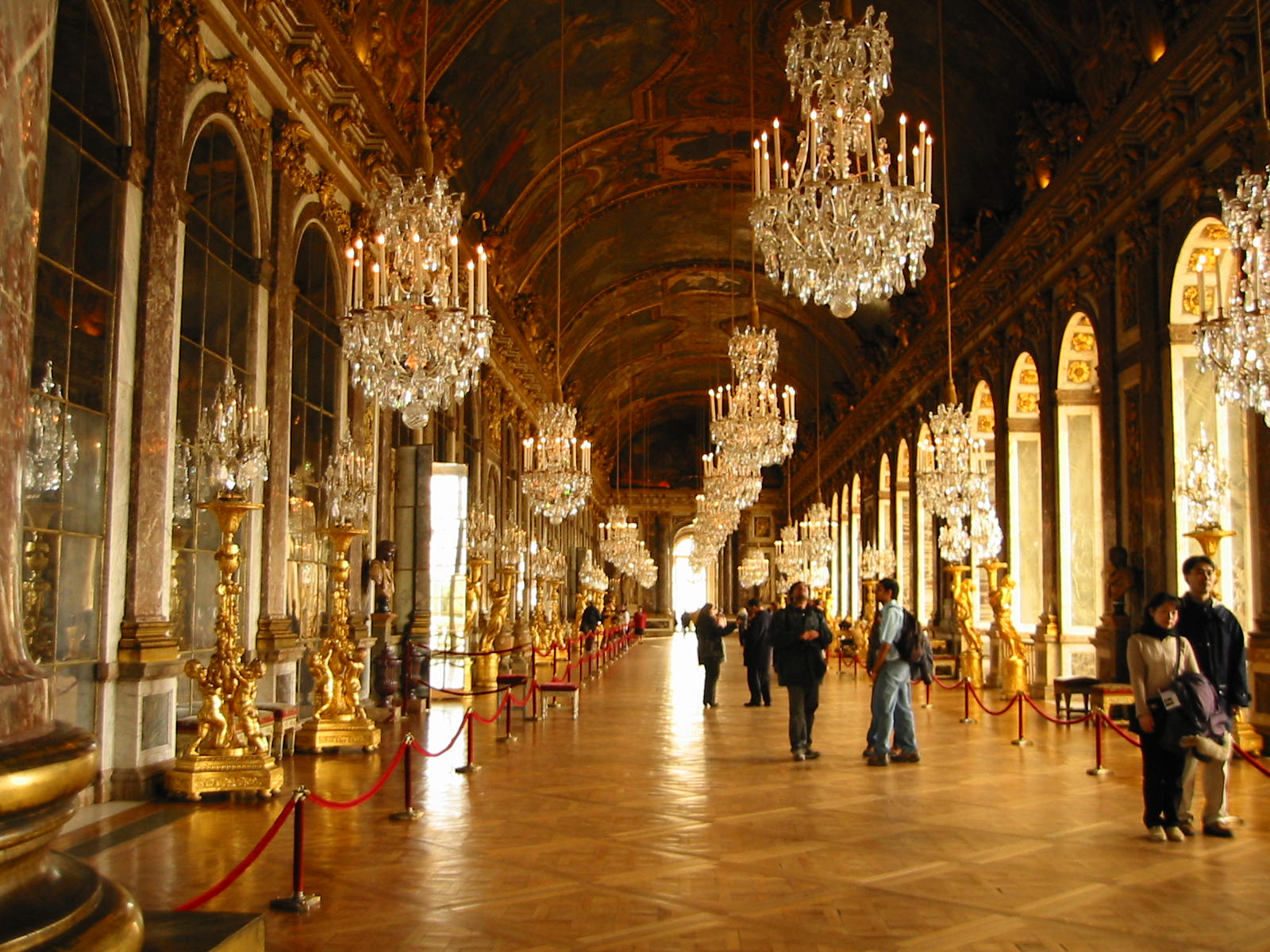

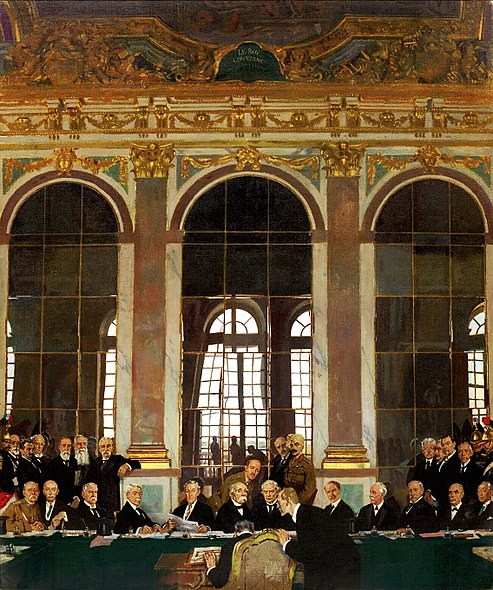
| H
A
L
L |  June 28, 1919 - Galerie des Glaces / Hall of Mirrors, Palace of Versailles, Versailles (France). This room was constructed by King Louis XIV in 1678-1684. It became a an "unintentional monument" with the signing of the Treaty of Versailles with Germany ending the World War I (1914–1918) & leading to the League of Nations. Click here for post cards. June 28, 1919 - Galerie des Glaces / Hall of Mirrors, Palace of Versailles, Versailles (France). This room was constructed by King Louis XIV in 1678-1684. It became a an "unintentional monument" with the signing of the Treaty of Versailles with Germany ending the World War I (1914–1918) & leading to the League of Nations. Click here for post cards.
| P
A
I
N
T
I
N
G |
  1919 - "Signing of Peace in the Hall of Mirrors,"
Imperial War Museum, London (England).
By Irish artist Sir William Orpen [1878- 1931]. Norman Stone (2009) says this "captured the political wrangling and vainglory of the gathered politicians and statesman whom Orpen came to loathe but increasingly relied upon for his post-war portrait commissions.
The peace-makers look extraordinarily pleased with them- selves as they pose for rather wooden immortaliation: silkiness of moustache, acuteness of gaze, dignity of stance. A Maharajah and a Japanese baron look on, evidence of the peace-makers' internationalism and benevolence. Clemenceau is said to have remarked that he was sitting between a would-be Napoleon (Lloyd George) and a would-be Jesus Christ (Wilson). 1919 - "Signing of Peace in the Hall of Mirrors,"
Imperial War Museum, London (England).
By Irish artist Sir William Orpen [1878- 1931]. Norman Stone (2009) says this "captured the political wrangling and vainglory of the gathered politicians and statesman whom Orpen came to loathe but increasingly relied upon for his post-war portrait commissions.
The peace-makers look extraordinarily pleased with them- selves as they pose for rather wooden immortaliation: silkiness of moustache, acuteness of gaze, dignity of stance. A Maharajah and a Japanese baron look on, evidence of the peace-makers' internationalism and benevolence. Clemenceau is said to have remarked that he was sitting between a would-be Napoleon (Lloyd George) and a would-be Jesus Christ (Wilson).
| "After World War-I, peace movements & their different aims & strategies multiplied. The International Peace Bureau (IPB) lost its central role, and the peace movement lost much of its direct influence over politics." -- From Santi (1991).


 | C
O
N
F |
 May 12-17, 1919 - 2nd International WILPF Congress, Zürich (Switzerland). "Because the French government refused permission to the German women delegates, the women's conference was held in Zürich." "ICWPP denounced the final terms of the peace treaty ending World War I as a scheme of revenge of the victors over the vanquished that would sow the seeds of another world war. They decided to make their committee permanent and renamed it the Women's International League for Peace & Freedom (WILPF). The WILPF moved its headquarters to Geneva to be near the proposed site of the League of Nations, although WILPF did not endorse empowering that organization to conduct food blockades or to use military pressure to enforce its resolutions." Right image is US delegation. May 12-17, 1919 - 2nd International WILPF Congress, Zürich (Switzerland). "Because the French government refused permission to the German women delegates, the women's conference was held in Zürich." "ICWPP denounced the final terms of the peace treaty ending World War I as a scheme of revenge of the victors over the vanquished that would sow the seeds of another world war. They decided to make their committee permanent and renamed it the Women's International League for Peace & Freedom (WILPF). The WILPF moved its headquarters to Geneva to be near the proposed site of the League of Nations, although WILPF did not endorse empowering that organization to conduct food blockades or to use military pressure to enforce its resolutions." Right image is US delegation.
|
 |
 1919 - First Pan-African Congress, Paris (France). "Organized by American W.E.B. Du Bois [1868-1963] assisted by Blaise Diagne [1872-1934], first black African elected to French National Assembly & mayor of Dakar.
There were 57 delegates representing 15 countries, a smaller number than originally intended because British & American governments refused to issue passports for their citizens who planned on attending. Their main task was petitioning the Versailles Peace Conference which was held in Paris at that time. Among their demands were:
(1) The Allies should be in charge of the administration of former territories in Africa as a Condominium on behalf of the Africans who were living there.
(2) Africa is granted home rule and Africans should take part in governing their countries as fast as their development permits until at some specified time in the future. The problem was that colonist offered no end in sight. Hence, the resistance and war pursued." 1919 - First Pan-African Congress, Paris (France). "Organized by American W.E.B. Du Bois [1868-1963] assisted by Blaise Diagne [1872-1934], first black African elected to French National Assembly & mayor of Dakar.
There were 57 delegates representing 15 countries, a smaller number than originally intended because British & American governments refused to issue passports for their citizens who planned on attending. Their main task was petitioning the Versailles Peace Conference which was held in Paris at that time. Among their demands were:
(1) The Allies should be in charge of the administration of former territories in Africa as a Condominium on behalf of the Africans who were living there.
(2) Africa is granted home rule and Africans should take part in governing their countries as fast as their development permits until at some specified time in the future. The problem was that colonist offered no end in sight. Hence, the resistance and war pursued."
|
 |
  October 29-November, 1919 - First annual conference (referred to as the International Labour Conference, or ILC) of the International Labour Organization (ILO) at the Pan-American Union, 17th Street, NW, Washington, DC (USA). Adopted the first six International Labour Conventions, which dealt with hours of work in industry, unemployment, maternity protection, night work for women, minimum age & night work for young persons in industry. Prominent French socialist Albert Thomas [1878-1932] (who did not attend the conference) became the ILO's first Director General. /// The ILO was esablished in 1919 an agency of the League of Nations. Because of its non-membership in the League, the USA did not join the ILO until 1934. /// Image shows the Secretarial Staff of the conference in front of the Pan American Building; it includes Ernest Greenwood, American Delegate, & Harold B. Butler, Secretary-General of ILC. October 29-November, 1919 - First annual conference (referred to as the International Labour Conference, or ILC) of the International Labour Organization (ILO) at the Pan-American Union, 17th Street, NW, Washington, DC (USA). Adopted the first six International Labour Conventions, which dealt with hours of work in industry, unemployment, maternity protection, night work for women, minimum age & night work for young persons in industry. Prominent French socialist Albert Thomas [1878-1932] (who did not attend the conference) became the ILO's first Director General. /// The ILO was esablished in 1919 an agency of the League of Nations. Because of its non-membership in the League, the USA did not join the ILO until 1934. /// Image shows the Secretarial Staff of the conference in front of the Pan American Building; it includes Ernest Greenwood, American Delegate, & Harold B. Butler, Secretary-General of ILC.
|


|
 1920 - League of Nations, Geneva (Switzerland). "The League's Assembly met in Geneva and, after its initial sessions in 1920, sessions were held once a year in September.
The League Council acted as a type of executive body directing the Assembly's business. The Council began with four permanent members (Great Britain, France, Italy, Japan) and four non-permanent members which were elected by the Assembly for a three year period. The first four non-permanent members were Belgium, Brazil, Greece and Spain. The United States was meant to be the fifth permanent member, but the US Senate voted on 19 March 1920 against the ratification of the Treaty of Versailles, thus preventing American participation in the League." Image shows first meeting of the Assembly in 1920. 1920 - League of Nations, Geneva (Switzerland). "The League's Assembly met in Geneva and, after its initial sessions in 1920, sessions were held once a year in September.
The League Council acted as a type of executive body directing the Assembly's business. The Council began with four permanent members (Great Britain, France, Italy, Japan) and four non-permanent members which were elected by the Assembly for a three year period. The first four non-permanent members were Belgium, Brazil, Greece and Spain. The United States was meant to be the fifth permanent member, but the US Senate voted on 19 March 1920 against the ratification of the Treaty of Versailles, thus preventing American participation in the League." Image shows first meeting of the Assembly in 1920. 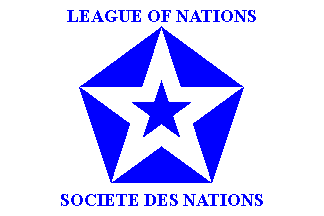
|  |  1920? - Cloche / Clock, Salle de l'Alabama / Hall of the Alabama, Hotel de Ville / City Hall, Geneva (Switzerland). "Une réplique en miniature de la Liberty Bell de Philadelphie. Cette cloche sonna l'ouverture de la première assemblée de la Société des Nations le 15 novembre 1920 à Genève, siège voulu par le Président américain Thomas Woodrow Wilson.." 1920? - Cloche / Clock, Salle de l'Alabama / Hall of the Alabama, Hotel de Ville / City Hall, Geneva (Switzerland). "Une réplique en miniature de la Liberty Bell de Philadelphie. Cette cloche sonna l'ouverture de la première assemblée de la Société des Nations le 15 novembre 1920 à Genève, siège voulu par le Président américain Thomas Woodrow Wilson.."  
| M
U
SE
U
M |  1946 - League of Nations Museum, Palais des Nations, B.328, Geneva (Switerland). Operated by the Library of the UN Office at Geneva (UNOG), the League of Nations Archives (LON) & Historical Collections Unit. Illustrates the history & work of the League of Nations [1919-1946]. 1946 - League of Nations Museum, Palais des Nations, B.328, Geneva (Switerland). Operated by the Library of the UN Office at Geneva (UNOG), the League of Nations Archives (LON) & Historical Collections Unit. Illustrates the history & work of the League of Nations [1919-1946]. 
|
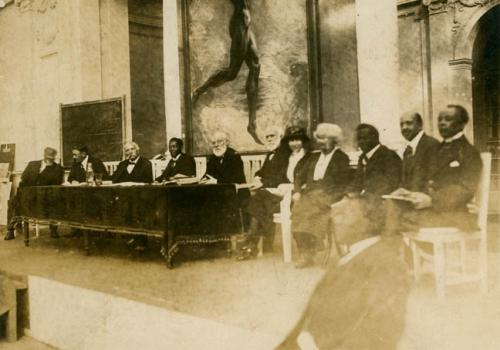 |

 1921 - Second Pan-African Congress, London (England). "Assembled black leaders from around the world issued the London Resolutions & established a Pan-African Association headquarters in Paris. Under the guidance of American W.E.B Du Bois [1868-1963], the resolutions insisted on racial equality & that Africa be ruled by Africans (not, as in the 1919 congress, with the consent of Africans). Du Bois restated the resolutions of the congress in his Manifesto To the League of Nations, which implored the newly formed League of Nations to address labor issues & to appoint Africans to key posts. The League took little action on the requests." Five additional congresses were held: 1923 in London, 1927 New York, 1945 Manchester, 1974 Dar es Salaam & 1994 Kampala. 1921 - Second Pan-African Congress, London (England). "Assembled black leaders from around the world issued the London Resolutions & established a Pan-African Association headquarters in Paris. Under the guidance of American W.E.B Du Bois [1868-1963], the resolutions insisted on racial equality & that Africa be ruled by Africans (not, as in the 1919 congress, with the consent of Africans). Du Bois restated the resolutions of the congress in his Manifesto To the League of Nations, which implored the newly formed League of Nations to address labor issues & to appoint Africans to key posts. The League took little action on the requests." Five additional congresses were held: 1923 in London, 1927 New York, 1945 Manchester, 1974 Dar es Salaam & 1994 Kampala.
|  July 10-17. 1921 - 3rd International WILPF Congress, Vienna (Austria). July 10-17. 1921 - 3rd International WILPF Congress, Vienna (Austria).
 August 10-13, 1921 - 21th Universal Peace Congress, Luxembourg. August 10-13, 1921 - 21th Universal Peace Congress, Luxembourg.
 |
  November 12, 1921-February 6, 1922 - Washington Naval Conference, Memorial Continental Hall, Washington, DC (USA). Also called the Washington Arms Conference.
A military conference called by the administration of President Warren G. Harding.
Conducted outside the auspices of the League of Nations. Attended by nine nations having interests in the Pacific Ocean and East Asia. Soviet Russia was not invited to the conference. The first international conference held in the USA and the first disarmament conference in history. Studied by political scientists as a model for a successful disarmament movement. Resulted in three major treaties: Four-Power Treaty, Five-Power Treaty (more commonly known as the Washington Naval Treaty) and the Nine-Power Treaty and a number of smaller agreements. These treaties preserved peace during the 1920's but are also credited with enabling the rise of the Japanese Empire as a naval power leading up to World War II." November 12, 1921-February 6, 1922 - Washington Naval Conference, Memorial Continental Hall, Washington, DC (USA). Also called the Washington Arms Conference.
A military conference called by the administration of President Warren G. Harding.
Conducted outside the auspices of the League of Nations. Attended by nine nations having interests in the Pacific Ocean and East Asia. Soviet Russia was not invited to the conference. The first international conference held in the USA and the first disarmament conference in history. Studied by political scientists as a model for a successful disarmament movement. Resulted in three major treaties: Four-Power Treaty, Five-Power Treaty (more commonly known as the Washington Naval Treaty) and the Nine-Power Treaty and a number of smaller agreements. These treaties preserved peace during the 1920's but are also credited with enabling the rise of the Japanese Empire as a naval power leading up to World War II."
|

 |
 1922 - Emergency Peace Conference, the Hague (Netherlands). Also called Conference for a New Peace. "Calls for the convening of a World Congress to draw up a new agreement for a genuine peace." Attended by WILPF (Catherine Marshall, Jane Addams, Jeanne Melin) & other organizations. 1922 - Emergency Peace Conference, the Hague (Netherlands). Also called Conference for a New Peace. "Calls for the convening of a World Congress to draw up a new agreement for a genuine peace." Attended by WILPF (Catherine Marshall, Jane Addams, Jeanne Melin) & other organizations.
|
  July 25-29, 1922 - 22nd Universal Peace Congress, London (England). July 25-29, 1922 - 22nd Universal Peace Congress, London (England).
 |
  1924 - 4th International WILPF Congress, Washington, DC (USA). Women's International League for Peace & Freedom (WILPF). Click here for all international congresses of the WILPF from 1915 to 2015. Attended by Andrée Jouve, Gabrielle Duchêne, Cor. Ramondt-Hirschmann, Jane Addams, Gertrude Baer, Marguerite Dumond, Ida Perry Johnson, Zonia Baber & Mabel Powers, among others. 1924 - 4th International WILPF Congress, Washington, DC (USA). Women's International League for Peace & Freedom (WILPF). Click here for all international congresses of the WILPF from 1915 to 2015. Attended by Andrée Jouve, Gabrielle Duchêne, Cor. Ramondt-Hirschmann, Jane Addams, Gertrude Baer, Marguerite Dumond, Ida Perry Johnson, Zonia Baber & Mabel Powers, among others.
|
 October 2-8, 1924 - 23rd Universal Peace Congress, Berlin (Germany). October 2-8, 1924 - 23rd Universal Peace Congress, Berlin (Germany).
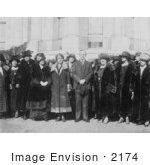 |
  January 18-25, 1925 - 1st Conference on the Cause & Cure of War, Washington, DC (USA). Had 450 delegates from nine organizations representing five million women members. Organized by suffragette Carrie Chapman Catt [1859-1947] who proposed a Department of Peace headed by a Cabinet level Secretary of Peace. The conference created the National Committee on the Cause & Cure of War (NCCCW). "Conferences thereafter were held annually until 1941, when the 16th was canceled due to lack of funds." January 18-25, 1925 - 1st Conference on the Cause & Cure of War, Washington, DC (USA). Had 450 delegates from nine organizations representing five million women members. Organized by suffragette Carrie Chapman Catt [1859-1947] who proposed a Department of Peace headed by a Cabinet level Secretary of Peace. The conference created the National Committee on the Cause & Cure of War (NCCCW). "Conferences thereafter were held annually until 1941, when the 16th was canceled due to lack of funds."
|
 
 |
 August 1925 - 14th World Zionist Congress, Concert Hall, Vienna (Austria).
"Zionist Congresses, held at various locations in Europe, were accompanied by exhibits of industrial & farm products of the Land of Israel. Delegates from around the Jewish world encountered, some for the first time, the industrial and agricultural accomplishments of Jewish settlement in the Land of Israel. The selection may have been limited, but every product attracted great interest." Left image is poster for the Palestine Exhibition at the 14th Congress. (Later called Eretz Israel, Palestine would become the State of Israel in 1948.) Right image is post card from the congress with inset photo of Dr. Theodor Herzl [1860-1904], father of Zionism. August 1925 - 14th World Zionist Congress, Concert Hall, Vienna (Austria).
"Zionist Congresses, held at various locations in Europe, were accompanied by exhibits of industrial & farm products of the Land of Israel. Delegates from around the Jewish world encountered, some for the first time, the industrial and agricultural accomplishments of Jewish settlement in the Land of Israel. The selection may have been limited, but every product attracted great interest." Left image is poster for the Palestine Exhibition at the 14th Congress. (Later called Eretz Israel, Palestine would become the State of Israel in 1948.) Right image is post card from the congress with inset photo of Dr. Theodor Herzl [1860-1904], father of Zionism.
|
 |
 August 18-30, 1925 - First Universal Christian Conference on Life & Work, Stockholm, (Sweden). The conference is "designed to deal with the relationship between Christ & economics, industry, social and moral problems, international relations and education." The leader of the Life and Work movement is Nathan Soderblom [1866-1931], professor of the history of religions in Leipzig (Germany) & archbishop of Uppsala (Sweden). He will receive the Nobel Peace Prize in 1930. Is there ever a 2nd conference of this name? /// Attended by a small group of American Disciples led by George Sherwood Eddy [1871-1963] (former missionary, YMCA official, world traveller & popular lecturer). Members of his group include Peter Ainslie [1867-1934] (founder & pastor of the Christian Temple in Baltimore, Maryland, & a famous advocate of Christian unity), Mary Elizabeth Weisel (Ainslie's bride), George Alexander Campbell [1869-1943] of St. Louis, Missouri (my grandfather) & Luna May Jameson Campbell (my grandmother). Also attended by Arthur Judson Brown [1856-1963]. August 18-30, 1925 - First Universal Christian Conference on Life & Work, Stockholm, (Sweden). The conference is "designed to deal with the relationship between Christ & economics, industry, social and moral problems, international relations and education." The leader of the Life and Work movement is Nathan Soderblom [1866-1931], professor of the history of religions in Leipzig (Germany) & archbishop of Uppsala (Sweden). He will receive the Nobel Peace Prize in 1930. Is there ever a 2nd conference of this name? /// Attended by a small group of American Disciples led by George Sherwood Eddy [1871-1963] (former missionary, YMCA official, world traveller & popular lecturer). Members of his group include Peter Ainslie [1867-1934] (founder & pastor of the Christian Temple in Baltimore, Maryland, & a famous advocate of Christian unity), Mary Elizabeth Weisel (Ainslie's bride), George Alexander Campbell [1869-1943] of St. Louis, Missouri (my grandfather) & Luna May Jameson Campbell (my grandmother). Also attended by Arthur Judson Brown [1856-1963].
|
 September 1-6, 1925 - 24th Universal Peace Congress, Paris (France). September 1-6, 1925 - 24th Universal Peace Congress, Paris (France).
 |
 October 5-16, 1925 - Locarno Treaties, Locarno (Switzerland). Seven agreements negotiated at Locarno & formally signed in London on 3 December, in which the First World War Western European Allied powers & the new states of central and Eastern Europe sought to secure the post-war territorial settlement, & return normalizing relations with defeated Germany (which was, by this time, the Weimar Republic). Image shows German Foreign Minister Gustav Stresemann [1878-1929], UK Secretary of State for Foreign Affairs Austen Chamberlain [1863-1937] & French Foreign Minister Aristide Briand [1862-1932] during the Locarno negotiations. Stresemann & Briand received the Nobel Peace Prize for 1926. Chamberlain & Charles G. Dawes [1865-1951] received the prize for 1925. October 5-16, 1925 - Locarno Treaties, Locarno (Switzerland). Seven agreements negotiated at Locarno & formally signed in London on 3 December, in which the First World War Western European Allied powers & the new states of central and Eastern Europe sought to secure the post-war territorial settlement, & return normalizing relations with defeated Germany (which was, by this time, the Weimar Republic). Image shows German Foreign Minister Gustav Stresemann [1878-1929], UK Secretary of State for Foreign Affairs Austen Chamberlain [1863-1937] & French Foreign Minister Aristide Briand [1862-1932] during the Locarno negotiations. Stresemann & Briand received the Nobel Peace Prize for 1926. Chamberlain & Charles G. Dawes [1865-1951] received the prize for 1925. 
|
 1926 - First Congress of the International Paneuropean Union, Vienna (Austria). Also called the Paneuropean Movement & the Pan-Europa Movement (not to be confused with the European Union). Organized & led for 49 years by count, geopolitician & philosopher Richard Nikolaus Coudenhove-Kalergi [1894-1972]. His first book, titled "Pan-Europa," was published in 1923 & contained a membership form for the Pan-Europa movement. In 1927, Aristide Briand was elected honorary president. Personalities attending included: Albert Einstein, Thomas Mann & Sigmund Freud. 1926 - First Congress of the International Paneuropean Union, Vienna (Austria). Also called the Paneuropean Movement & the Pan-Europa Movement (not to be confused with the European Union). Organized & led for 49 years by count, geopolitician & philosopher Richard Nikolaus Coudenhove-Kalergi [1894-1972]. His first book, titled "Pan-Europa," was published in 1923 & contained a membership form for the Pan-Europa movement. In 1927, Aristide Briand was elected honorary president. Personalities attending included: Albert Einstein, Thomas Mann & Sigmund Freud.
 August 28-September 3, 1926 - 25th Universal Peace Congress, Geneva (Switzerland). August 28-September 3, 1926 - 25th Universal Peace Congress, Geneva (Switzerland).
 Spring 1927 - First Geneva Naval Conference, Geneva (Switzerland). Held to discuss naval arms limitation Spring 1927 - First Geneva Naval Conference, Geneva (Switzerland). Held to discuss naval arms limitation

|   May 7-11, 1928 - First World Conference on International Justice, Cleveland, Ohio (USA). Attended by 13,000. "'There never has been a gathering in the US so cosmopolitan as this Conference, nor one in which so many diplomats from foreign countries participated,' said Congressman Theodore Elijah Burton [1851-1929], president of the American Peace Society, at its centennial meeting in Cleveland. The five days of the Conference were called Ohio Day, Centennial Day, Neighbors Day, World Day & Report Day. On the last day, five Commissions reported their findings on how the fields of Commerce & Industry, Justice, Education, Religion & the Social Agencies could better be utilized to insure world peace & international understanding. Speakers at the Conference included ambassadors, ministers & official representatives from England, France, Germany, Norway, Poland, Russia, Canada, Cuba, Nicaragua, Japan, Finland, Hungary, Lithuania, China, Ireland, Roumania, Czechoslovakia & Italy. Prominent churchmen, educators, clubwomen, judges, business men & social workers also spoke. The excellent work accomplished by this Conference brings the world a step closer to the goal of world peace." May 7-11, 1928 - First World Conference on International Justice, Cleveland, Ohio (USA). Attended by 13,000. "'There never has been a gathering in the US so cosmopolitan as this Conference, nor one in which so many diplomats from foreign countries participated,' said Congressman Theodore Elijah Burton [1851-1929], president of the American Peace Society, at its centennial meeting in Cleveland. The five days of the Conference were called Ohio Day, Centennial Day, Neighbors Day, World Day & Report Day. On the last day, five Commissions reported their findings on how the fields of Commerce & Industry, Justice, Education, Religion & the Social Agencies could better be utilized to insure world peace & international understanding. Speakers at the Conference included ambassadors, ministers & official representatives from England, France, Germany, Norway, Poland, Russia, Canada, Cuba, Nicaragua, Japan, Finland, Hungary, Lithuania, China, Ireland, Roumania, Czechoslovakia & Italy. Prominent churchmen, educators, clubwomen, judges, business men & social workers also spoke. The excellent work accomplished by this Conference brings the world a step closer to the goal of world peace." |
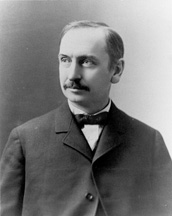
Burton
|
 June 25-28, 1928 - 26th Universal Peace Congress, Warsaw (Poland). June 25-28, 1928 - 26th Universal Peace Congress, Warsaw (Poland).
|

|  August 28, 1928 - Kellogg–Briand Pact. "Also called 'General Treaty for the Renunciation of War' & 'World Peace Act.' Signed by the USA, France, UK, Italy, Japan, Weimar Germany & a number of other countries such as the Second Polish Republic & the Irish Free State. The pact renounced war, seeking to prohibit its use as 'an instrument of national policy' but made no provisions for sanctions. Resulted from a determined American effort to avoid involvement in the European alliance system. It was registered in League of Nations Treaty Series on September 4, 1928." /// Signing attended by Rev Charles Clayton Morrison [1874-1966], editor of The Christian Century.
US Secretary of State Frank Billings Kellogg [1856-1937] received the Nobel Peace prize in 1929. French Foreign Minister Aristide Briand [1862-1932] had already received the it in 1926, & August 28, 1928 - Kellogg–Briand Pact. "Also called 'General Treaty for the Renunciation of War' & 'World Peace Act.' Signed by the USA, France, UK, Italy, Japan, Weimar Germany & a number of other countries such as the Second Polish Republic & the Irish Free State. The pact renounced war, seeking to prohibit its use as 'an instrument of national policy' but made no provisions for sanctions. Resulted from a determined American effort to avoid involvement in the European alliance system. It was registered in League of Nations Treaty Series on September 4, 1928." /// Signing attended by Rev Charles Clayton Morrison [1874-1966], editor of The Christian Century.
US Secretary of State Frank Billings Kellogg [1856-1937] received the Nobel Peace prize in 1929. French Foreign Minister Aristide Briand [1862-1932] had already received the it in 1926, & 
|  1928-1937 - On 11 October 1928, a Graf Zeppelin airship begins the first non-stop transatlantic passenger flights, leaving Friedrichshafen (Germany) & arriving at NAS Lakehurst, New Jersey (USA), on 15 October. In 1936, the Hindenburg enters passenger service & makes 36 crossings of the North & South Atlantic. Both routes operated a regularly scheduled timetable until the cessation of passenger Zeppelin operations following the Hindenburg disaster in May 1937. Regularly scheduled transatlantic service by commercial airplanes does not begin until immediately after World War II. 1928-1937 - On 11 October 1928, a Graf Zeppelin airship begins the first non-stop transatlantic passenger flights, leaving Friedrichshafen (Germany) & arriving at NAS Lakehurst, New Jersey (USA), on 15 October. In 1936, the Hindenburg enters passenger service & makes 36 crossings of the North & South Atlantic. Both routes operated a regularly scheduled timetable until the cessation of passenger Zeppelin operations following the Hindenburg disaster in May 1937. Regularly scheduled transatlantic service by commercial airplanes does not begin until immediately after World War II.
 October 6-10, 1929 - 27th Universal Peace Congress, Athens (Greece). Also called the "Congress of Universal Peace." October 6-10, 1929 - 27th Universal Peace Congress, Athens (Greece). Also called the "Congress of Universal Peace."


 |  1929-Destroyed in 1940's - Peace Lighthouse, summit of Mount Lycabettus, Athens (Greece). "In honor of the meeting in Athens, Greece, of the [27th] Congress of Universal Peace... The dedication took place after the arrival of the members... At eight P.M. 600 Boy Scouts, carrying Venetian lanterns, started marching through the city and up to the summit of the mountain, where they lighted the Peace Lighthouse, which shone like an enormous star thoughout the sessions of the Congress. It was to be re-lighted each time the League of Nations was in session. [But] this monument was destroyed by the Germans when they moved into Greece in World War II."
1 of 40 monuments in "Peace Symbols" by Zonia Baber (1948), pp. 40-41. Left image scanned from Baber. All information from Baber. NB: Baber dates this monument from 1930, but the conference took place October 6-10, 1929. 1929-Destroyed in 1940's - Peace Lighthouse, summit of Mount Lycabettus, Athens (Greece). "In honor of the meeting in Athens, Greece, of the [27th] Congress of Universal Peace... The dedication took place after the arrival of the members... At eight P.M. 600 Boy Scouts, carrying Venetian lanterns, started marching through the city and up to the summit of the mountain, where they lighted the Peace Lighthouse, which shone like an enormous star thoughout the sessions of the Congress. It was to be re-lighted each time the League of Nations was in session. [But] this monument was destroyed by the Germans when they moved into Greece in World War II."
1 of 40 monuments in "Peace Symbols" by Zonia Baber (1948), pp. 40-41. Left image scanned from Baber. All information from Baber. NB: Baber dates this monument from 1930, but the conference took place October 6-10, 1929. 

|


|
  January 21-April 22, 1930 - Second London Naval Conference, London (England). This was the second of three major international naval conferences in London. The first was December 4, 1908-February 26, 1909, and the third in December 1935. The latter two, together with the Washington Naval Conference in 1921-22 and the Geneva Conferences (1927 and 1932), resulted in agreements between the major powers on navy vessel numbers, armaments and the rules of engagement in the inter-war period. Upper image shows members of the US delegation on board the passenger liner George Washington while en route to the conference in January 1930. Lower image shows Harry of Harry's New York Bar in Paris initiating Sam Schulman, International News Photos' cameraman in Paris, to the taste of the mysterious 'parity' cocktail named in honor of the London naval conference. It is made of equal parts of Scotch for England, Rye (?) for America, Italian Vermouth for Italy, French Vermouth for France, and Sake or Rice brandy for Japan." January 21-April 22, 1930 - Second London Naval Conference, London (England). This was the second of three major international naval conferences in London. The first was December 4, 1908-February 26, 1909, and the third in December 1935. The latter two, together with the Washington Naval Conference in 1921-22 and the Geneva Conferences (1927 and 1932), resulted in agreements between the major powers on navy vessel numbers, armaments and the rules of engagement in the inter-war period. Upper image shows members of the US delegation on board the passenger liner George Washington while en route to the conference in January 1930. Lower image shows Harry of Harry's New York Bar in Paris initiating Sam Schulman, International News Photos' cameraman in Paris, to the taste of the mysterious 'parity' cocktail named in honor of the London naval conference. It is made of equal parts of Scotch for England, Rye (?) for America, Italian Vermouth for Italy, French Vermouth for France, and Sake or Rice brandy for Japan."
|
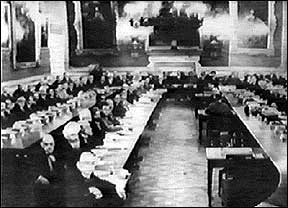
|   November 12, 1930-January 1931 - First Round Table Conference, London (England). First of three conferences held to discuss constitutional reforms in India. "Chaired by British PM Ramsay MacDonald. The three British political parties were represented by 16 delegates. There were 57 political leaders from British India & 16 delegates from the princely states." November 12, 1930-January 1931 - First Round Table Conference, London (England). First of three conferences held to discuss constitutional reforms in India. "Chaired by British PM Ramsay MacDonald. The three British political parties were represented by 16 delegates. There were 57 political leaders from British India & 16 delegates from the princely states."
|  July 5-10, 1931 - 28th Universal Peace Congress, Brussels (Belgium). July 5-10, 1931 - 28th Universal Peace Congress, Brussels (Belgium).



|   September 7-December 1931 - Second Round Table Conference, London (England). 2nd of three conferences held to discuss constitutional reforms in India. Mahatma Gandhi [in both images] attended as the sole official representative of the Congress party. Gandhi was a guest of pacifist Muriel Lester at Kingsley Hall in the East End (8 miles from the conference site). September 7-December 1931 - Second Round Table Conference, London (England). 2nd of three conferences held to discuss constitutional reforms in India. Mahatma Gandhi [in both images] attended as the sole official representative of the Congress party. Gandhi was a guest of pacifist Muriel Lester at Kingsley Hall in the East End (8 miles from the conference site).
|



| C
O
N
F
E
R
E
C
E |  February 1932 to May 1937 - Conference for the Reduction & Limitation of Armaments of 1932-34, Geneva (Switzerland). Sometimes called World Disarmament Conference or Geneva Disarmament Conference. "An effort by member states of the League of Nations, together with the USA and the Soviet Union, to actualize the ideology of disarmament. Ostensibly it took place between 1932 and 1934, but more correctly until May 1937." Some progress was made, but when Hitler came into power in 1933 he took Germany out of the Geneva Conference and the League of Nations, which was questionable but nothing was done about it." Top 2 images show members of the Women's International League for Peace & Friendship (WILPF) delivering Petition for Universal Disarmament, Peace & Freedom with 6,000,000 signatures. Click here for video. How does this conference differ from the Second Geneva Naval Conference (qv)? February 1932 to May 1937 - Conference for the Reduction & Limitation of Armaments of 1932-34, Geneva (Switzerland). Sometimes called World Disarmament Conference or Geneva Disarmament Conference. "An effort by member states of the League of Nations, together with the USA and the Soviet Union, to actualize the ideology of disarmament. Ostensibly it took place between 1932 and 1934, but more correctly until May 1937." Some progress was made, but when Hitler came into power in 1933 he took Germany out of the Geneva Conference and the League of Nations, which was questionable but nothing was done about it." Top 2 images show members of the Women's International League for Peace & Friendship (WILPF) delivering Petition for Universal Disarmament, Peace & Freedom with 6,000,000 signatures. Click here for video. How does this conference differ from the Second Geneva Naval Conference (qv)?

|
M
E
M
O
R
I
A
L |   June 21, 1936 - "Anti-Air War Memorial," NW of Mornington Road & the High Road, Woodford Green, Essex, near London (England). Bottom image. Sculpted by Eric Benfield in the shape of a bomb for suffrigist (and onetime communist) Sylvia Pankhurst [1882-1960]. Rededicated on July 4, 1936, after being vandalized. "In October 1935, Pankhurst was outraged by Mussolini's assault on Ethiopia, the only part of Africa that remained independent and had joined the League of Nations. Unveiled that same month by a group that included Pankhurst and [Tesfaye] Zaphiro, the secretary of the Imperial Ethiopian Legation, the monument stood prominently outside Red Cottage [which Pankhurst shared with Italian anarchist Silvio Corio] along with a plaque dedicating it ironically to politicians who, at the World Disarmament Conference [which] opened in Geneva in February 1932, 'upheld the right to use bombing planes.'" One of 21 peace monuments named by the PPU website. Named in "A Peace Trail Through London" by Valerie Flessati (1998). June 21, 1936 - "Anti-Air War Memorial," NW of Mornington Road & the High Road, Woodford Green, Essex, near London (England). Bottom image. Sculpted by Eric Benfield in the shape of a bomb for suffrigist (and onetime communist) Sylvia Pankhurst [1882-1960]. Rededicated on July 4, 1936, after being vandalized. "In October 1935, Pankhurst was outraged by Mussolini's assault on Ethiopia, the only part of Africa that remained independent and had joined the League of Nations. Unveiled that same month by a group that included Pankhurst and [Tesfaye] Zaphiro, the secretary of the Imperial Ethiopian Legation, the monument stood prominently outside Red Cottage [which Pankhurst shared with Italian anarchist Silvio Corio] along with a plaque dedicating it ironically to politicians who, at the World Disarmament Conference [which] opened in Geneva in February 1932, 'upheld the right to use bombing planes.'" One of 21 peace monuments named by the PPU website. Named in "A Peace Trail Through London" by Valerie Flessati (1998). 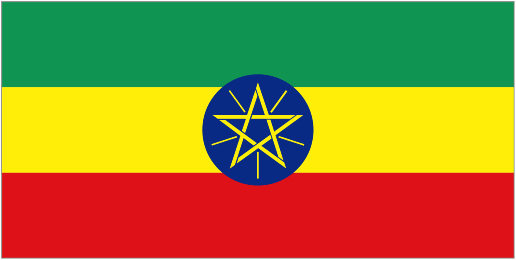
|
 September 4-9, 1932 - 29th Universal Peace Congress, Vienna (Austria). September 4-9, 1932 - 29th Universal Peace Congress, Vienna (Austria).
 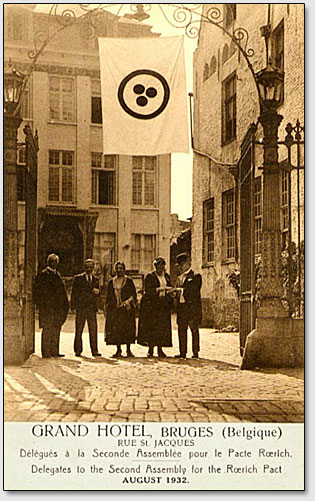
 |  August 1932 -
Second international conference (assembly?) for the Roerich Pact, Grand Hotel, Bruges (Belgium). Image shows five delegates in the street under a Pax Cultura banner. August 1932 -
Second international conference (assembly?) for the Roerich Pact, Grand Hotel, Bruges (Belgium). Image shows five delegates in the street under a Pax Cultura banner. | 
|

|  August 27-29, 1932 - World Congress Against War, Amsterdam (Netherlands). "2,196 delegates from 27 countries representing 30,000,000 people. During the conference the American League Against War & Fascism [ALAWF] was formed." // "One of the Congresses Against War (against imperialist, but favoring Red civil war), organized & controlled by Moscow's Intl. League Against Imperialism. The same leaders have since organized the Student Congress Against War (U. of Chgo., Dec. 1932); World Congress of Youth Against War (Paris, 1933); US Congress Against War (Sept. 29-Oct. 2, 1933, NY City); a Congress barred from Shanghai, 1933," etc. American delegates to the Amsterdam Congress included Sherwood Anderson, Mother Bloor, Theodore Dreiser, John Dos Pasos, Corliss Lamont, Lola Maverick Lloyd, Clara Meltzer & Scott Nearing." (Click here for most bios.) August 27-29, 1932 - World Congress Against War, Amsterdam (Netherlands). "2,196 delegates from 27 countries representing 30,000,000 people. During the conference the American League Against War & Fascism [ALAWF] was formed." // "One of the Congresses Against War (against imperialist, but favoring Red civil war), organized & controlled by Moscow's Intl. League Against Imperialism. The same leaders have since organized the Student Congress Against War (U. of Chgo., Dec. 1932); World Congress of Youth Against War (Paris, 1933); US Congress Against War (Sept. 29-Oct. 2, 1933, NY City); a Congress barred from Shanghai, 1933," etc. American delegates to the Amsterdam Congress included Sherwood Anderson, Mother Bloor, Theodore Dreiser, John Dos Pasos, Corliss Lamont, Lola Maverick Lloyd, Clara Meltzer & Scott Nearing." (Click here for most bios.)
|
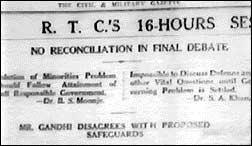
|   November 17-December 1932 - Third Round Table Conference, London (England). Last of 3 conferences held to discuss constitutional reforms in India. "During this conference, Chaudhary Rahmat Ali, a college student, coined the name 'Pakistan' (which means 'land of pureness') as the name for the Muslim part of partitioned India." November 17-December 1932 - Third Round Table Conference, London (England). Last of 3 conferences held to discuss constitutional reforms in India. "During this conference, Chaudhary Rahmat Ali, a college student, coined the name 'Pakistan' (which means 'land of pureness') as the name for the Muslim part of partitioned India."
|

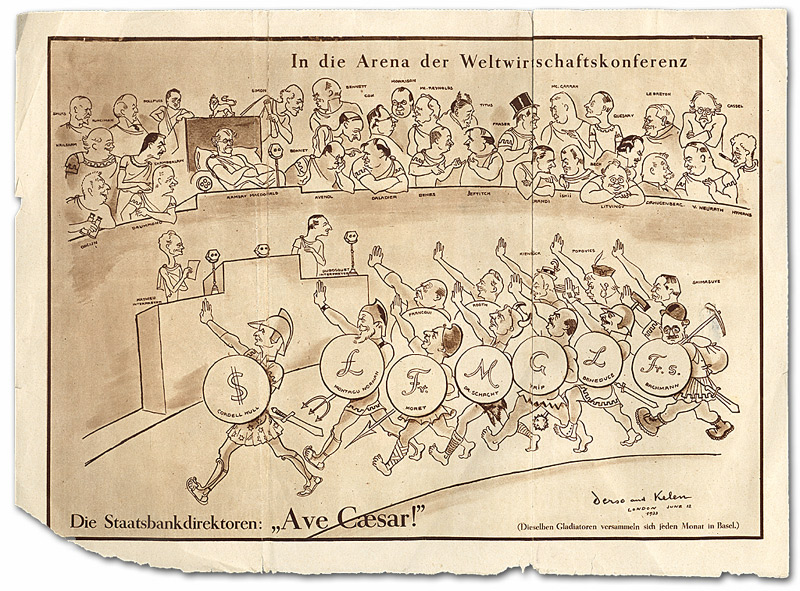
 |
C
O
N
F |   June 12-July 27, 1933 - World Economic Conference, Geological Museum, London (England). "A meeting of [1,000 top finance & government officials] from 66 nations. Its purpose was to win agreement on measures to fight global depression, revive trade & stabilize currency exchange rates. The Conference was 'torpedoed' by US President Roosevelt in early July, when Roosevelt denounced currency stabilization." Right image is a German cartoon showing central bank governors parading in a Roman arena & saluting conference president Ramsay MacDonald [1866-1937] with "Hail Caesar!" June 12-July 27, 1933 - World Economic Conference, Geological Museum, London (England). "A meeting of [1,000 top finance & government officials] from 66 nations. Its purpose was to win agreement on measures to fight global depression, revive trade & stabilize currency exchange rates. The Conference was 'torpedoed' by US President Roosevelt in early July, when Roosevelt denounced currency stabilization." Right image is a German cartoon showing central bank governors parading in a Roman arena & saluting conference president Ramsay MacDonald [1866-1937] with "Hail Caesar!"
|
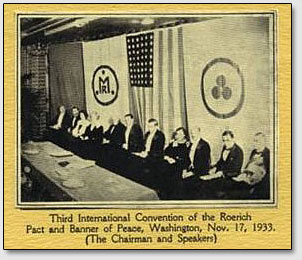 |
  November 17, 1933 - 3rd International Conference of the Roerich Pact & Banner of Peace, Washington, DC (USA). November 17, 1933 - 3rd International Conference of the Roerich Pact & Banner of Peace, Washington, DC (USA). | 
|  August 5-7, 1933 - World Congress of Youth Against War & Fascism, Paris (France). "Organized by the International & American Committees for Struggle Against War controlled by Moscow's communist Intl. Leaque Against Imperialism leaders, who organized the World Congress Against War at Amsterdam & its successors." August 5-7, 1933 - World Congress of Youth Against War & Fascism, Paris (France). "Organized by the International & American Committees for Struggle Against War controlled by Moscow's communist Intl. Leaque Against Imperialism leaders, who organized the World Congress Against War at Amsterdam & its successors."
  September 29-October 1, 1933 - United States Congress Against War, New York City, New York (USA). During which the program of the American League Against War & Fascism (ALAWF) was adopted. September 29-October 1, 1933 - United States Congress Against War, New York City, New York (USA). During which the program of the American League Against War & Fascism (ALAWF) was adopted.
 September 1-6, 1934 - 30th Universal Peace Congress, Locarno (Switzerland). September 1-6, 1934 - 30th Universal Peace Congress, Locarno (Switzerland).
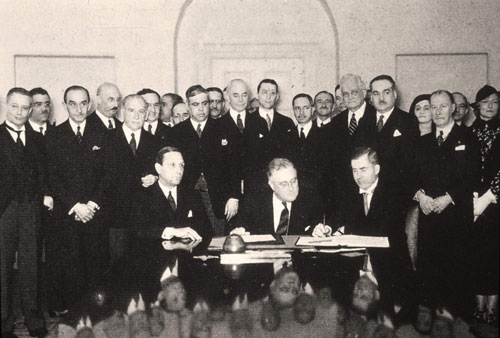
|   April 15, 1935 - Signing of the International Pact for the Protection of Artistic and Scientific Institutions and Historic Sites (Roerich's Pact), White House, Washington, DC (USA). "Signed with the participation of US President Franklin D. Roosevelt. The first international act especially devoted to the protection of cultural values. Originally ratified by 21 countries of the American continent [sic]. Later validated by 15 more countries." Click here for the text of the treaty. See 1954 Hague Convention for the Protection of Cultural Property in the Event of Armed Conflict. April 15, 1935 - Signing of the International Pact for the Protection of Artistic and Scientific Institutions and Historic Sites (Roerich's Pact), White House, Washington, DC (USA). "Signed with the participation of US President Franklin D. Roosevelt. The first international act especially devoted to the protection of cultural values. Originally ratified by 21 countries of the American continent [sic]. Later validated by 15 more countries." Click here for the text of the treaty. See 1954 Hague Convention for the Protection of Cultural Property in the Event of Armed Conflict. | 
|
 |
  December 1935-March 1936 - Third London Naval Conference, London (England). This was the third of three major international naval conferences in London. The first was December 4, 1908-February 26, 1909, and the second January 21-April 22, 1930. The latter two, together with the Washington Naval Conference in 1921-22 and the Geneva Conferences (1927 and 1932), resulted in agreements between the major powers on navy vessel numbers, armaments and the rules of engagement in the inter-war period. Image showns "participants from Italy, France, the US, the UK and Japan attend[ing] the Five-Power Naval Conference discussing limitations on naval armaments in 1935, in the Locarno Room of the Foreign Office in London." December 1935-March 1936 - Third London Naval Conference, London (England). This was the third of three major international naval conferences in London. The first was December 4, 1908-February 26, 1909, and the second January 21-April 22, 1930. The latter two, together with the Washington Naval Conference in 1921-22 and the Geneva Conferences (1927 and 1932), resulted in agreements between the major powers on navy vessel numbers, armaments and the rules of engagement in the inter-war period. Image showns "participants from Italy, France, the US, the UK and Japan attend[ing] the Five-Power Naval Conference discussing limitations on naval armaments in 1935, in the Locarno Room of the Foreign Office in London."
|
  June 13-19, 1936 - 31st Universal Peace Congress, Cardiff (Wales). June 13-19, 1936 - 31st Universal Peace Congress, Cardiff (Wales).
 |  1936 - Palais des Nations / Palace of Nations, Geneva (Switzerland). Built for the League of Nations. Since the 1950s, it has served as the home of the UN Office at Geneva. 1936 - Palais des Nations / Palace of Nations, Geneva (Switzerland). Built for the League of Nations. Since the 1950s, it has served as the home of the UN Office at Geneva.  
|

|  August 1939 - "Armillary Sphere," Ariana Park, Palais des Nations / Palace of Nations, Geneva (Switzerland). 410 cm in diameter. Weighs some 5,800 kg. Also called Celestial Sphere. By Paul Manship [1885-1966]. Presented by the Woodrow Wilson Foundation in memory of the founder of the League of Nations. August 1939 - "Armillary Sphere," Ariana Park, Palais des Nations / Palace of Nations, Geneva (Switzerland). 410 cm in diameter. Weighs some 5,800 kg. Also called Celestial Sphere. By Paul Manship [1885-1966]. Presented by the Woodrow Wilson Foundation in memory of the founder of the League of Nations.
  
|

|  December 1-23, 1936 - Inter-American Conference for the Maintenance of Peace, Buenos Aires (Argentina). "US President Franklin D. Roosevelt's concern over the rise of fascism in Europe prompted him in early 1936 to suggest a meeting of the American republics to discuss the maintenance of peace in the Western Hemisphere. Such a meeting would allow Roosevelt to promote his 'Good Neighbor Policy' toward Latin America, which drastically limited US definitions of intervention. Latin American leaders agreed to a conference & placed neutrality, arms limitations & foreign intervention high on the agenda.
Argentina's Minister of Foreign Affairs & Nobel Peace Prize winner Carlos Saavedra Lamas [1878-1959] presided, & US Secretary of State Cordell Hull [1871-1955] led the American delegation. As a show of good faith, the US gave up some of its intervention rights. The American republics agreed to a policy of nonintervention toward one another & to collaborate on responses to disagreements. Lamas, however, clashed with Hull when the US attempted to form a block of nations opposed to European fascism. Unlike the isolationist US, Argentina had crafted a foreign & economic policy tied to Europe. The nations reached no agreement on the American initiative." /// Preceeded by Cordell Hull's famously saying, "Peace must be our passion," in Rio-de-Janeiro (Brazil) on November 19, 1936. December 1-23, 1936 - Inter-American Conference for the Maintenance of Peace, Buenos Aires (Argentina). "US President Franklin D. Roosevelt's concern over the rise of fascism in Europe prompted him in early 1936 to suggest a meeting of the American republics to discuss the maintenance of peace in the Western Hemisphere. Such a meeting would allow Roosevelt to promote his 'Good Neighbor Policy' toward Latin America, which drastically limited US definitions of intervention. Latin American leaders agreed to a conference & placed neutrality, arms limitations & foreign intervention high on the agenda.
Argentina's Minister of Foreign Affairs & Nobel Peace Prize winner Carlos Saavedra Lamas [1878-1959] presided, & US Secretary of State Cordell Hull [1871-1955] led the American delegation. As a show of good faith, the US gave up some of its intervention rights. The American republics agreed to a policy of nonintervention toward one another & to collaborate on responses to disagreements. Lamas, however, clashed with Hull when the US attempted to form a block of nations opposed to European fascism. Unlike the isolationist US, Argentina had crafted a foreign & economic policy tied to Europe. The nations reached no agreement on the American initiative." /// Preceeded by Cordell Hull's famously saying, "Peace must be our passion," in Rio-de-Janeiro (Brazil) on November 19, 1936.
|
 August 24-29, 1937 - 32nd Universal Peace Congress, Paris (France). Held during the Exposition Internationale des Arts et Techniques dans la Vie Moderne / International Exposition dedicated to Art and Technology in Modern Life (May 25-November 25, 1937) which had a peace pavilion. August 24-29, 1937 - 32nd Universal Peace Congress, Paris (France). Held during the Exposition Internationale des Arts et Techniques dans la Vie Moderne / International Exposition dedicated to Art and Technology in Modern Life (May 25-November 25, 1937) which had a peace pavilion.
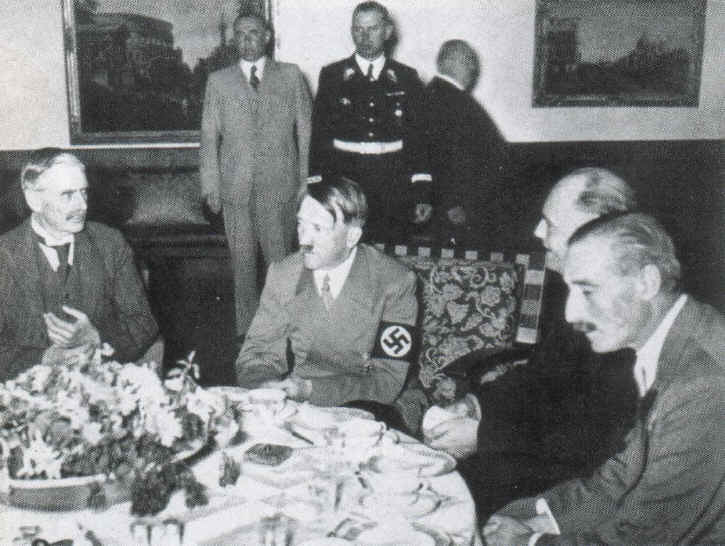 |
  September 29, 1938 - Four-Power Peace Conference, Führerbau, Munich, Bavaria (Germany). Nine hour meeting at the end of which Adolf Hitler, Neville Chamberlain, Edouard Daladier and Benito Mussolini signed the Munich Agreement which transferred the Sudetenland to Germany. Hitler promised not to make any further territorial demands in Europe. Click here for video. September 29, 1938 - Four-Power Peace Conference, Führerbau, Munich, Bavaria (Germany). Nine hour meeting at the end of which Adolf Hitler, Neville Chamberlain, Edouard Daladier and Benito Mussolini signed the Munich Agreement which transferred the Sudetenland to Germany. Hitler promised not to make any further territorial demands in Europe. Click here for video.   
|

|   September 29, 1938 -
Führerbau, Munich, Bavaria (Germany). "Hitler's office was in the room just above the balcony. The Nazi eagle and swastika can be seen at top center." Also where the Munich Peace Agreement was signed on September 29, 1938, by PM Neville Chamberlain, who proclaimed, "My good friends, for the second time in our history a British Prime Minister has returned from Germany bringing peace with honour. I believe it is peace for our time." Building is now a school, the Hochschule für Musik und Theater München. September 29, 1938 -
Führerbau, Munich, Bavaria (Germany). "Hitler's office was in the room just above the balcony. The Nazi eagle and swastika can be seen at top center." Also where the Munich Peace Agreement was signed on September 29, 1938, by PM Neville Chamberlain, who proclaimed, "My good friends, for the second time in our history a British Prime Minister has returned from Germany bringing peace with honour. I believe it is peace for our time." Building is now a school, the Hochschule für Musik und Theater München. 
|
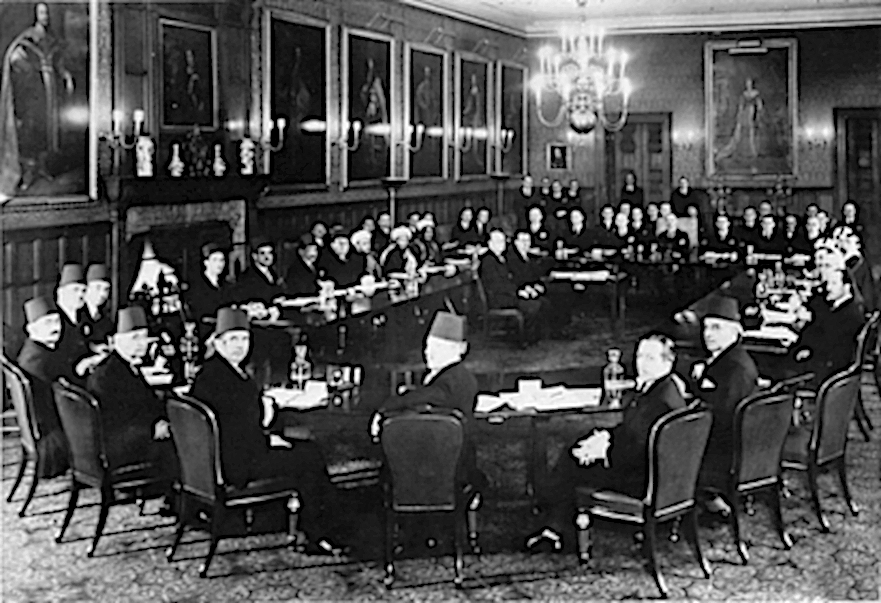
|   February 1939 - London Conference, St. James' Palace, London (England). February 1939. "To negotiate an agreement between Palestine Arabs & Zionists. The Arab delegation refused to meet its Jewish counterpart, to recognize their authority, or even to use the same entrances to the building, so the British government made separate proposals to the two parties, who both rejected them. The conference ended in failure on March 17, 1939." Photo shows "Palestinian delegates (foreground), Left to right: Fu'ad Saba, Yaqub Al-Ghussein, Musa Alami, Amin Tamimi, Jamal Al-Husseini, Awni Abdul Hadi, George Antonious, and Alfred Roch. Facing the Palestinians are the British, with Sir Neville Chamberlain presiding. To his right is Lord Halifax, and to his left, Malcolm MacDonald." February 1939 - London Conference, St. James' Palace, London (England). February 1939. "To negotiate an agreement between Palestine Arabs & Zionists. The Arab delegation refused to meet its Jewish counterpart, to recognize their authority, or even to use the same entrances to the building, so the British government made separate proposals to the two parties, who both rejected them. The conference ended in failure on March 17, 1939." Photo shows "Palestinian delegates (foreground), Left to right: Fu'ad Saba, Yaqub Al-Ghussein, Musa Alami, Amin Tamimi, Jamal Al-Husseini, Awni Abdul Hadi, George Antonious, and Alfred Roch. Facing the Palestinians are the British, with Sir Neville Chamberlain presiding. To his right is Lord Halifax, and to his left, Malcolm MacDonald."
|


|   1939-1940 -
Temple of Religion & Tower of Peace, Golden Gate International Exposition (California World's Fair), Treasure Island, San Francisco, California (USA). "Representation of various world religions certainly occurred at earlier expositions. What is notable about this exposition's presentation is the theme of religious unity. Along with more typical Christian groups, the Fair included representations of Buddhists, Bahai'is, Christian Scientists, Jews, Mormons, Protestants & others. This is particularly interesting in light of the impending World War that would embroil nations in a struggle that emphasized disunity & differences. Rabbi Rudolph I. Coffee states, 'Unitedly we embarked on this spiritual adventure, & in working together, we learned to know & love one another.'" 1939-1940 -
Temple of Religion & Tower of Peace, Golden Gate International Exposition (California World's Fair), Treasure Island, San Francisco, California (USA). "Representation of various world religions certainly occurred at earlier expositions. What is notable about this exposition's presentation is the theme of religious unity. Along with more typical Christian groups, the Fair included representations of Buddhists, Bahai'is, Christian Scientists, Jews, Mormons, Protestants & others. This is particularly interesting in light of the impending World War that would embroil nations in a struggle that emphasized disunity & differences. Rabbi Rudolph I. Coffee states, 'Unitedly we embarked on this spiritual adventure, & in working together, we learned to know & love one another.'"
|


|   1939-1940 - "The Peacemakers" mural, Court of Pacifica, Golden Gate International Exposition (California World's Fair), Treasure Island, San Francisco, California (USA). By the three Bruton Sisters (Helen, Esther & Margaret) [1894-1992], as seen behind mural portion in the lower image. The fair lasted two years (1939-1940). 1939-1940 - "The Peacemakers" mural, Court of Pacifica, Golden Gate International Exposition (California World's Fair), Treasure Island, San Francisco, California (USA). By the three Bruton Sisters (Helen, Esther & Margaret) [1894-1992], as seen behind mural portion in the lower image. The fair lasted two years (1939-1940).
|
 August 21-27, 1939 - 33rd Universal Peace Congress, Zurich (Switzerland). The last inter-war congress met at Zurich in August 1939, concluding their meeting four days before the Germans invaded Poland, marking the beginning of World War II. What happened to the Universal Peace Congresses after WW-II? August 21-27, 1939 - 33rd Universal Peace Congress, Zurich (Switzerland). The last inter-war congress met at Zurich in August 1939, concluding their meeting four days before the Germans invaded Poland, marking the beginning of World War II. What happened to the Universal Peace Congresses after WW-II?
September 1939-September 1945 - World War II.



  August 21-October 7, 1944 - Dumbarton Oaks Conference, Washington, DC (USA). Formally called "Washington Conversations on International Peace & Security Organization." "The 'Big Four' (China, UK, USA & USSR) met here with the main objective to create an organization that 'would maintain international peace and security, by peaceful means, if possible, and economic sanctions and force if necessary; and to promote security by encouraging economic and social cooperation among nations.'" Dumbarton Oaks (in Georgetown at 1703-32nd Street, NW) is a Federal-style house & estate built in 1801 and owned since 1940 by Harvard University. August 21-October 7, 1944 - Dumbarton Oaks Conference, Washington, DC (USA). Formally called "Washington Conversations on International Peace & Security Organization." "The 'Big Four' (China, UK, USA & USSR) met here with the main objective to create an organization that 'would maintain international peace and security, by peaceful means, if possible, and economic sanctions and force if necessary; and to promote security by encouraging economic and social cooperation among nations.'" Dumbarton Oaks (in Georgetown at 1703-32nd Street, NW) is a Federal-style house & estate built in 1801 and owned since 1940 by Harvard University. 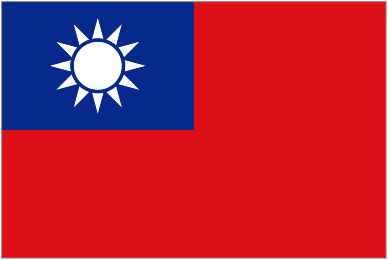   
|



  July 1944 - Bretton Woods Monetary Conference, Mount Washington Hotel, Bretton Woods, New Hampshire (USA). Marker commemorates the international conference in July 1944 during which the groundwork was laid for the International Monetary Fund (IMF), the International Bank for Reconstruction & Development (IBRD) -- now called the World Bank -- and other so-called "Bretton Woods" institutions. What is date of the marker? July 1944 - Bretton Woods Monetary Conference, Mount Washington Hotel, Bretton Woods, New Hampshire (USA). Marker commemorates the international conference in July 1944 during which the groundwork was laid for the International Monetary Fund (IMF), the International Bank for Reconstruction & Development (IBRD) -- now called the World Bank -- and other so-called "Bretton Woods" institutions. What is date of the marker?
| M
US
E
U
M |

  1997 - Cordell Hull Birthplace & Museum State Park, 1300 Cordell Hull Memorial Drive, Byrdstown, Tennessee (USA). Preserves Hull's birthplace and various personal effects Hull donated to the citizens of Pickett County, including his 1945 Nobel Peace Prize. Cordell Hull [1871-1955] was Secretary of State 1933-1944. President Roosevelt called him the "Father of the United Nations." 1997 - Cordell Hull Birthplace & Museum State Park, 1300 Cordell Hull Memorial Drive, Byrdstown, Tennessee (USA). Preserves Hull's birthplace and various personal effects Hull donated to the citizens of Pickett County, including his 1945 Nobel Peace Prize. Cordell Hull [1871-1955] was Secretary of State 1933-1944. President Roosevelt called him the "Father of the United Nations."  
|


 |   January 10-February 14, 1946 - First Meeting of the UN General Assembly, Methodist Central Hall, Westminster, London (England). Right image shows a Commemorative Plaque. Named in "A Peace Trail Through London" by Valerie Flessati (1998). January 10-February 14, 1946 - First Meeting of the UN General Assembly, Methodist Central Hall, Westminster, London (England). Right image shows a Commemorative Plaque. Named in "A Peace Trail Through London" by Valerie Flessati (1998). 
|
 |   1946-1951 - Temporary home of the UN Secretariat, Lake Success, Long Island, New York (USA). Designed by the Philadelphia-based architecture and design firm EwingCole. Transformed from industrial space used as a defense manufacturing plant dating back to WW-II when it was operated by Sperry Gyroscope Co. Used by UN after the UN charter was signed in San Francisco on June 26, 1945. Now part of North Shore-LIJ Health System’s Center for Advanced Medicine. 1946-1951 - Temporary home of the UN Secretariat, Lake Success, Long Island, New York (USA). Designed by the Philadelphia-based architecture and design firm EwingCole. Transformed from industrial space used as a defense manufacturing plant dating back to WW-II when it was operated by Sperry Gyroscope Co. Used by UN after the UN charter was signed in San Francisco on June 26, 1945. Now part of North Shore-LIJ Health System’s Center for Advanced Medicine. 
| "After World War-II, the
International Peace Bureau (IPB) - like practically all peace organisations - had to reorganise from scratch & find a useful role in the emerging Cold War. The IPB became a centre of study & debate for member organisations & concentrated on introducing new issues to the peace movement, governments & the United Nations. "
-- From Santi (1991).


|  September 1946 - Conference of European Federalists, Hertenstein on Lake Lucerne near Weggis (Switzerland). Marked by small plaque (now partially hidden by bushes) at the Hertenstein boat landing.
Translation of inscription: "EUROPA-UNION.
In September 1946, European Federalists
met for the first time here in Hertenstein, this quiet place
on the lake, as a place of reflection and in
the hope of a peaceful, federal,
cosmopolitan, social and
united Europe.
The idea of a Union of European Federalists (UEF) and the concept
a Swiss European Policy
(Hertenstein Programme 1975) emerged here.
May every visitor to Herteinstein dedicate himself to the idea of a united Europe.
30th Anniversary of the Conference, October 2, 1976." September 1946 - Conference of European Federalists, Hertenstein on Lake Lucerne near Weggis (Switzerland). Marked by small plaque (now partially hidden by bushes) at the Hertenstein boat landing.
Translation of inscription: "EUROPA-UNION.
In September 1946, European Federalists
met for the first time here in Hertenstein, this quiet place
on the lake, as a place of reflection and in
the hope of a peaceful, federal,
cosmopolitan, social and
united Europe.
The idea of a Union of European Federalists (UEF) and the concept
a Swiss European Policy
(Hertenstein Programme 1975) emerged here.
May every visitor to Herteinstein dedicate himself to the idea of a united Europe.
30th Anniversary of the Conference, October 2, 1976."
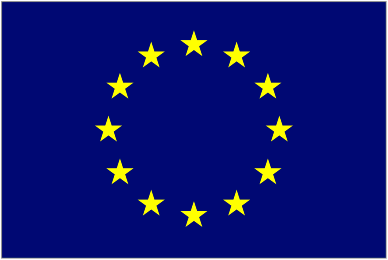
|
 |  October 1946 - Foreign Ministers' Peace Conference, Paris (France). Image shows French Prime Minister Georges Bidault [1899-1983] taking over chairman's chair to close out the peace conference. Conference is "UN-sponsored" or "un-sponsored"! October 1946 - Foreign Ministers' Peace Conference, Paris (France). Image shows French Prime Minister Georges Bidault [1899-1983] taking over chairman's chair to close out the peace conference. Conference is "UN-sponsored" or "un-sponsored"!
|


|  August 17-23, 1947 - First Conference of the World Movement for World Federal Government, Montreux (Switzerland). "More than 300 participants representing 51 organizations & numerous observers. Max Habicht [1899-1986] opened the meeting & declared that as Federalists they wanted a world government that 'will create the Parliament of Man, in which the representatives of the people of the world will make world laws by majority vote.' Mr. Habicht described the Covenant of the League of Nations and the Charter of San Francisco as 'only steps on the path leading to a better organization, the World Federal Government, which alone, can guarantee world peace. We fear that the United Nation's efforts towards peace, like those of the League of Nations, may not be successful, if the world is not willing to take this next step to World Federal Government.' He concluded, 'Federalists in all countries of the world will try to make a contribution to this political evolution. We are here in Montreux to coordinate our activities and to make them more effective.'
The Founding meeting concluded with the adoption of the 'Montreux Declaration; The Principles for World Federal Government' on August 23." August 17-23, 1947 - First Conference of the World Movement for World Federal Government, Montreux (Switzerland). "More than 300 participants representing 51 organizations & numerous observers. Max Habicht [1899-1986] opened the meeting & declared that as Federalists they wanted a world government that 'will create the Parliament of Man, in which the representatives of the people of the world will make world laws by majority vote.' Mr. Habicht described the Covenant of the League of Nations and the Charter of San Francisco as 'only steps on the path leading to a better organization, the World Federal Government, which alone, can guarantee world peace. We fear that the United Nation's efforts towards peace, like those of the League of Nations, may not be successful, if the world is not willing to take this next step to World Federal Government.' He concluded, 'Federalists in all countries of the world will try to make a contribution to this political evolution. We are here in Montreux to coordinate our activities and to make them more effective.'
The Founding meeting concluded with the adoption of the 'Montreux Declaration; The Principles for World Federal Government' on August 23."
|

 |  August 23, 1948 - WCC Founding Conference, Amsterdam (Netherlands). Delegates of 147 churches assemble to merge the Faith & Order Movement ("the discussing") and the Life & Work Movement ("the doing") into the World Council of Churches (WCC). Merged in 1961 with the International Missionary Council and in 1971 with the World Council of Christian Education (whose roots were in the 18th century Sunday School movement).
WCC member churches include most of the Orthodox Churches; numerous Protestant churches, including the Anglican Communion, some Baptists, many Lutheran, Methodist, and Reformed, a broad sampling of united and independent churches, and some Pentecostal churches; and some Old Catholic churches.
Delegates sent from the member churches meet every seven or eight years in an Assembly, which elects a Central Committee that governs between Assemblies. A variety of other committees and commissions answer to the Central Committee and its staff.
These Assemblies have been held since 1948, and last met in Porto Alegre (Brazil) in February 2006, under the theme "God, in your grace, transform the world." August 23, 1948 - WCC Founding Conference, Amsterdam (Netherlands). Delegates of 147 churches assemble to merge the Faith & Order Movement ("the discussing") and the Life & Work Movement ("the doing") into the World Council of Churches (WCC). Merged in 1961 with the International Missionary Council and in 1971 with the World Council of Christian Education (whose roots were in the 18th century Sunday School movement).
WCC member churches include most of the Orthodox Churches; numerous Protestant churches, including the Anglican Communion, some Baptists, many Lutheran, Methodist, and Reformed, a broad sampling of united and independent churches, and some Pentecostal churches; and some Old Catholic churches.
Delegates sent from the member churches meet every seven or eight years in an Assembly, which elects a Central Committee that governs between Assemblies. A variety of other committees and commissions answer to the Central Committee and its staff.
These Assemblies have been held since 1948, and last met in Porto Alegre (Brazil) in February 2006, under the theme "God, in your grace, transform the world."
|

 Date? - Ecumenical Centre, Geneva (Switzerland). Located near the ILO, ICRC & WHO. Serves as the base for the following Church organisations:
* Action by Churches Together
* Conference of European Churches
* Ecumenical Church Loan Fund
* Ecumenical News International
* Lutheran World Federation
* World Alliance of Reformed Churches
* World Student Christian Federation
* World Council of Churches Date? - Ecumenical Centre, Geneva (Switzerland). Located near the ILO, ICRC & WHO. Serves as the base for the following Church organisations:
* Action by Churches Together
* Conference of European Churches
* Ecumenical Church Loan Fund
* Ecumenical News International
* Lutheran World Federation
* World Alliance of Reformed Churches
* World Student Christian Federation
* World Council of Churches
|
 August 25-28, 1948 -
World Congress of Intellectuals for Peace, Wroclaw (Poland). Notable politicians, academics & artists attended, including Pablo Picasso, Frédéric Joliot-Curie, Irène Joliot-Curie, Bertolt Brecht, Paul Éluard, Aldous Huxley, Julian Huxley, Dominique Desanti, Ilya Ehrenburg, Martin Andersen-Nexo, Sir John Boyd-Orr, Olaf Stapledon [1886-1950], Alexander Fadeyev, Julien Benda, William Gropper, Eugénie Cotton, Jerzy Borejsza, Anna Seghers & Alves Redol. The Congress was marked by an anti-American & pro-communist tone.
Julia Pirotte [1908-2000], a photojournalist known for her work in the French Resistance, covered the event. Click here for more info. August 25-28, 1948 -
World Congress of Intellectuals for Peace, Wroclaw (Poland). Notable politicians, academics & artists attended, including Pablo Picasso, Frédéric Joliot-Curie, Irène Joliot-Curie, Bertolt Brecht, Paul Éluard, Aldous Huxley, Julian Huxley, Dominique Desanti, Ilya Ehrenburg, Martin Andersen-Nexo, Sir John Boyd-Orr, Olaf Stapledon [1886-1950], Alexander Fadeyev, Julien Benda, William Gropper, Eugénie Cotton, Jerzy Borejsza, Anna Seghers & Alves Redol. The Congress was marked by an anti-American & pro-communist tone.
Julia Pirotte [1908-2000], a photojournalist known for her work in the French Resistance, covered the event. Click here for more info.
|


 |   March 25-27, 1949 - Cultural & Scientific Conference for World Peace, Waldorf-Astoria Hotel, New York City, New York (USA). According to a CIA website, this was "one of the strangest gatherings in American history. 800 prominent literary and artistic figures congregated in the Waldorf to call for peace at any price with Stalin. [and] joined with European and Soviet delegates to repudiate 'US warmongering.' Russian composer Dmitri Shostakovich told the delegates that 'a small clique of hatemongers' was preparing a global conflagration; he urged progressive artists to struggle against the new 'Fascists' who were seeking world domination.
The Waldorf conference marked another step in the Communist Information Bureau's (Cominform) campaign to shape Western opinion. A series of Soviet-sponsored cultural conferences beginning in September 1948 called for world peace and denounced the policies of the Truman administration. The conference at the Waldorf-Astoria, however, was the first to convene in a Western country and, not coincidentally, was also the first to meet organized and articulate opposition."
Attendees included
Clifford Odets, Lillian Hellman, Aaron Copland, Arthur Miller, Norman Mailer, Benedetto Croce, T.S. Eliot, Karl Jaspers, Andre Malraux, Bertrand Russell and Igor Stravinsky. Lower image shows S.A. Gerasimov, Soviet writer and motion picture director; William Olaf Stapledon [1886-1950], philosopher & science fiction author (only Briton granted a US visa to attend); Dmitri Shostakovich, Soviet composer; Alex A. Fadayev, secretary General of the Secretariat of the union of Soviet writers, and French West African delegate Dr. R.E.G. Armattoe, director of the Lomeshie Research Center for the Anthropology and Race Biology in North Ireland. March 25-27, 1949 - Cultural & Scientific Conference for World Peace, Waldorf-Astoria Hotel, New York City, New York (USA). According to a CIA website, this was "one of the strangest gatherings in American history. 800 prominent literary and artistic figures congregated in the Waldorf to call for peace at any price with Stalin. [and] joined with European and Soviet delegates to repudiate 'US warmongering.' Russian composer Dmitri Shostakovich told the delegates that 'a small clique of hatemongers' was preparing a global conflagration; he urged progressive artists to struggle against the new 'Fascists' who were seeking world domination.
The Waldorf conference marked another step in the Communist Information Bureau's (Cominform) campaign to shape Western opinion. A series of Soviet-sponsored cultural conferences beginning in September 1948 called for world peace and denounced the policies of the Truman administration. The conference at the Waldorf-Astoria, however, was the first to convene in a Western country and, not coincidentally, was also the first to meet organized and articulate opposition."
Attendees included
Clifford Odets, Lillian Hellman, Aaron Copland, Arthur Miller, Norman Mailer, Benedetto Croce, T.S. Eliot, Karl Jaspers, Andre Malraux, Bertrand Russell and Igor Stravinsky. Lower image shows S.A. Gerasimov, Soviet writer and motion picture director; William Olaf Stapledon [1886-1950], philosopher & science fiction author (only Briton granted a US visa to attend); Dmitri Shostakovich, Soviet composer; Alex A. Fadayev, secretary General of the Secretariat of the union of Soviet writers, and French West African delegate Dr. R.E.G. Armattoe, director of the Lomeshie Research Center for the Anthropology and Race Biology in North Ireland. 
|  March 1950 - World Peace Council releases the Stockholm Peace Appeal, the petition "that began the international 'Ban the Bomb' movement.' March 1950 - World Peace Council releases the Stockholm Peace Appeal, the petition "that began the international 'Ban the Bomb' movement.'
![]() | C
O
N
F |  June 26, 1950 - Conference of intellectuals, West Berlin (Germany). A gathering that itself marked a landmark in the Cold War. By a lucky stroke, the conference opened just a day after North Korea invaded the South. This coincidence lent unexpected timeliness and urgency to the conference's message: that some of the best minds of the West--representing a wide range of disciplines and political viewpoints--were willing to defy the still-influential opinion that Communism was more congenial to culture than was bourgeois democracy. Historians have surmised that this event had some CIA connection, but the handful of CIA officers who knew the full story are dead, and scholars today tend to skirt this issue because of the lack of documentation. /// Agency files reveal the true origins of the Berlin conference. Besides setting the Congress in motion, [the Berlin conference in 1950] helped to solidify CIA's emerging strategy of promoting the non-Communist left--the strategy that would soon become the theoretical foundation of the Agency's political operations against Communism over the next two decades." June 26, 1950 - Conference of intellectuals, West Berlin (Germany). A gathering that itself marked a landmark in the Cold War. By a lucky stroke, the conference opened just a day after North Korea invaded the South. This coincidence lent unexpected timeliness and urgency to the conference's message: that some of the best minds of the West--representing a wide range of disciplines and political viewpoints--were willing to defy the still-influential opinion that Communism was more congenial to culture than was bourgeois democracy. Historians have surmised that this event had some CIA connection, but the handful of CIA officers who knew the full story are dead, and scholars today tend to skirt this issue because of the lack of documentation. /// Agency files reveal the true origins of the Berlin conference. Besides setting the Congress in motion, [the Berlin conference in 1950] helped to solidify CIA's emerging strategy of promoting the non-Communist left--the strategy that would soon become the theoretical foundation of the Agency's political operations against Communism over the next two decades."
|
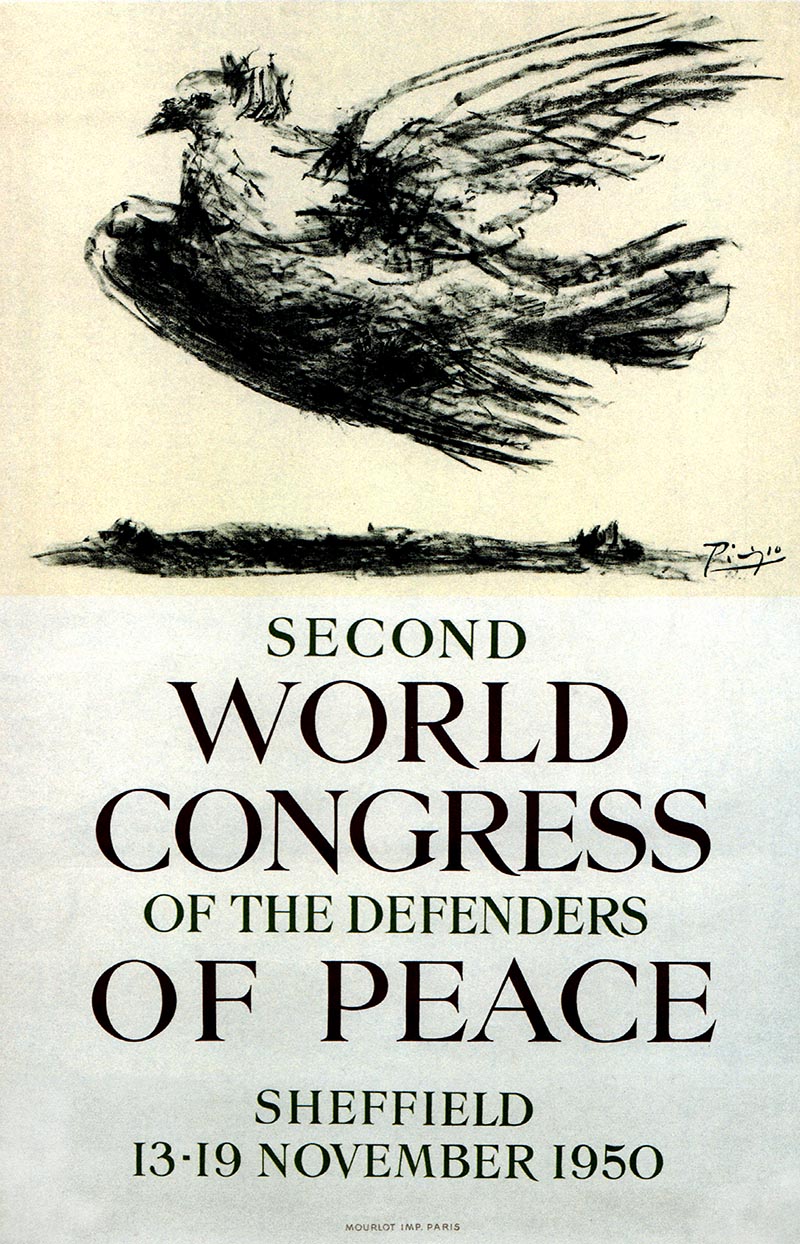

|
  November 13-19, 1950 - Second World Peace Conference, Sheffield (England). Poster by Pablo Picasso [1881-1973] says "Second World Conference of the Defenders of Peace." Picasso is the only international intellectual allowed into the UK by the Labour government for this conference, and he consequently refuses to attend.
"The World Peace Congress (WPC) emerged from a Communist-led peace congress held at Wroclaw (Poland) in 1948. A subsequent congress in Paris & Prague in 1949 set up a World Committee of Partisans for Peace, and a congress in Sheffield & Warsaw in 1950 reconstituted the Partisans as the World Peace Council (WPC)." November 13-19, 1950 - Second World Peace Conference, Sheffield (England). Poster by Pablo Picasso [1881-1973] says "Second World Conference of the Defenders of Peace." Picasso is the only international intellectual allowed into the UK by the Labour government for this conference, and he consequently refuses to attend.
"The World Peace Congress (WPC) emerged from a Communist-led peace congress held at Wroclaw (Poland) in 1948. A subsequent congress in Paris & Prague in 1949 set up a World Committee of Partisans for Peace, and a congress in Sheffield & Warsaw in 1950 reconstituted the Partisans as the World Peace Council (WPC)."
|


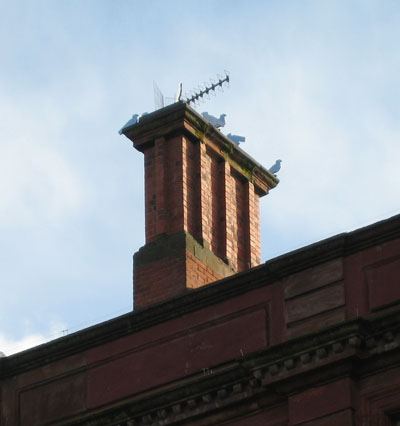
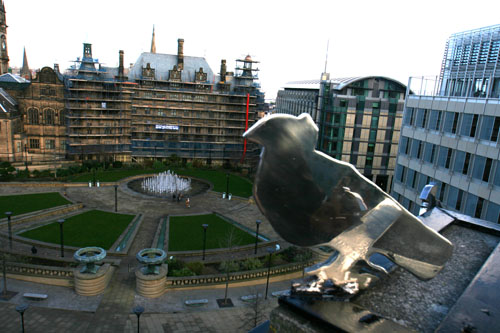
 | D O V E S
  February 1, 2012? -
Peace Doves, opposite Peace Gardens, St. Paul's Parade, Sheffield (England).
"Stainless steel sculpture by Sheffield artist Richard Bartle. Features seven life-size doves perched on chimney of Bar Ha!Ha! (now Browns Bar & Brasserie) next to the Peace Gardens. Inspired by Pablo Picasso’s visit to the Second World Peace Congress held in Sheffield in 1950. Pablo Picasso [1881-1973] arrived at Sheffield Midland railway station carrying a bouquet of chrysanthemums & wearing an old raincoat & blue beret. He was welcomed by members of the local communist party, the press & the public, and taken on a tour of the city. He ate a bacon sandwich at Thorpe's cafe in Fargate; had his hair trimmed at Peckitt's barbers, and drew a 'dove of peace' on a napkin in Butler’s Dining Rooms.
The Congress was to be a special debate on the Korean War, but the Government at the time refused to allow important speakers into the country, & it was abandoned. Picasso gave a short speech, recalling that he had learnt to paint doves from his father, and ending by saying 'I stand for life against death; I stand for peace against war.'
Later whilst returning to London he drew another Dove of Peace on a napkin, which he gave to the bodyguard who had accompanied him around the city. This drawing is now part of Sheffield Galleries & Museums Trust’s collection and is now on permanent display at Weston Park Museum.
Richard Bartle has used the original poster [from 1949], designed by Picasso, as a template to create the sculpture, in celebration of the memory of Picasso and the cause of peace that he introduced into an already radically thinking Sheffield..." February 1, 2012? -
Peace Doves, opposite Peace Gardens, St. Paul's Parade, Sheffield (England).
"Stainless steel sculpture by Sheffield artist Richard Bartle. Features seven life-size doves perched on chimney of Bar Ha!Ha! (now Browns Bar & Brasserie) next to the Peace Gardens. Inspired by Pablo Picasso’s visit to the Second World Peace Congress held in Sheffield in 1950. Pablo Picasso [1881-1973] arrived at Sheffield Midland railway station carrying a bouquet of chrysanthemums & wearing an old raincoat & blue beret. He was welcomed by members of the local communist party, the press & the public, and taken on a tour of the city. He ate a bacon sandwich at Thorpe's cafe in Fargate; had his hair trimmed at Peckitt's barbers, and drew a 'dove of peace' on a napkin in Butler’s Dining Rooms.
The Congress was to be a special debate on the Korean War, but the Government at the time refused to allow important speakers into the country, & it was abandoned. Picasso gave a short speech, recalling that he had learnt to paint doves from his father, and ending by saying 'I stand for life against death; I stand for peace against war.'
Later whilst returning to London he drew another Dove of Peace on a napkin, which he gave to the bodyguard who had accompanied him around the city. This drawing is now part of Sheffield Galleries & Museums Trust’s collection and is now on permanent display at Weston Park Museum.
Richard Bartle has used the original poster [from 1949], designed by Picasso, as a template to create the sculpture, in celebration of the memory of Picasso and the cause of peace that he introduced into an already radically thinking Sheffield..."
|

| 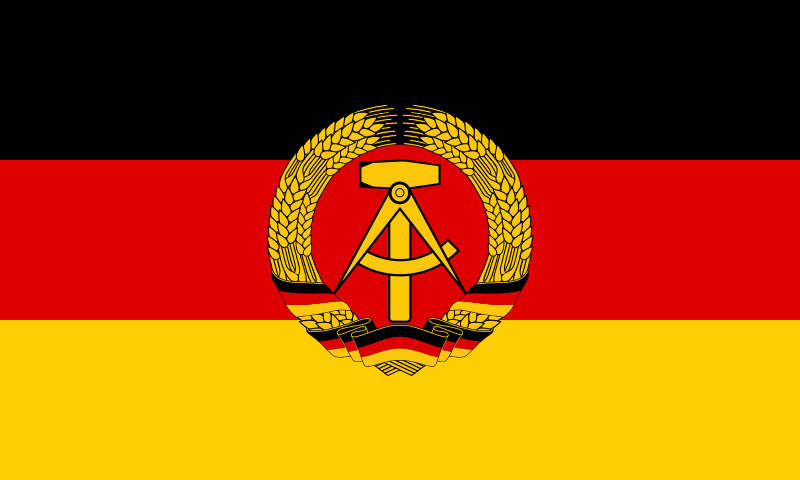 August 1951 - 3rd World Festival of Youth & Students for Peace (WFYS), East Berlin (East Germany). Attended by 26,000 participants from 104 countries. Its motto was: "For Peace and Friendship - Against Nuclear Weapons." /// Image shows scarf to commemorate the festival by Pablo Picasso [1881-1973]. "During the late 1940's and early 1950's, Picasso was actively involved in the communist-supported International Peace Movement and attended congresses in Poland, Italy & England. In 1950 he was awarded the Lenin Peace Prize, but his art was not generally approved by the Communist Party. Picasso avoided using overtly communist symbolism in his work and refused to work in the socialist realist style favoured by the party." August 1951 - 3rd World Festival of Youth & Students for Peace (WFYS), East Berlin (East Germany). Attended by 26,000 participants from 104 countries. Its motto was: "For Peace and Friendship - Against Nuclear Weapons." /// Image shows scarf to commemorate the festival by Pablo Picasso [1881-1973]. "During the late 1940's and early 1950's, Picasso was actively involved in the communist-supported International Peace Movement and attended congresses in Poland, Italy & England. In 1950 he was awarded the Lenin Peace Prize, but his art was not generally approved by the Communist Party. Picasso avoided using overtly communist symbolism in his work and refused to work in the socialist realist style favoured by the party." 
|

|  1952 - World Peace Congress , East Berlin (East Germany). Image shows Picasso's dove above the stage. 1952 - World Peace Congress , East Berlin (East Germany). Image shows Picasso's dove above the stage.
|
 |   1952 - United Nations Headquarters Buildings, East River, New York City, New York (USA). Two buildings (Secretariat & Conference Building). Cornerstone laid October 24, 1949. General Assembly first met here October 14, 1952, for its 7th regular annual session. Replaced UN's temporary home in the Sperry Gyroscope building in Lake Success, Long Island, New York (USA). 1952 - United Nations Headquarters Buildings, East River, New York City, New York (USA). Two buildings (Secretariat & Conference Building). Cornerstone laid October 24, 1949. General Assembly first met here October 14, 1952, for its 7th regular annual session. Replaced UN's temporary home in the Sperry Gyroscope building in Lake Success, Long Island, New York (USA).

| M
U
S
E
U
M | See Apsel, Joyce (2008), "Peace & human rights education: The UN as a [virtual] museum for peace," pp. 37-48, in Anzai, Ikuro, et al, ed. by (2008), 6th International Museums for Peace Conference, Kyoto (Japan). 
|
 | C
O
N
F |  1952 - First World Humanist Congress, Amsterdam (Netherlands). "The founding fathers of International Humanist & Ethical Union (IHEU) agreed a statement of the fundamental principles of modern Humanism. They called it 'The Amsterdam Declaration.' That declaration was a child of its time: set in the world of great power politics & the Cold War.
The 50th anniversary World Humanist Congress in 2002, again meeting in the Netherlands, unanimously passed a resolution updating that declaration: 'The Amsterdam Declaration 2002.' Following the Congress, this updated declaration was adopted unanimously by the IHEU General Assembly, and thus became the official defining statement of World Humanism." 1952 - First World Humanist Congress, Amsterdam (Netherlands). "The founding fathers of International Humanist & Ethical Union (IHEU) agreed a statement of the fundamental principles of modern Humanism. They called it 'The Amsterdam Declaration.' That declaration was a child of its time: set in the world of great power politics & the Cold War.
The 50th anniversary World Humanist Congress in 2002, again meeting in the Netherlands, unanimously passed a resolution updating that declaration: 'The Amsterdam Declaration 2002.' Following the Congress, this updated declaration was adopted unanimously by the IHEU General Assembly, and thus became the official defining statement of World Humanism."
|
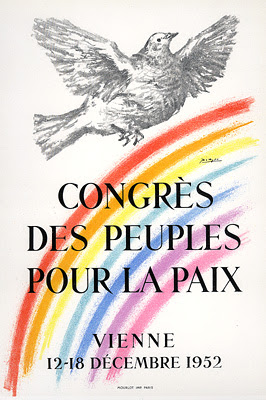
 | C
O
N
F |  December 12-18, 1952 - People's Congress for Peace, Vienna (Austria). Poster by Picasso. December 12-18, 1952 - People's Congress for Peace, Vienna (Austria). Poster by Picasso.
|
 April 21-May 14, 1954 - Intergovernmental Conference for the Protection of Cultural Property in the Event of Armed Conflict, The Hague (Netherlands). "Drew up & adopted the Hague Convention of 1954 & the further Acts. 56 States were represented... Following the signature of the Roerich Pact by the American states in 1935, attempts were undertaken to draft a more comprehensive convention for the protection of monuments & works of art in time of war. In 1939, a draft convention, elaborated under the auspices of the International Museums Office, was presented to governments by the Netherlands. On account of the outbreak of World War II, no further steps could be taken. After the war, a new proposal was submitted to UNESCO by the Netherlands in 1948. The General Conference of UNESCO in 1951 decided to convene a committee of government experts to draft a convention. This committee met in 1952 & thereafter submitted its drafts to the General Conference." /// As of 2013, the convention has been ratified by 126 states. The USA ratified in 2008 (54 years after its original adoption). April 21-May 14, 1954 - Intergovernmental Conference for the Protection of Cultural Property in the Event of Armed Conflict, The Hague (Netherlands). "Drew up & adopted the Hague Convention of 1954 & the further Acts. 56 States were represented... Following the signature of the Roerich Pact by the American states in 1935, attempts were undertaken to draft a more comprehensive convention for the protection of monuments & works of art in time of war. In 1939, a draft convention, elaborated under the auspices of the International Museums Office, was presented to governments by the Netherlands. On account of the outbreak of World War II, no further steps could be taken. After the war, a new proposal was submitted to UNESCO by the Netherlands in 1948. The General Conference of UNESCO in 1951 decided to convene a committee of government experts to draft a convention. This committee met in 1952 & thereafter submitted its drafts to the General Conference." /// As of 2013, the convention has been ratified by 126 states. The USA ratified in 2008 (54 years after its original adoption).
| 
|  April 26-July 21, 1954 - Geneva Conference, Geneva (Switzerland). "A conference with two tasks. The first was to try to find a way to unify Korea. The second task was to discuss the possibility of restoring peace in Indochina." April 26-July 21, 1954 - Geneva Conference, Geneva (Switzerland). "A conference with two tasks. The first was to try to find a way to unify Korea. The second task was to discuss the possibility of restoring peace in Indochina."


 | S
U
MM
M
I
T | 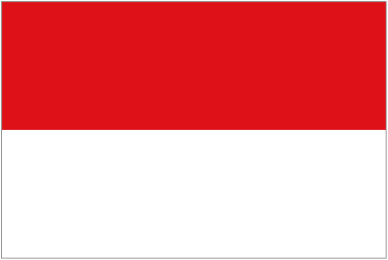 April 18-24, 1955 - Bandung Conference, Gedung Merdeka (Independence Building), Bandung (Indonesia). First large-scale Asian–African or Afro–Asian Conference. Attended by 29 states, most of which were newly independent, representing nearly 1/4 of the Earth's land surface & a total population of 1.5 billion. Organized by Indonesia, Burma, Pakistan, Ceylon (Sri Lanka) & India. Coordinated by Ruslan Abdulgani [1914-2005], secretary general of the Indonesian Ministry of Foreign Affairs. Stated aims were to promote Afro-Asian economic & cultural cooperation & to oppose colonialism or neocolonialism by either the USA or USSR in the Cold War or any other imperialistic nations. Was an important step toward the crystallization of the Non-Aligned Movement, & led to the "North-South Dialogue". /// To mark its 50th anniversary, Heads of State & Government attended a new Asian-African Summit from 20–24 April 2005 in Bandung & Jakarta. Some sessions of the new conference took place in the venue of the original conference. /// See Summit in Cancun (Mexico), October 1981. April 18-24, 1955 - Bandung Conference, Gedung Merdeka (Independence Building), Bandung (Indonesia). First large-scale Asian–African or Afro–Asian Conference. Attended by 29 states, most of which were newly independent, representing nearly 1/4 of the Earth's land surface & a total population of 1.5 billion. Organized by Indonesia, Burma, Pakistan, Ceylon (Sri Lanka) & India. Coordinated by Ruslan Abdulgani [1914-2005], secretary general of the Indonesian Ministry of Foreign Affairs. Stated aims were to promote Afro-Asian economic & cultural cooperation & to oppose colonialism or neocolonialism by either the USA or USSR in the Cold War or any other imperialistic nations. Was an important step toward the crystallization of the Non-Aligned Movement, & led to the "North-South Dialogue". /// To mark its 50th anniversary, Heads of State & Government attended a new Asian-African Summit from 20–24 April 2005 in Bandung & Jakarta. Some sessions of the new conference took place in the venue of the original conference. /// See Summit in Cancun (Mexico), October 1981.
|  July 18, 1955 - Geneva Summit, Geneva (Switzerland). "July 18th, 1955 in Geneva, Switzerland. "A meeting of 'The Big Four:' President Dwight D. Eisenhower of the United States, Prime Minister Anthony Eden of Britain, Premier Nikolai A. Bulganin of the Soviet Union, and Prime Minister Edgar Faure of France."
July 18, 1955 - Geneva Summit, Geneva (Switzerland). "July 18th, 1955 in Geneva, Switzerland. "A meeting of 'The Big Four:' President Dwight D. Eisenhower of the United States, Prime Minister Anthony Eden of Britain, Premier Nikolai A. Bulganin of the Soviet Union, and Prime Minister Edgar Faure of France."
 

|  August 1955 - First International Conference on the Peaceful Uses of Atomic Energy, Geneva (Switzerland). Often called the Atoms for Peace conference. Left image shows Atoms For Peace symbol used by the US Atomic Energy Commission (AEC). It was was mounted over the door to the American swimming pool reactor building during the 1955 conference. Around a representation of an atom are symbolised four areas civil atomic energy: scientific research, medicine, industry & agriculture. Two olive branches symbolise peaceful use. Right image shows physicist Tom Cole who conceived the reactor and then helped construct it at Oak Ridge National Laboratory (ORNL). Additional conferences were held in 1958, 1964 & 1971. August 1955 - First International Conference on the Peaceful Uses of Atomic Energy, Geneva (Switzerland). Often called the Atoms for Peace conference. Left image shows Atoms For Peace symbol used by the US Atomic Energy Commission (AEC). It was was mounted over the door to the American swimming pool reactor building during the 1955 conference. Around a representation of an atom are symbolised four areas civil atomic energy: scientific research, medicine, industry & agriculture. Two olive branches symbolise peaceful use. Right image shows physicist Tom Cole who conceived the reactor and then helped construct it at Oak Ridge National Laboratory (ORNL). Additional conferences were held in 1958, 1964 & 1971. 
|

| C
O
N
F |  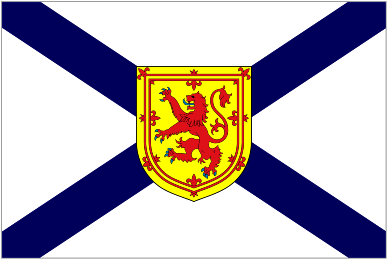 July 1957 - First Pugwash Conference on Science & World Affairs, Pugwash, Nova Scotia (Canada). Organized by Cyrus S. Eaton, Joseph Rotblat and Bertrand Russell. Followed the release of the Russell-Einstein Manifesto on July 9, 1955. (Pugwash and Rotblat jointly won the Nobel Peace Prize in 1995 for efforts on nuclear disarmament.) The Conferences are now an international organization that brings together scholars & public figures to work toward reducing the danger of armed conflict and to seek solutions to global security threats. In image, Rotblat is 7th from the right. July 1957 - First Pugwash Conference on Science & World Affairs, Pugwash, Nova Scotia (Canada). Organized by Cyrus S. Eaton, Joseph Rotblat and Bertrand Russell. Followed the release of the Russell-Einstein Manifesto on July 9, 1955. (Pugwash and Rotblat jointly won the Nobel Peace Prize in 1995 for efforts on nuclear disarmament.) The Conferences are now an international organization that brings together scholars & public figures to work toward reducing the danger of armed conflict and to seek solutions to global security threats. In image, Rotblat is 7th from the right.
|

| N
G
O |     Since 1957 - The Pugwash Conferences on Science & World Affairs. An international organization that brings together scholars & public figures to work toward reducing the danger of armed conflict & to seek solutions to global security threats. Founded after the first conference. "Joseph Rotblat was secretary-general of Pugwash 1957-1973, chairman of British Pugwash 1978-1988 & president of Pugwash worldwide 1988-1997. Its annals, many edited by Rotblat with various collaborators, have provided continuing & wide-ranging analyses into current problems of disarmament and world security." Dorothy Hodgkin [1910-1994] was president 1976-1988. Pugwash & Rotblat jointly won the Nobel Peace Prize in 1995 for efforts on nuclear disarmament. By late 2002, there have been over 275 Pugwash Conferences, Symposia, and Workshops, with a total attendance of over 10,000. There are now in the world over 3500 "Pugwashites," namely individuals who have attended a Pugwash meeting & are hence considered associated with Pugwash & receive the Pugwash newsletter. The Conference has offices in London, Washington, Rome & Geneva. Image shows the 58th Pugwash Conference in The Hague (Netherlands). Since 1957 - The Pugwash Conferences on Science & World Affairs. An international organization that brings together scholars & public figures to work toward reducing the danger of armed conflict & to seek solutions to global security threats. Founded after the first conference. "Joseph Rotblat was secretary-general of Pugwash 1957-1973, chairman of British Pugwash 1978-1988 & president of Pugwash worldwide 1988-1997. Its annals, many edited by Rotblat with various collaborators, have provided continuing & wide-ranging analyses into current problems of disarmament and world security." Dorothy Hodgkin [1910-1994] was president 1976-1988. Pugwash & Rotblat jointly won the Nobel Peace Prize in 1995 for efforts on nuclear disarmament. By late 2002, there have been over 275 Pugwash Conferences, Symposia, and Workshops, with a total attendance of over 10,000. There are now in the world over 3500 "Pugwashites," namely individuals who have attended a Pugwash meeting & are hence considered associated with Pugwash & receive the Pugwash newsletter. The Conference has offices in London, Washington, Rome & Geneva. Image shows the 58th Pugwash Conference in The Hague (Netherlands).
|  1958 - Geneva Conference, Geneva (Switzerland). No Wikipedia article on this conference. 1958 - Geneva Conference, Geneva (Switzerland). No Wikipedia article on this conference.


 | C
O
NF |  May 1960 - Conférence au Sommet / Summit Conference, Mouvement de la Paix (MVP), Paris (France). Image shows poster by Pablo Picasso [1881-1973] imprinted "Paix Désarmement pour le Succès de la Conférence au Sommet / Peace Disarmament for the Success of the Summit Conference." One of at least 80 peace posters produced by Picasso for the MVP during the Cold War. May 1960 - Conférence au Sommet / Summit Conference, Mouvement de la Paix (MVP), Paris (France). Image shows poster by Pablo Picasso [1881-1973] imprinted "Paix Désarmement pour le Succès de la Conférence au Sommet / Peace Disarmament for the Success of the Summit Conference." One of at least 80 peace posters produced by Picasso for the MVP during the Cold War.
|

|  August 5, 1960 - Statue of "Mother & Child in the Storm", in front of Hiroshima Peace Memorial Museum, Hiroshima (Japan). Presented by "Japan Council Against Atomic & Hydrogen Bombs" during "Fifth World Conference" [sic]. Erected with help of donations collected by "Hiroshima Municipal Federation of Women's Associations."
The statue depicts a mother holding an infant tightly in one arm and protecting another with the determination to survive whatever suffering may confront her.#31 of 56 "cenotaphs & monuments" on the Virtual E-Tour. Was the sculptor of this statue influenced by the work of Kathe Kollwitz? August 5, 1960 - Statue of "Mother & Child in the Storm", in front of Hiroshima Peace Memorial Museum, Hiroshima (Japan). Presented by "Japan Council Against Atomic & Hydrogen Bombs" during "Fifth World Conference" [sic]. Erected with help of donations collected by "Hiroshima Municipal Federation of Women's Associations."
The statue depicts a mother holding an infant tightly in one arm and protecting another with the determination to survive whatever suffering may confront her.#31 of 56 "cenotaphs & monuments" on the Virtual E-Tour. Was the sculptor of this statue influenced by the work of Kathe Kollwitz?
|  1961 - First WILPF conference of Soviet & American women to help break down cold war barriers.
Where held? Click this web page for references to other conferences of the Women's International League
for Peace & Freedom (WILPF). 1961 - First WILPF conference of Soviet & American women to help break down cold war barriers.
Where held? Click this web page for references to other conferences of the Women's International League
for Peace & Freedom (WILPF).

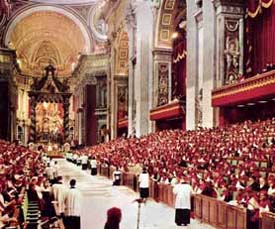 | C
O
N
F
S | 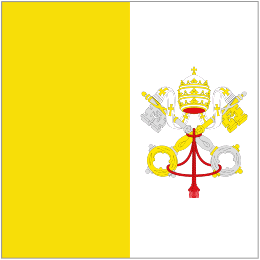 1962-1965 -
Second Ecumenical Council of the Vatican (Vatican II). The 21st Ecumenical Council of the Catholic Church. It opened under Pope John XXIII on 11 October 1962 and closed under Pope Paul VI on 8 December 1965. Pacem in Terris (Peace on Earth) was a papal encyclical issued by Pope John XXIII on 11 April 1963. It remains one of the most famous of 20th century encyclicals and established principles that featured in some of the documents of the Second Vatican Council and of later popes. 1962-1965 -
Second Ecumenical Council of the Vatican (Vatican II). The 21st Ecumenical Council of the Catholic Church. It opened under Pope John XXIII on 11 October 1962 and closed under Pope Paul VI on 8 December 1965. Pacem in Terris (Peace on Earth) was a papal encyclical issued by Pope John XXIII on 11 April 1963. It remains one of the most famous of 20th century encyclicals and established principles that featured in some of the documents of the Second Vatican Council and of later popes.
|
 |  October 16-21, 1970 - First World Conference, World Conference of Religions for Peace (WCRP), Kyoto (Japan). October 16-21, 1970 - First World Conference, World Conference of Religions for Peace (WCRP), Kyoto (Japan). |
 Late 1973 - Geneva Conference, Geneva (Switzerland). "An attempt to negotiate a solution to the Arab-Israeli conflict as envisioned in UN Security Council Resolution 338 following the called-for cease-fire to end the Yom Kippur War [October 6-25, 1973]." Late 1973 - Geneva Conference, Geneva (Switzerland). "An attempt to negotiate a solution to the Arab-Israeli conflict as envisioned in UN Security Council Resolution 338 following the called-for cease-fire to end the Yom Kippur War [October 6-25, 1973]."
 1974 - Second World Conference, World Conference of Religions for Peace (WCRP), Leuven (Belgium). 1974 - Second World Conference, World Conference of Religions for Peace (WCRP), Leuven (Belgium).
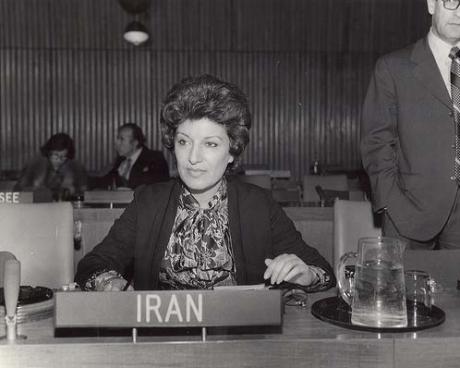 | C
O
N
F
|  June 19-July 2, 1975 - "1st World Conference on Women," Mexico City (Mexico). During International Women's Year. The first global meeting to be devoted exclusively to women's issues. June 19-July 2, 1975 - "1st World Conference on Women," Mexico City (Mexico). During International Women's Year. The first global meeting to be devoted exclusively to women's issues.
|  1978 - First Special Session on Disarmament of the UN General Assembly. "Established the Conference on Disarmament (CD) as the single multilateral disarmament negotiating forum of the international community. The CD succeeded other Geneva-based negotiating fora, including the Ten-Nation Committee on Disarmament (1960), the Eighteen-Nation Committee on Disarmament (1962-68), and the Conference of the Committee on Disarmament (1969-78).
The current Director-General of the UN Office in Geneva (UNOG) is the Secretary-General of the CD as well as the Personal Representative of the UN Secretary-General to the CD." 1978 - First Special Session on Disarmament of the UN General Assembly. "Established the Conference on Disarmament (CD) as the single multilateral disarmament negotiating forum of the international community. The CD succeeded other Geneva-based negotiating fora, including the Ten-Nation Committee on Disarmament (1960), the Eighteen-Nation Committee on Disarmament (1962-68), and the Conference of the Committee on Disarmament (1969-78).
The current Director-General of the UN Office in Geneva (UNOG) is the Secretary-General of the CD as well as the Personal Representative of the UN Secretary-General to the CD."



| C
O
NF |  September 1978 - International Conference on Primary Health Care, Lenin Convention Center, Alma-Ata, Kazakh (USSR). Three-day event in 3,000 seat convention center attended by 134 Member States of the World Health Organization (WHO), 67 international organizations, and dozens of NGO's. "Developed strategy and approach to achieve the goal of ‘health for all’ the people." Host city now called Almaty (Russia). September 1978 - International Conference on Primary Health Care, Lenin Convention Center, Alma-Ata, Kazakh (USSR). Three-day event in 3,000 seat convention center attended by 134 Member States of the World Health Organization (WHO), 67 international organizations, and dozens of NGO's. "Developed strategy and approach to achieve the goal of ‘health for all’ the people." Host city now called Almaty (Russia).


|
 1979? - 3rd World Conference, World Conference of Religions for Peace (WCRP), Princeton, New Jersey (USA). 1979? - 3rd World Conference, World Conference of Religions for Peace (WCRP), Princeton, New Jersey (USA).
 | C
O
N
F
|  July 14-30, 1980 - "2nd World Conference on Women," Bella Center, Copenhagen (Denmark). The World Conference of the UN Decade for Women (1976-1985) is the second global meeting to be devoted exclusively to women's issues. July 14-30, 1980 - "2nd World Conference on Women," Bella Center, Copenhagen (Denmark). The World Conference of the UN Decade for Women (1976-1985) is the second global meeting to be devoted exclusively to women's issues.
|

| S
U
MM
M
I
T |  October 21-24, 1981 - Summit on International Cooperation & Development, Sharaton Hotel, Cancun, Yucatan (Mexico). Image shows From left, rear:
Sergei Kraigher (Yugoslavia); Julius Nyerere (Tanzania); Margaret Thatcher (UK); Zenko Suzuki (Japan); Forbes Burnham (Guyana); Francois Mitterrand (France); Indira Gandhi (India); Alahaji Sheu Usman Aliyu Shagari (Nigeria); Thorbjörn Fälldin (Sweden); Luis Herrera Campins (Venezuela); Kurt Waldheim (UN Sec Gen). Bottom, from left:
Ronald Reagan (USA); Simeon Aket; Adbus Sattar; Chadli Bendje-did; Hans-Dietrich Genscher (Germany); Pierre Trudeau (Canada); Jose Lopez Portillo (Mexico); Prince Fahd (Saudi Arabia); Willibald Pahr; Ramiro Elisio Guerreiro; Zhao Zi-yang (China); Ferdinand Marcos (Philippines).
on the hotel beach -- most heads of state ever assembled. Attended by 22 countries from 5 continents.
"The only north-south summit conference in history." Soviet Union chose not to attend, & Cuba was excluded at the request of the USA. /// The Summit was the culmination of "Third World" efforts (begun at the Bandung Conference in 1955) to persuade "First & Second World" governments to make significant trade & development assistance commitments to Third World nations, but the summit had no lasting results. October 21-24, 1981 - Summit on International Cooperation & Development, Sharaton Hotel, Cancun, Yucatan (Mexico). Image shows From left, rear:
Sergei Kraigher (Yugoslavia); Julius Nyerere (Tanzania); Margaret Thatcher (UK); Zenko Suzuki (Japan); Forbes Burnham (Guyana); Francois Mitterrand (France); Indira Gandhi (India); Alahaji Sheu Usman Aliyu Shagari (Nigeria); Thorbjörn Fälldin (Sweden); Luis Herrera Campins (Venezuela); Kurt Waldheim (UN Sec Gen). Bottom, from left:
Ronald Reagan (USA); Simeon Aket; Adbus Sattar; Chadli Bendje-did; Hans-Dietrich Genscher (Germany); Pierre Trudeau (Canada); Jose Lopez Portillo (Mexico); Prince Fahd (Saudi Arabia); Willibald Pahr; Ramiro Elisio Guerreiro; Zhao Zi-yang (China); Ferdinand Marcos (Philippines).
on the hotel beach -- most heads of state ever assembled. Attended by 22 countries from 5 continents.
"The only north-south summit conference in history." Soviet Union chose not to attend, & Cuba was excluded at the request of the USA. /// The Summit was the culmination of "Third World" efforts (begun at the Bandung Conference in 1955) to persuade "First & Second World" governments to make significant trade & development assistance commitments to Third World nations, but the summit had no lasting results.

|
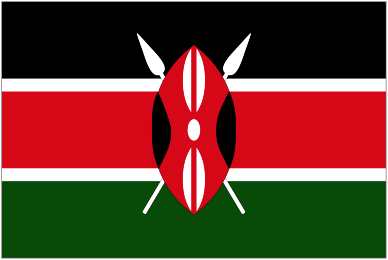 1984 - Fourth World Conference, World Conference of Religions for Peace (WCRP), Nairobi (Kenya). 1984 - Fourth World Conference, World Conference of Religions for Peace (WCRP), Nairobi (Kenya).
 | C
O
N
F
|  July 15-26, 1985 - "3rd World Conference on Women," Nairobi (Kenya). "Represented the culmination of ten years of work on gender empowerment. Attended by approximately 1,400 official delegates from 157 countries & 15,000 NGO representatives, the conference aimed to evaluate the progress made during UN Decade for Women & devise a new course of action for the advancement of women. While substantial progress had been made in the last ten years, it was clear that there was still a great deal to be done." July 15-26, 1985 - "3rd World Conference on Women," Nairobi (Kenya). "Represented the culmination of ten years of work on gender empowerment. Attended by approximately 1,400 official delegates from 157 countries & 15,000 NGO representatives, the conference aimed to evaluate the progress made during UN Decade for Women & devise a new course of action for the advancement of women. While substantial progress had been made in the last ten years, it was clear that there was still a great deal to be done."
|
 

|  October 17, 1987 - Commemorative Stone, Place des Droits de l'Homme, Palais de Challot, Trocadero, Paris (France).
"In response to the call of Joseph Wresinski [1917-1988] - founder of the International Movement ATD Fourth World - 100,000 defenders of human rights gathered in Paris to honour the victims of hunger, violence & ignorance, to express their refusal of extreme poverty & to call on people from all walks of life to unite to ensure respect for human rights. A commemorative stone proclaiming this message was inaugurated on this occasion on the Plaza of Human Rights and Liberties - where the Universal Declaration of Human Rights was signed in 1948.
Since then, on the 17th of October each year, people from all walks of life, gather throughout the world to express their solidarity & commitment to ensure that everyone's dignity & freedom are respected. On 22nd of December 1992, the General Assembly of the United Nations declared 17th October the International Day for the Eradication of Poverty. There are now over 30 replicas of the original stone now located around the world [where?!]. These sites have become places of honour for people living in poverty in the world, places where people gather to reject the inevitability of poverty & social exclusion & places of friendship & solidarity where people from all backgrounds can gather together. October 17, 1987 - Commemorative Stone, Place des Droits de l'Homme, Palais de Challot, Trocadero, Paris (France).
"In response to the call of Joseph Wresinski [1917-1988] - founder of the International Movement ATD Fourth World - 100,000 defenders of human rights gathered in Paris to honour the victims of hunger, violence & ignorance, to express their refusal of extreme poverty & to call on people from all walks of life to unite to ensure respect for human rights. A commemorative stone proclaiming this message was inaugurated on this occasion on the Plaza of Human Rights and Liberties - where the Universal Declaration of Human Rights was signed in 1948.
Since then, on the 17th of October each year, people from all walks of life, gather throughout the world to express their solidarity & commitment to ensure that everyone's dignity & freedom are respected. On 22nd of December 1992, the General Assembly of the United Nations declared 17th October the International Day for the Eradication of Poverty. There are now over 30 replicas of the original stone now located around the world [where?!]. These sites have become places of honour for people living in poverty in the world, places where people gather to reject the inevitability of poverty & social exclusion & places of friendship & solidarity where people from all backgrounds can gather together. 
|
 | C
O
N
F
S |   August 1988 - 1st International Women’s Peace Conference, Southern Methodist University, Dallas, Texas (USA). Sponsored by Peacemakers Incorporated. Over 2,000 delegates from 57 countries attended the conference. August 1988 - 1st International Women’s Peace Conference, Southern Methodist University, Dallas, Texas (USA). Sponsored by Peacemakers Incorporated. Over 2,000 delegates from 57 countries attended the conference.
|   September 1999 - 2nd International Women’s Peace Conference, Cathedral Santuario de Guadalupe, Dallas, Texas (USA). Sponsored by Peacemakers Incorporated. Theme: "Healing as a Prelude to Peace." September 1999 - 2nd International Women’s Peace Conference, Cathedral Santuario de Guadalupe, Dallas, Texas (USA). Sponsored by Peacemakers Incorporated. Theme: "Healing as a Prelude to Peace."
|   July 2007 - 3rd International Women’s Peace Conference, Dallas, Texas (USA). Sponsored by Peacemakers Incorporated. Almost 1400 delegates from 45 countries and 37 states gathered in Dallas, Texas, for a week of education & discussion in support of peace for our world. July 2007 - 3rd International Women’s Peace Conference, Dallas, Texas (USA). Sponsored by Peacemakers Incorporated. Almost 1400 delegates from 45 countries and 37 states gathered in Dallas, Texas, for a week of education & discussion in support of peace for our world.
|  1989 - Fifth World Conference, World Conference of Religions for Peace (WCRP), Melbourne, Victoria (Australia). 1989 - Fifth World Conference, World Conference of Religions for Peace (WCRP), Melbourne, Victoria (Australia).

 | C
O
N
F
|   September 1992 - 1st International Conference of Peace Museums, in Bradford (England). Convened by the British Quaker charity "Give Peace a Chance" in association with the Department of Peace Studies, University of Bradford. Over 30 peace museums from 10 countries (including Australia, Japan & USA) exchanged experiences and made a start on future cooperation. The International Network of Peace Museums (INPM) was launched during or soon after this conference. In late 1998 The Peace Museum (qv) opened in Bradford. September 1992 - 1st International Conference of Peace Museums, in Bradford (England). Convened by the British Quaker charity "Give Peace a Chance" in association with the Department of Peace Studies, University of Bradford. Over 30 peace museums from 10 countries (including Australia, Japan & USA) exchanged experiences and made a start on future cooperation. The International Network of Peace Museums (INPM) was launched during or soon after this conference. In late 1998 The Peace Museum (qv) opened in Bradford.
|  1994 - Sixth World Conference, World Conference of Religions for Peace (WCRP), Riva del Garda (Italy). 1994 - Sixth World Conference, World Conference of Religions for Peace (WCRP), Riva del Garda (Italy).
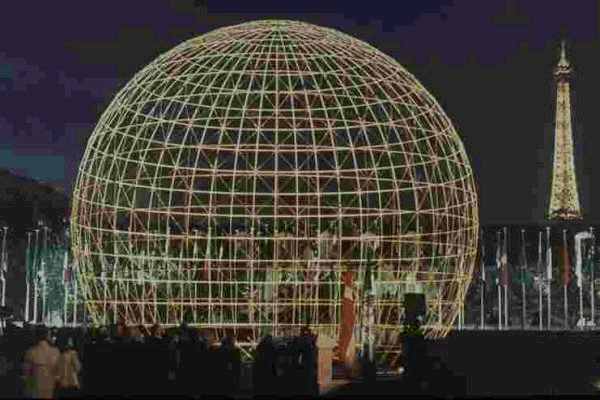

 |
 March 6-12, 1995 -
UN Summit on Social Development, Copenhagen (Denmark). Images show "Symbolic Globe" on piazza of UNESCO in Paris (France) surrounded by the flags of all nations, pointing out that this is the headquarters of the international organization. During the Summit, the globe was built in the centre of Copenhagen by the delegates, who had come from every corner of the earth. It is inspired by the logo of the UN and formed as a minimal structure, 15 meters in diameter. Conceived by Erik Reitzel [1941-2012]. The Danish Ministry of Culture financed its realization." The globe was moved to Paris in September 1995. March 6-12, 1995 -
UN Summit on Social Development, Copenhagen (Denmark). Images show "Symbolic Globe" on piazza of UNESCO in Paris (France) surrounded by the flags of all nations, pointing out that this is the headquarters of the international organization. During the Summit, the globe was built in the centre of Copenhagen by the delegates, who had come from every corner of the earth. It is inspired by the logo of the UN and formed as a minimal structure, 15 meters in diameter. Conceived by Erik Reitzel [1941-2012]. The Danish Ministry of Culture financed its realization." The globe was moved to Paris in September 1995.  
|
 | C
O
N
F
| 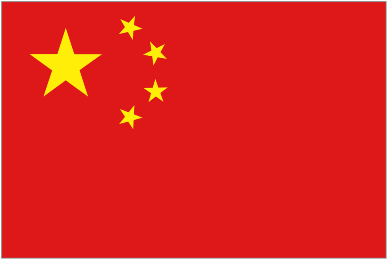 September 4-15, 1995 - "4th World Conference on Women: Action for Equality, Development & Peace," Beijing (China). "Convened by the UN, 189 governments & more than 5,000 representatives from 2,100 non-governmental organizations (NGO's) participated in the Conference. Delegates had prepared a Declaration and Platform for Action that aimed at achieving greater equality and opportunity for women. The three previous World Conferences were in Mexico City (International Women's Year, 1975), Copenhagen (1980) and Nairobi (1985)." September 4-15, 1995 - "4th World Conference on Women: Action for Equality, Development & Peace," Beijing (China). "Convened by the UN, 189 governments & more than 5,000 representatives from 2,100 non-governmental organizations (NGO's) participated in the Conference. Delegates had prepared a Declaration and Platform for Action that aimed at achieving greater equality and opportunity for women. The three previous World Conferences were in Mexico City (International Women's Year, 1975), Copenhagen (1980) and Nairobi (1985)."
|
 
| 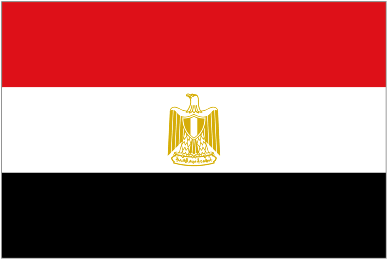 >1996 - Peacemakers Memorial, Sharm El Sheikh (Egypt). "The participants in the 'Summit of Peacemakers' [on March 13, 1996] pledged unity to stop a bloody wave of terrorism that has washed over the Middle East in recent weeks.
U.S. President Bill Clinton, co-hosting the one-day summit with Egyptian President Hosni Mubarek, outlined a plan agreed to by the 29 world leaders who attended. According to Clinton, a 'working group' of world leaders will report in 30 days on the plan's goals: enhancing the peace process, promoting security, and ending the terrorist attacks.
The conference at Sharm el-Sheikh, a resort town along the Red Sea, was boycotted by Syria and Lebanon, who complained that too much emphasis was being put on Israel's interests at Arab expense. At the post-summit press conference, Mubarak and Clinton both said they believe Syrian leader Hafez Assad is committed to the peace process." /// Lower image shows (from left to right) in front: Irish Prime Minister John Bruton, Canadian PM Jean Chretien, Turkish President Suleyman Demirel, Jordan's King Hussein, Israeli Prime Minister Shimon Peres, US President Bill Clinton, Egyptian President Hosni Mubarak, Russian President Boris Yeltsin, PLO Leader Yasser Arafat, King Hassan II of Morocco. At rear behind King Hussein, British PM John Major left, Italian PM Lamberto Dini, right. >1996 - Peacemakers Memorial, Sharm El Sheikh (Egypt). "The participants in the 'Summit of Peacemakers' [on March 13, 1996] pledged unity to stop a bloody wave of terrorism that has washed over the Middle East in recent weeks.
U.S. President Bill Clinton, co-hosting the one-day summit with Egyptian President Hosni Mubarek, outlined a plan agreed to by the 29 world leaders who attended. According to Clinton, a 'working group' of world leaders will report in 30 days on the plan's goals: enhancing the peace process, promoting security, and ending the terrorist attacks.
The conference at Sharm el-Sheikh, a resort town along the Red Sea, was boycotted by Syria and Lebanon, who complained that too much emphasis was being put on Israel's interests at Arab expense. At the post-summit press conference, Mubarak and Clinton both said they believe Syrian leader Hafez Assad is committed to the peace process." /// Lower image shows (from left to right) in front: Irish Prime Minister John Bruton, Canadian PM Jean Chretien, Turkish President Suleyman Demirel, Jordan's King Hussein, Israeli Prime Minister Shimon Peres, US President Bill Clinton, Egyptian President Hosni Mubarak, Russian President Boris Yeltsin, PLO Leader Yasser Arafat, King Hassan II of Morocco. At rear behind King Hussein, British PM John Major left, Italian PM Lamberto Dini, right.
|
 | C
O
N
F
E
R
E
N
C
E |  May 1999 - Third Hague Peace Conference, The Hague (Netherlands). Where held in The Hague? "The Third Conference envisioned by US Secretary of State Elihu Root [1845-1937] was held in The Hague in May 1999, at the initiative of the Russian and Dutch governments. It was not a treaty-making conference like the first two, but a centennial commemoration on the theme, 'The Peaceful Settlement of Disputes: Prospects for the Twenty-First Century.' Rather than hover in the wings of the following year's conference as in 1899 and 1907, civil society this time held its own conference, 'The Hague Appeal for Peace 1999.' It sent a clear message to the world's policy makers on issues with which they failed to address in the first two rounds: (How to eliminate the causes of war; including racism, colonialism, poverty and other human rights violations, the limitation of arsenals to a reasonable level for territorial defense, the elimination of all weapons of mass destruction including nuclear ones, the establishment and utilization of conflict resolution mechanisms (as an interim measure on the way to abolish war), improvements in humanitarian law, and most importantly, the creation of a culture of peace for the world's war-oppressed people." May 1999 - Third Hague Peace Conference, The Hague (Netherlands). Where held in The Hague? "The Third Conference envisioned by US Secretary of State Elihu Root [1845-1937] was held in The Hague in May 1999, at the initiative of the Russian and Dutch governments. It was not a treaty-making conference like the first two, but a centennial commemoration on the theme, 'The Peaceful Settlement of Disputes: Prospects for the Twenty-First Century.' Rather than hover in the wings of the following year's conference as in 1899 and 1907, civil society this time held its own conference, 'The Hague Appeal for Peace 1999.' It sent a clear message to the world's policy makers on issues with which they failed to address in the first two rounds: (How to eliminate the causes of war; including racism, colonialism, poverty and other human rights violations, the limitation of arsenals to a reasonable level for territorial defense, the elimination of all weapons of mass destruction including nuclear ones, the establishment and utilization of conflict resolution mechanisms (as an interim measure on the way to abolish war), improvements in humanitarian law, and most importantly, the creation of a culture of peace for the world's war-oppressed people."
| 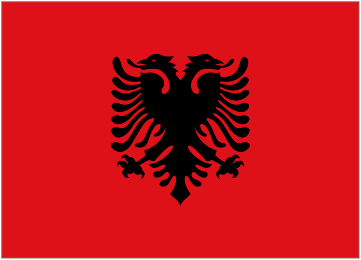 October 2004 - Hague Appeal for Peace, Tirana (Albania). Conference "where a group of educators came together with representatives of ministries of education and issued a Tirana Call for Peace Education." October 2004 - Hague Appeal for Peace, Tirana (Albania). Conference "where a group of educators came together with representatives of ministries of education and issued a Tirana Call for Peace Education."
|

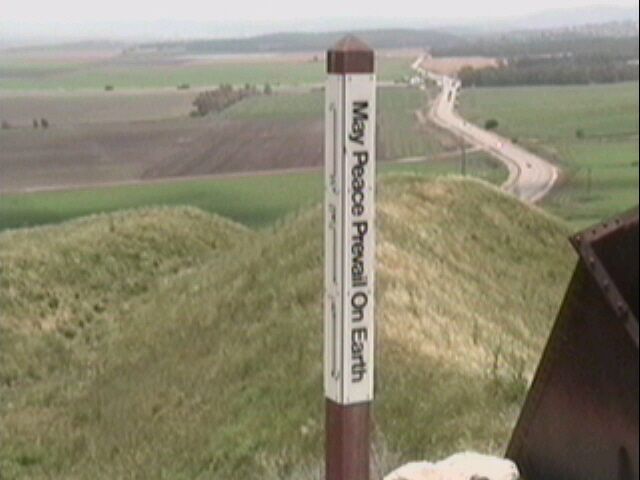
|   1976 - Megiddo Peace Table, Ann Arbor, Michigan (USA).
"Served as the opening peace table at the 1999 Hague Appeal for Peace, the world's largest ever peace meeting. Noble peace prize winners Desmond Tutu, Rigoberta Menchu Tum & Jose Ramos Horta sat around the table, moderated by David Andrews of Ireland, and talked of what they had learned in their peace efforts in South Africa, Guatemala & East Timor. The table served in the room where different meetings discussed small arms dealing, child soldiers, nuclear weapons, the war in the Sudan & two sessions on Jerusalem." Activist Alan Haber & his wife Odile Hugonot Haber propose "to take the peace table to a peace meeting" in Megiddo (Israel).
Bottom image is sight from Hill of Megiddo (Har Megiddo = Armageddon), ancient crossroads of Egypt, Europe & Persia, a hoped-for location of the Peace Table. 1976 - Megiddo Peace Table, Ann Arbor, Michigan (USA).
"Served as the opening peace table at the 1999 Hague Appeal for Peace, the world's largest ever peace meeting. Noble peace prize winners Desmond Tutu, Rigoberta Menchu Tum & Jose Ramos Horta sat around the table, moderated by David Andrews of Ireland, and talked of what they had learned in their peace efforts in South Africa, Guatemala & East Timor. The table served in the room where different meetings discussed small arms dealing, child soldiers, nuclear weapons, the war in the Sudan & two sessions on Jerusalem." Activist Alan Haber & his wife Odile Hugonot Haber propose "to take the peace table to a peace meeting" in Megiddo (Israel).
Bottom image is sight from Hill of Megiddo (Har Megiddo = Armageddon), ancient crossroads of Egypt, Europe & Persia, a hoped-for location of the Peace Table.  
| 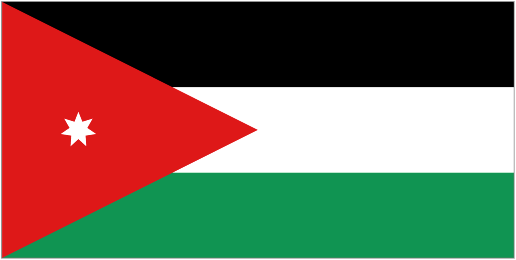 1999 - Seventh World Conference, World Conference of Religions for Peace (WCRP), Amman (Jordan). 1999 - Seventh World Conference, World Conference of Religions for Peace (WCRP), Amman (Jordan).
 

| F
E
S
T |  August 16-21, 2005 - Weltjuendtag / World Youth Day, Koln/Cologne (Germany). World Youth Day was a Catholic youth festival which took place in the Archdiocese of Cologne. Advance meetings were held August 11-15 in all German dioceses. Right image shows a peace mural painted for the occasion in an underpass at the Banhhof / Train Station in Kelsterbach near Frankfurt Airport.
It contains the word "peace" in 20 different languages and hands colored as the flags of many nations. (Only one of four sections is shown in the image.) August 16-21, 2005 - Weltjuendtag / World Youth Day, Koln/Cologne (Germany). World Youth Day was a Catholic youth festival which took place in the Archdiocese of Cologne. Advance meetings were held August 11-15 in all German dioceses. Right image shows a peace mural painted for the occasion in an underpass at the Banhhof / Train Station in Kelsterbach near Frankfurt Airport.
It contains the word "peace" in 20 different languages and hands colored as the flags of many nations. (Only one of four sections is shown in the image.)
|


 | C
O
N
F |   December 10, 2005 - International Peace Conference, Royal Agricultural Hall, London (England). An anti-war conference organised by the Stop the War Coalition (StWC). Included speakers from Iraq, the USA & Italy.
1,500 tickets were sold out a week before its occurrence, leaving many people who wished to attend the conference disappointed. December 10, 2005 - International Peace Conference, Royal Agricultural Hall, London (England). An anti-war conference organised by the Stop the War Coalition (StWC). Included speakers from Iraq, the USA & Italy.
1,500 tickets were sold out a week before its occurrence, leaving many people who wished to attend the conference disappointed.
|  2006 - Eighth World Conference, World Conference of Religions for Peace (WCRP), Kyoto (Japan). 2006 - Eighth World Conference, World Conference of Religions for Peace (WCRP), Kyoto (Japan).



| E
L
D
E
R
S |  2007 - "The Elders" (or the Global Elders) is an international non-government organisation of public figures noted as elder statesmen, peace activists, and human rights advocates, brought together by Nelson Mandela in 2007. The goal of the group is to solve global problems, using 'almost 1,000 years of collective experience' to work on solutions for seemingly insurmountable problems like climate change, HIV/AIDS, and poverty, as well as to 'use their political independence to help resolve some of the world's most intractable conflicts.'" Click here for Wikipedia article. 2007 - "The Elders" (or the Global Elders) is an international non-government organisation of public figures noted as elder statesmen, peace activists, and human rights advocates, brought together by Nelson Mandela in 2007. The goal of the group is to solve global problems, using 'almost 1,000 years of collective experience' to work on solutions for seemingly insurmountable problems like climate change, HIV/AIDS, and poverty, as well as to 'use their political independence to help resolve some of the world's most intractable conflicts.'" Click here for Wikipedia article.
|

| C
O
N
F |  November 23-December 2, 2007 - International Islamic Peace Conference & Exposition, Somaiya Ground, Sion, Mumbai (India). Held annually since 2007 at same location. Organized by Zakir Naik, "founder and president of the Islamic Research Foundation (IRF), which is a non-profit organization that owns Peace TV channel based in Mumbai. A prominent Muslim figure in the Muslim world, Zakir Naik is also a public speaker, apologist, and a writer on the subject of Islam and other comparative religion." Click here for 9-minute video. November 23-December 2, 2007 - International Islamic Peace Conference & Exposition, Somaiya Ground, Sion, Mumbai (India). Held annually since 2007 at same location. Organized by Zakir Naik, "founder and president of the Islamic Research Foundation (IRF), which is a non-profit organization that owns Peace TV channel based in Mumbai. A prominent Muslim figure in the Muslim world, Zakir Naik is also a public speaker, apologist, and a writer on the subject of Islam and other comparative religion." Click here for 9-minute video.
|


 | C
O
N
F | 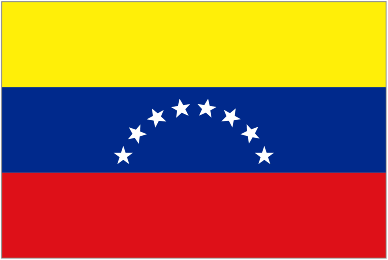 April 8-13, 2008 - World Peace Conference / Conferencia Mundial de la Paz, Caracas (Venezuela). "Caracas, the newly decreed world capital of peace and anti-imperialist struggle, played host to the World Peace Council (WPC) April 8-13, 2008. The week began with a meeting of the WPC Executive Committee, followed by two days of the Assembly of the WPC, two days of WPC Conferences and concluding with a day of action in solidarity with the people of the Bolivarian Republic of Venezuela, falling on the sixth anniversary of the attempted 2002 coup d'etat. The event, considered a rousing success, drew 265 delegates and 285 participants from 124 organizations representing 76 countries, culminating with a street demonstration of approximately 200,000 people on the thirteenth. The host organization, the Committee for International Solidarity of Venezuela (COSI), and the Venezuelan government went out of their way ensuring that the event was successful providing all the facilities, translators, meals and hotel rooms for their guests. In exchange, those who were lucky enough to attend left with a renewed optimism in the strength of the world movement for peace." April 8-13, 2008 - World Peace Conference / Conferencia Mundial de la Paz, Caracas (Venezuela). "Caracas, the newly decreed world capital of peace and anti-imperialist struggle, played host to the World Peace Council (WPC) April 8-13, 2008. The week began with a meeting of the WPC Executive Committee, followed by two days of the Assembly of the WPC, two days of WPC Conferences and concluding with a day of action in solidarity with the people of the Bolivarian Republic of Venezuela, falling on the sixth anniversary of the attempted 2002 coup d'etat. The event, considered a rousing success, drew 265 delegates and 285 participants from 124 organizations representing 76 countries, culminating with a street demonstration of approximately 200,000 people on the thirteenth. The host organization, the Committee for International Solidarity of Venezuela (COSI), and the Venezuelan government went out of their way ensuring that the event was successful providing all the facilities, translators, meals and hotel rooms for their guests. In exchange, those who were lucky enough to attend left with a renewed optimism in the strength of the world movement for peace."
|
 | C
O
N
F
|  December 8, 2009 - - Parliament of the World’s Religions, Melbourne Convention Centre, Melbourne, Victoria (Australia). Image shows peace pole used as part of a World Peace Prayer Ceremony for "Reconciliation Among Religions & Peace Among Nations." December 8, 2009 - - Parliament of the World’s Religions, Melbourne Convention Centre, Melbourne, Victoria (Australia). Image shows peace pole used as part of a World Peace Prayer Ceremony for "Reconciliation Among Religions & Peace Among Nations."
|



| S
U
M
M
I
T |
  April 12-13, 2010 - Nuclear Security Summit, Walter E. Washington Convention Center, Washington, DC (USA). Largest gathering of heads of state called by a US president since the San Francisco conference in 1945 (qv). Attended by 38 heads of state or government, 9 other governments, the European Union, the International Atomic Energy Agency & the United Nations. Focused on how to better safeguard weapons-grade plutonium & uranium to prevent nuclear terrorism. Described by The Washington Post as having the greatest concentration of security in Washington since the inauguration of Barack Obama. An area of several city blocks surrounding the site of the Summit was closed to traffic & parking.
April 12-13, 2010 - Nuclear Security Summit, Walter E. Washington Convention Center, Washington, DC (USA). Largest gathering of heads of state called by a US president since the San Francisco conference in 1945 (qv). Attended by 38 heads of state or government, 9 other governments, the European Union, the International Atomic Energy Agency & the United Nations. Focused on how to better safeguard weapons-grade plutonium & uranium to prevent nuclear terrorism. Described by The Washington Post as having the greatest concentration of security in Washington since the inauguration of Barack Obama. An area of several city blocks surrounding the site of the Summit was closed to traffic & parking.
|
Please email your comments & questions to geovisual @ comcast.net. Thank you.
Click here to return to main page.
| 

Switzerland emerged as the primary conference venue (at least 14 conferences), followed by the
United Kingdom (13), the
United States (12),
France (10),
Netherlands (9),
Belgium (5), and
Germany (5).
Henri Durant (1901) |
Frédéric Passy (1901) |
Charles Albert Gobat (1902) |
Élie Ducommun (1902) |
William Randal Cremer (1903) |
Bertha von Suttner (1905) |
Fredrik Bajer (1908) |
Auguste Beernaert (1909)|
Paul-Henri-Benjamin d'Estournelles de Constant (1909) |
Tobias Asser (1911) |
Alfred Hermann Fried (1911) |
Elihu Root (1912) |
Henri La Fontaine (1913) |
Christian Lange (1921) |
Austen Chamberlain (1925) |
Aristide Briand (1926) |
Gustav Stresemann (1926) |
Ferdinand Buisson (1927) |
Frank Kellogg (1929) |
Nathan Söderblom (1930) |
Jane Addams (1931) |
Nicholas Murray Butler (1931) |
Cordell Hull (1945) |
Emily Greene Balch (1946) |
John R. Mott (1946).








![]() 1815-1828 - First incarnation of the New York Peace Society. "The first peace society to be established in the USA.
David Low Dodge [1774-1852] founds the society in 1815, soon after the end of the War of 1812. It became an active organization, holding regular weekly meetings & producing literature which is spread as far as Gibraltar & Malta, describing the horrors of war & advocating pacificism on Christian grounds. The society will have four different incarnations, as it has merged into other organizations or dissolved & then been re-created." See 1828 below.
1815-1828 - First incarnation of the New York Peace Society. "The first peace society to be established in the USA.
David Low Dodge [1774-1852] founds the society in 1815, soon after the end of the War of 1812. It became an active organization, holding regular weekly meetings & producing literature which is spread as far as Gibraltar & Malta, describing the horrors of war & advocating pacificism on Christian grounds. The society will have four different incarnations, as it has merged into other organizations or dissolved & then been re-created." See 1828 below.




1820 -
"In France, the early pacifist movements were initially based either on moral considerations, as in the case of the Société de la Morale chrétienne, founded in 1820, or on the theories of Utopian socialism put forward by Henri de Saint-Simon [1760-1825] and Charles Fourier [1772-1837]." [André Durand, 1996]









April 17, 1839 - The Anti-Slavery Society, London (England). Formed by Thomas Clarkson [1760-1846] & other abolitionists to campaign against slavery worldwide. Today known as Anti-Slavery International.



1843 - 2nd World Anti-Slavery Convention, Brussels (Belgium).







July 1851 -
4th International Peace Congress, London (England).

October 1853 -
6th International Peace Congress, Edinburgh (Scotland). Why did this series of International Peace Congresses end in 1853? No peace conference held again in the UK until 1890?


June 24, 1859 - Battle of Solferino Solferino (Italy). "Resulted in victory of the allied French Army under Napoleon III & Sardinian Army under Victor Emmanuel II (together known as the Franco-Sardinian Alliance) against the Austrian Army under Emperor Franz Joseph I. The last major battle in world history where all the armies were under the personal command of their monarchs. Perhaps 300,000 soldiers fought in this important battle, the largest since the Battle of Leipzig in 1813. There were about 130,000 Austrian troops and a combined total of 140,000 French and allied Piedmontese troops." /// Suffering witnessed by Henry Durant [1828-1910], leading to the creation of the Red Cross in Geneva (Switzerland).







May 17, 1865 - International Telegraph Union, Berne (Switzerland). One of the first 8 international organizations, according journalist to W.T Stead (1898), and one of four to be in Berne. Now called the International Telecommunication Union (ITU) and headquarted in Geneva.
May 30, 1867 - Frédéric Passy [1822-1912] announces in Paris the establishment of a new society, the Ligue internationale et permanente de la Paix. "The new society, considering that wars ran clearly counter to the trends of civilization, referred first of all to the balance of European powers, which had the duty of abstaining from any attack upon or threat against other nations. In order to uphold and propagate the great principles of mutual respect, which in Passy's opinion should thenceforth constitute the common charter of humankind, he appealed for the support of all men of good will in every country. Gustave Moynier is a founding member." [André Durand, 1996] /// "President in 1867, French lawyer, notary & writer Émile Arnaud [1864-1921] will -- in 1901 -- propose the term 'pacifism' to summarize the various currents & intellectual positions of the peace movement in general."
September 9, 1867 - Pacifist Congress, Electoral Building, Geneva (Switzerland).
"On the initiative of the philosopher Charles Lemonnier, a follower of Henri de Saint-Simon [1760-1825], [a group of French pacifists] convene a pacifist congress in Geneva in September 1867, with objectives and means that differed substantially from those proposed by Frédéric Passy [1822-1912]: 'The aim of the Geneva Congress is to determine the political and economic conditions required for peace among peoples, and in particular for the establishment of the United States of Europe. It aspires to be the conference of European democracy, expressing through its most authorized spokesmen the elements of this great solution and sounding, in the name of the immortal principles of the French Revolution, the signal for consciences to awake: it is time for democracy to stand up and show itself.'" [André Durand, 1996] The International League of Peace & Liberty organised a series of international peace congresses: 1867 - 1st congress, Geneva (Switzerland). 1873 - 2nd congress. 1889 - 3rd congress.



September 1872 - Hague Congress,
The Hague (Netherlands). The 5th congress of the International Workingmen's Association (IWA). Famous for the expulsion of the anarchists Mikhail Bakunin [1814-1876] and James Guillaume [1844=1916] for clashing with Marx and his followers over the role of politics in the IWA. The congress marks the end of this organization as a unitarian alliance of all socialist factions (Anarchists and Marxists). Anarchists consider the congress null and void. The IWA "was not able to withstand the differences between anarchist and Marxist currents, with the anarchists largely withdrawing after the Hague Congress of 1872. And the First International had wound down entirely by 1876, leading to several attempts to start specifically anarchist Internationals, notably the Anarchist St. Imier International. However the collapse of the Paris Commune in 1871 proved a major setback for the movement, and the rise of "Propaganda of the deed" meant that serious moves to establish an anarcho-syndicalist international would not begin until the early 20th century." [Wikipedia]
1874 - The Congress for Peace and Liberty met again in Geneva (Switzerland). Victor Hugo, who was invited to attend, this time declined the invitation. He added new reservations to those he had already expressed in 1869. Meanwhile, there had been the Franco-Prussian war, the invasion of France, and the loss of two provinces. Reparation was required. Hence the prime issue was no longer peace, but justice. 'All fraternities are adjourned; where there was hope, there is now menace: we are faced with a whole series of disasters, each of which gives rise to another and must be seen through; there is no stopping now.'" [André Durand, 1996]


May 20, 1875 - International Bureau of Weights and Measures (BIPM), Paris (France). One of the first 8 international organizations, according to journalist W.T Stead (1898). "Based at the Pavillon de Breteuil in Sèvres (France), a 4.35 ha site (originally 2.52 ha) granted to the Bureau by the French Government in 1876, where it enjoys extraterritorial status."


1882 -
Peace Conference, Brussels (Belgium). Attended by over 500 delegates from many countries. British delegation led by Hodgson Pratt [1824-1907]. Nothing found about this conference except reference in website about Hodgson Pratt.
1883 - "Bureau which looks after Trademarks and Patents ("intellectural property"), Berne (Switzerland). One of the first 8 international organizations, according to journalist W.T Stead (1898), and one of four to be in Berne. "Its function exended to deal with copyrights in 1886."

1887 - Unione Lombarda per la Pace e l'Arbitrato / Lombard Association for Peace & Arbitration founded in Italy by Ernesto Teodoro Moneta [1833-1918]. The association called for disarmament and envisaged the creation of a League of Nations.
![]() March-April 1888 - Conference sponsored by the International Council of Women (ICW), Washington, DC (USA). The ICW was the first women's organization to work across national boundaries for the common cause of advocating human rights for women. In March-April 1888, women leaders came together with 80 speakers & 49 delegates representing 53 women's organizations from 9 countries: Canada, USA, Ireland, India, England, Finland, Denmark, France & Norway. "Rachel Foster Avery [1858-1919] planned much of the first ICW, & Susan B. Anthony [1820-1906] presided over 8 of the 16 sessions."
March-April 1888 - Conference sponsored by the International Council of Women (ICW), Washington, DC (USA). The ICW was the first women's organization to work across national boundaries for the common cause of advocating human rights for women. In March-April 1888, women leaders came together with 80 speakers & 49 delegates representing 53 women's organizations from 9 countries: Canada, USA, Ireland, India, England, Finland, Denmark, France & Norway. "Rachel Foster Avery [1858-1919] planned much of the first ICW, & Susan B. Anthony [1820-1906] presided over 8 of the 16 sessions."
October 31, 1888 - Inter-Parliamentary Union (IPU), Grand Hôtel, Paris (France). "[The IPU] grew out of a meeting between British & French legislators in Paris in 1888. They agreed to meet on an annual basis & invited legislators from other nations with constitutional forms of government to future conferences to advocate the adoption of arbitration agreements & other pacifist measures in national legislation. Frédéric Passy [1822-1912], Charles Albert Gobat [1843-1914], Bertha von Suttner [1843-1914], Alfred Hermann Fried [1864-1921], and Henri La Fontaine [1854-1943] played major roles in these organizations." Click here for more information.


















September 17-22, 1896 - 7th Universal Peace Congress, Budapest (Hungary).
December 10, 1896 - Death of Alfred Nobel, San Remo (Italy). Alfred Nobel [1833-1896] was a Swedish chemist, engineer, innovator, armaments manufacturer, and inventor of dynamite. In his last will, he used his enormous fortune to institute the Nobel Prizes. His memorial service was conducted by Nathan Söderblom [1866-1931] who knew Nobel in Paris and would later become professor of the history of religions in Leipzig (Germany) & archbishop of Uppsala (Sweden). The first Nobel Peace Prize was awarded in 1901.









1901 - Émile Arnaud proposes the term "pacifism" to summarize the peace movement in general. P

April 2-6, 1902 - 11th Universal Peace Congress, Monaco. Among other business, "passed a vote of congratulation to Frau [Professor] Selenka of Munich and Mrs. May Wright Sewell, of Indianapolis, for their work in organizing an annual celebration by the International Council of Women of the meeting of the Hague Peace Conference [in 1899]."


1902 - Arbitrage entre les Etas-Unis d"Amerique et les Etats-Unis Mexicans, The Hague (Netherlands).
September 22-27, 1903 - 12th Universal Peace Congress, Rouen (France).



![]() October 3-8, 1904 - 13th Universal Peace Congress, Tremont Temple, Boston, Massachusetts (USA). Official report available on-line at Google Books. Bertha von Suttner attends the congress in Boston, followed by her first lecture tour in the United States, during which she meets President Theodore Roosevelt and visits Quaker communities that offer an inspiring example of life devoted to non-violence.
October 3-8, 1904 - 13th Universal Peace Congress, Tremont Temple, Boston, Massachusetts (USA). Official report available on-line at Google Books. Bertha von Suttner attends the congress in Boston, followed by her first lecture tour in the United States, during which she meets President Theodore Roosevelt and visits Quaker communities that offer an inspiring example of life devoted to non-violence.


September 19-23, 1905 - 14th Universal Peace Congress, Luzern/Lucerne (Switzerland). Among other business, the Congress "urges the methodical teaching of the principles of peace...and that the anniversry of the 18th of May [First Hague Peace Conference] be celebrated in all the schools." Delegates undoubtedly visit the International Museum of War & Peace.











1909 - The Great Illusion". A book by Norman Angell [1872-1967], first published under the title "Europe's Optical Illusion.' Republished in 1910 & subsequently in various enlarged & revised editions under the title 'The Great Illusion.' Angell's main argument was that war between industrial countries was futile because conquest did not pay. Moreover, if a conquering power confiscated property in the territory it seized, 'the incentive to produce [of the local population] would be sapped & the conquered area be rendered worthless. Thus, the conquering power had to leave property in the hands of the local population while incurring the costs of conquest & occupation.'" Angell was awarded the Nobel Peace Prize in 1933.








April 15, 1912 - RMS Titanic sinks in the North Atlantic Ocean after colliding with an iceberg during her maiden voyage from Southampton (England) to New York City (USA). British journalist & peacemaker William Thomas Stead [1849-1912] is drowned while en route to the "Congress of the Men and Religion Forward Movement" (qv). Stead published a daily account ("Chronique de la Conference de la Paix") in the "Dagblad" newspaper during the First Hague Peace Conference in 1907. Identical monuments will be erected for him in London & in New York City.


.png)

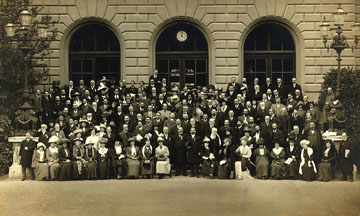





August 18-23, 1913 - XXe Congrès universel de la paix / 20th Universal Peace Congress, Salle des Comtes/Hall of Knights, The Hague (Netherlands). "Sous la haute protection de S.A.R. le prince Henri des Pays-Bas, Duc de
Mecklembourg." Attended by "500 pacifists," including Bertha von Sutner [1843-1914] & Henri Mandere [1883-1959], among others. A visit to the Peace Palace (not yet formally open) is a special event on the conference programme.

1913 - 18th Conference, Interparliamentary Union, Salle des Comtes/Hall of Knights, The Hague (Netherlands).
March 16, 1914, Bern (Switzerland) - "Charles Gobat [1843-1914] - Nobel Peace Prize 1902 - died while attending meeting of the peace conference at Bern, he arose as if to speak but collapsed, dying about an hour later."























July 10-17. 1921 - 3rd International WILPF Congress, Vienna (Austria).
August 10-13, 1921 - 21th Universal Peace Congress, Luxembourg.


July 25-29, 1922 - 22nd Universal Peace Congress, London (England).

October 2-8, 1924 - 23rd Universal Peace Congress, Berlin (Germany).




September 1-6, 1925 - 24th Universal Peace Congress, Paris (France).

1926 - First Congress of the International Paneuropean Union, Vienna (Austria). Also called the Paneuropean Movement & the Pan-Europa Movement (not to be confused with the European Union). Organized & led for 49 years by count, geopolitician & philosopher Richard Nikolaus Coudenhove-Kalergi [1894-1972]. His first book, titled "Pan-Europa," was published in 1923 & contained a membership form for the Pan-Europa movement. In 1927, Aristide Briand was elected honorary president. Personalities attending included: Albert Einstein, Thomas Mann & Sigmund Freud.
August 28-September 3, 1926 - 25th Universal Peace Congress, Geneva (Switzerland).
Spring 1927 - First Geneva Naval Conference, Geneva (Switzerland). Held to discuss naval arms limitation




1928-1937 - On 11 October 1928, a Graf Zeppelin airship begins the first non-stop transatlantic passenger flights, leaving Friedrichshafen (Germany) & arriving at NAS Lakehurst, New Jersey (USA), on 15 October. In 1936, the Hindenburg enters passenger service & makes 36 crossings of the North & South Atlantic. Both routes operated a regularly scheduled timetable until the cessation of passenger Zeppelin operations following the Hindenburg disaster in May 1937. Regularly scheduled transatlantic service by commercial airplanes does not begin until immediately after World War II.
October 6-10, 1929 - 27th Universal Peace Congress, Athens (Greece). Also called the "Congress of Universal Peace."




July 5-10, 1931 - 28th Universal Peace Congress, Brussels (Belgium).


September 4-9, 1932 - 29th Universal Peace Congress, Vienna (Austria).








August 5-7, 1933 - World Congress of Youth Against War & Fascism, Paris (France). "Organized by the International & American Committees for Struggle Against War controlled by Moscow's communist Intl. Leaque Against Imperialism leaders, who organized the World Congress Against War at Amsterdam & its successors."
![]() September 29-October 1, 1933 - United States Congress Against War, New York City, New York (USA). During which the program of the American League Against War & Fascism (ALAWF) was adopted.
September 29-October 1, 1933 - United States Congress Against War, New York City, New York (USA). During which the program of the American League Against War & Fascism (ALAWF) was adopted.
September 1-6, 1934 - 30th Universal Peace Congress, Locarno (Switzerland).



June 13-19, 1936 - 31st Universal Peace Congress, Cardiff (Wales).



August 24-29, 1937 - 32nd Universal Peace Congress, Paris (France). Held during the Exposition Internationale des Arts et Techniques dans la Vie Moderne / International Exposition dedicated to Art and Technology in Modern Life (May 25-November 25, 1937) which had a peace pavilion.





August 21-27, 1939 - 33rd Universal Peace Congress, Zurich (Switzerland). The last inter-war congress met at Zurich in August 1939, concluding their meeting four days before the Germans invaded Poland, marking the beginning of World War II. What happened to the Universal Peace Congresses after WW-II?






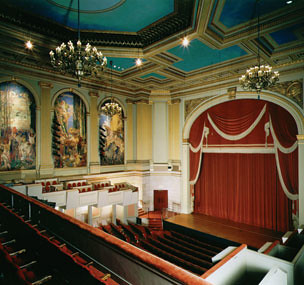













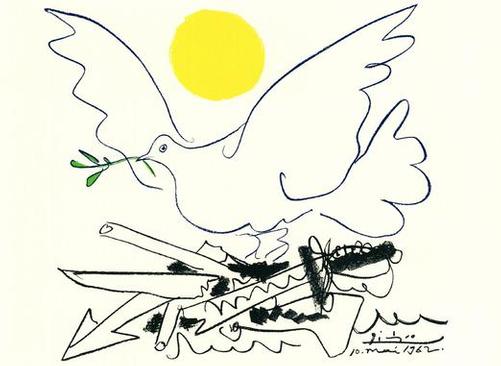
March 1950 - World Peace Council releases the Stockholm Peace Appeal, the petition "that began the international 'Ban the Bomb' movement.'









April 26-July 21, 1954 - Geneva Conference, Geneva (Switzerland). "A conference with two tasks. The first was to try to find a way to unify Korea. The second task was to discuss the possibility of restoring peace in Indochina."


July 18, 1955 - Geneva Summit, Geneva (Switzerland). "July 18th, 1955 in Geneva, Switzerland. "A meeting of 'The Big Four:' President Dwight D. Eisenhower of the United States, Prime Minister Anthony Eden of Britain, Premier Nikolai A. Bulganin of the Soviet Union, and Prime Minister Edgar Faure of France."




1958 - Geneva Conference, Geneva (Switzerland). No Wikipedia article on this conference.



1961 - First WILPF conference of Soviet & American women to help break down cold war barriers.
Where held? Click this web page for references to other conferences of the Women's International League
for Peace & Freedom (WILPF).
![]()


Late 1973 - Geneva Conference, Geneva (Switzerland). "An attempt to negotiate a solution to the Arab-Israeli conflict as envisioned in UN Security Council Resolution 338 following the called-for cease-fire to end the Yom Kippur War [October 6-25, 1973]."
1974 - Second World Conference, World Conference of Religions for Peace (WCRP), Leuven (Belgium).

1978 - First Special Session on Disarmament of the UN General Assembly. "Established the Conference on Disarmament (CD) as the single multilateral disarmament negotiating forum of the international community. The CD succeeded other Geneva-based negotiating fora, including the Ten-Nation Committee on Disarmament (1960), the Eighteen-Nation Committee on Disarmament (1962-68), and the Conference of the Committee on Disarmament (1969-78).
The current Director-General of the UN Office in Geneva (UNOG) is the Secretary-General of the CD as well as the Personal Representative of the UN Secretary-General to the CD."


1979? - 3rd World Conference, World Conference of Religions for Peace (WCRP), Princeton, New Jersey (USA).


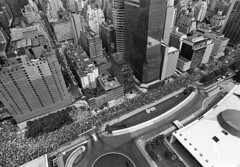
1984 - Fourth World Conference, World Conference of Religions for Peace (WCRP), Nairobi (Kenya).




1989 - Fifth World Conference, World Conference of Religions for Peace (WCRP), Melbourne, Victoria (Australia).

1994 - Sixth World Conference, World Conference of Religions for Peace (WCRP), Riva del Garda (Italy).












1999 - Seventh World Conference, World Conference of Religions for Peace (WCRP), Amman (Jordan).







2006 - Eighth World Conference, World Conference of Religions for Peace (WCRP), Kyoto (Japan).



